

Tell us your story, and we’ll tell the world.
Africa Outlook, APAC Outlook, EME Outlook and North America Outlook are digital and print publications aimed at boardroom and hands-on decision-makers, reaching an audience of more than 800,000 people around the world; spanning the full range of industrial sectors.



With original and exclusive content compiled by our experienced editorial team, we look to promote the latest in engaging news, industry trends and success stories from across the globe.

Your company can join the leading industry heavyweights enjoying the free exposure we provide across both digital and print platforms with a free marketing brochure, extensive social media saturation, enhanced B2B networking opportunities, and a readymade forum to attract new investment and to help you grow your business.
Visit www.outlookpublishing.com/work-with-us for details on how your company can feature for free in one of our upcoming editions.



www.outlookpublishing.com/work-with-us


EDITORIAL
Editor: Phoebe Harper phoebe.harper@outlookpublishing.com
Senior Editor: Sean Galea-Pace sean.galea-pace@outlookpublishing.com
Editor: Marcus Kääpä marcus.kaapa@outlookpublishing.com
PRODUCTION
Production Director: Stephen Giles steve.giles@outlookpublishing.com
Senior Designer: Devon Collins devon.collins@outlookpublishing.com
Junior Designer: Matt Loudwell matt.loudwell@outlookpublishing.com
BUSINESS
Managing Director: Ben Weaver ben.weaver@outlookpublishing.com
Sales Director: Nick Norris nick.norris@outlookpublishing.com

Operations Director: James Mitchell james.mitchell@outlookpublishing.com
TRAVEL GUIDES
Sales Manager: Krisha Canlas krisha.canlas@outlookpublishing.com
Sales Manager: Matt Cole-Wilkin matt.cole-wilkin@outlookpublishing.com
ADMINISTRATION
Finance Director: Suzanne Welsh suzanne.welsh@outlookpublishing.com
Office Manager: Daniel George daniel.george@outlookpublishing.com
CONTACT
Outlook Travel magazine
East Wing, Ground Floor, 69-75 Thorpe Road, Norwich, Norfolk, NR1 1UA, United Kingdom.
Sales: +44 (0) 1603 959 652
Editorial: +44 (0) 1603 959 657
SUBSCRIPTIONS
Tel: +44 (0) 1603 959 657 sean.galea-pace@outlookpublishing.com www.outlooktravelmag.com
Twitter: @outlooktravel1
Instagram: www.instagram.com/outlooktravelmagazine
Linkedin: www.linkedin.com/showcase/outlook-travel-magazine
Facebook: facebook.com/outlooktravelmag
NEW YEAR, NEW BEGINNINGS
As the new editor for Outlook Travel, I am beyond excited to introduce our first issue of 2021. Ever optimistic, our theme for this issue comes courtesy of Dictionary Corner, and Countdown’s word of the day‘respair’. A 16th century term that has fallen out of use meaning ‘fresh hope and a recovery from a despair’. We endeavour to bring this back into circulation. Although the light at the end of the tunnel may seem distant as ever, the travel industry refuses to lose hope.
For our regular travel business feature, we speak with Trippers, an exciting new app designed to streamline the process of group travel planning.
In our travel news pages, learn how airlines and hotels are adapting to the pandemic. Meanwhile on home shores, our one-off column on armchair escapism features an exciting new Virtual Touring company, while local filmmaker and cameraman Josh Trett takes the spotlight in Behind the Lens with the inspiring story of how he turned his passion into a successful company.
Fuel your wanderlust in our comprehensive travel guides, including under the radar destinations such as Quintana Roo and Lesotho, to ultimate holiday destinations such as the Maldives. Many of the countries featured pertain to our theme by having rebirth in their very nature, having overcome crises and natural disasters, such as Nepal, thus reminding us of the possibility to rise again from the ashes and the resilience of tourism. This too, shall pass.
Reflecting on travels past, read about how to spend a weekend in Seville, where the orange serves as a hopeful symbol of happiness. For those who take pride in their tipple, enjoy some light-hearted distraction as we showcase five of our favourite breweries around the world, before escaping from it all in The Last Stop on the distant shores of Madagascar.
Finally, we would like to express our gratitude to all those who helped contribute to our fourth edition of Outlook Travel and took the time to speak with us. We hope that you enjoy the issue.

Phoebe Harper Editor Outlook Travel

Join
Discover the power of mobile engagement with Outlook Travel magazine’s social media platforms.



Our Instagram feed showcases inspiring photographs of the destinations we cover, as well as featuring shots of our favourite hand-selected hotels.



Meanwhile, our Twitter feed keeps you up-to-date with the latest travel news and provides you with a dedicated network of travel professionals to connect with. You can also find us on Facebook and LinkedIn.





UNITED COULD MAKE COVID-19 VACCINE A REQUIREMENT
UNITED IS CONSIDERING making the COVID-19 vaccine a requirement for all its employees.

With more than 88,000 employees, the organisation is one of the sector’s leading employers. Despite furloughing 13,000 employees as government aid stopped last October, United recalled those employees as a result of a second round of funding in December.
“I know the vaccines are safe. I know that it’s the way to ensure the safety of our employees and our customers as we fly around the world,” Kirby told staff at a virtual town hall. “So, if others go along and are willing to begin to mandate vaccines, you should probably expect United to be one of the first companies to do that.”
HOTEL EXPANSION INTO FRANCE
INTERCONTINENTAL HOTELS
GROUP is set to unveil its Kimpton brand in France as a result of the opening of a 149-room hotel in Paris’ Opera district.

The property will be situated inside the converted Samaritaine de Luxe department store on Boulevard des Capucines.
The facilities are expected to include 24 suites, an indoor swimming pool, gym, spa, a Californian-inspired restaurant and bar, in addition to a 10th floor rooftop terrace bar with 360-degree views of the city.
With the building’s 1917 Art Nouveau façade having already been restored as well as the property’s staircase and elevator, the interiors have been inspired by 1930s Art Deco, with rooms featuring balconies, floor-to-ceiling windows and thoughtfully-selected works of art.
BOEING IN SIGNIFICANT SUSTAINABILITY DRIVE
BOEING HAS OUTLINED its intention to make all new commercial aircraft deliveries capable and certified to fly on 100 percent sustainable aviation by 2030.
The current rules restrict aircraft to fly through a maximum of a 50/50 blend of sustainable aviation fuels (SAFs) and conventional jet fuel, with Boeing confirming that its ambitious
target would “advance the long-term sustainability of commercial aviation.”
The aerospace manufacturing giant warned that for the aviation sector to decrease carbon emissions by 50 percent from 2005 levels by 2050, aircraft would need to be capable of flying on 100 percent SAFs well considerably before that date.

LUFTHANSA TO LAUNCH NEW ON-BOARD FOOD SERVICE

LUFTHANSA HAS CONFIRMED more details about its upcoming buy-on-board food and drink service for economy short and medium-haul passengers. The carrier announced plans to move to a buy-on-board offering in November last year, however, plans to implement the concept in the course of the summer timetable 2021.
TRAVEL
Lufthansa is partnering with two Munich-based firms, Dean and David and Dallamayr. Commenting on the news, Christina Foerster, Executive Board Lufthansa Group Customer, IT and Corporate Responsibility, said: “Our partners Dean and David and Dallmayr represent outstanding quality and responsible action. In addition to the satisfaction of our guests, the topic of responsibility for the environment is also very important to us.
“We almost exclusively use sustainable materials for our packaging. Furthermore, we ensure that less food is wasted through more accurate production. We are pleased to be able to offer our passengers fresh products to European flights that taste delicious.”
EASTERN AIRWAYS ANNOUNCES NEW FRENCH ROUTES
EASTERN AIRWAYS HAS confirmed the arrival of two French routes from Southampton airport this spring.
The regional carrier is set to operate a three times weekly services on former Flybe routes from Southampton to Rennes Bretagne and Nantes Alantique.
Flights to Renne will launch on the 29th April, operating on a Tuesday, Thursday and Sunday while those to Nantes will go live a day later on the 30th April, operating on a Monday, Wednesday and Friday. Both routes will be served by a 72-seat ATR72600 turboprop aircraft.
AVIATION
MELIA
HOTELS INTERNATIONAL IN COVID-19 ANTIGEN TESTING ROLL OUT
MELIA HOTELS
INTERNATIONAL is set to provide free COVID-19 antigen testing for guests at its hotels in Mexico and the Dominican Republic.

The Spanish hotel group will provide its service to guests staying a minimum of three nights that are asked to present results to their country of residence. Guests will be able to book a test at check-in, with tests required to take place 72 hours before departure to ensure that results are available on the day of return.
The resort states that if guests require a PCR test instead of an antigen test, it will arrange logistics and free-of-charge appointment with local testing sites.
Andre Gerondeau, Chief Operating
Officer at Melia Hotels International, commented: “At Melia, we continue to adapt to the new needs of the tourism industry. Guest health and process for our guests remain our top priority and we want to ensure we make this an easy and seamless process for our guests, offering them peace of mind and confidence in their Melia vacation experience.”
AIR ASIA SET TO RESUME MOST OF ITS NETWORK BY END OF 2021
AIR ASIA HAS confirmed it will resume the majority of its route network by the end of the year.
Air Asia CEO, Tony Fernandes, pointed to the company’s strong presence across domestic and regional markets, as well as the low-cost operating model which he believes will drive the airline’s recovery.
Speaking to CNBC as part of the World Economic Forum’s Davos agenda coverage, he said: “It’s been the toughest challenge, but I think the outlook’s getting better.
“The most important thing is there’s a huge amount of demand out there and we just have to wait for borders to open. I think we’re one of the first kinds of businesses that will recover, from an airline perspective, because we’re very strong in domestic and regional.”
THE WORLD’S BEST DISTILLERIES
IN RECENT YEARS, ‘whisky tourism’ has flourished as an industry, with countless distilleries across the globe offering immersive tours and tastings. Whether amateur or connoisseur, there may be nothing better than the pursuit of sampling your favourite tipple straight from the source and observing the process from mash to single malt. This comes at a time when we are being encouraged more than ever to question why it is that we travel and what we seek from our experiences - the perfect tipple seems a good place to start.
And so, with the whisky-swigging Shelby’s set to grace our screens as filming commences for the much-anticipated Peaky Blinders finale, we shine a light on some of the finest distilleries across the globe. Worthy of a pilgrimage in themselves, or as the perfect addition to an itinerary, we have selected five of our favourites notable for their unique location, quirky character and, most importantly, the quality of their produce. Slàinte!
1. PENDERYN DISTILLERY
The ideal option for committed ‘staycationers’, this award-winning producer of single malts can be found nestled in the southern foothills of the Brecon Beacons. Penderyn is attributed with reviving the lost art of distilling in Wales, ever since their first drop landed from the unique single copper-pot still designed by one Dr. David Faraday, a descendant of the renowned scientist. Alongside this inventive piece of machinery that gives the distillery’s output its edge, the Penderyn single malt is also notoriously strong, at 92 percent alcohol before the ageing process commences which lends it a distinctive fruity taste.
Offering hour-long tours that will resume in the near future, the distillery also hosts ‘Whisky and Chocolate’ tastings, a tastebud-tantalising experience that combines Penderyn’s quality single malts with local handmade chocolates.
Where: Penderyn, Brecon Beacons, South Wales, CF44 0SX Web: www.penderyn.wales

2. KYRÖ DISTILLERY COMPANY
Moving on to Northern climes, the Kyrö Distillery can be found in the central Finnish region of Ostrobothnia - yet another reason to visit the land of saunas and the Northern Lights. Surrounded by breath-taking countryside, this distillery prides itself on producing spirits made from 100 percent Finnish wholegrain rye – notorious as the hardest grain to distil. Admirable for both its tenacity and vision, Kyrö began as the dream of four friends whilst enjoying a dram and a sauna session. The result was the first of its kind in Finland, as the only distillery in the country to produce rye whisky. Kyrö also specialise in a range of gins, produced in their abandoned dairy-turned-distillery. Tastings and authentic local dinners are all on offer for any welcome visitor, as is the use of their on-site sauna.
The distillery can be visited virtually when Kyro launch their brand new virtual tour at the end of this month. After a visit to the distillery, you are ideally placed to enjoy a quintessentially Finnish experience, with numerous hiking routes, glacial lakes and idyllic fishing villages all within a short distance.
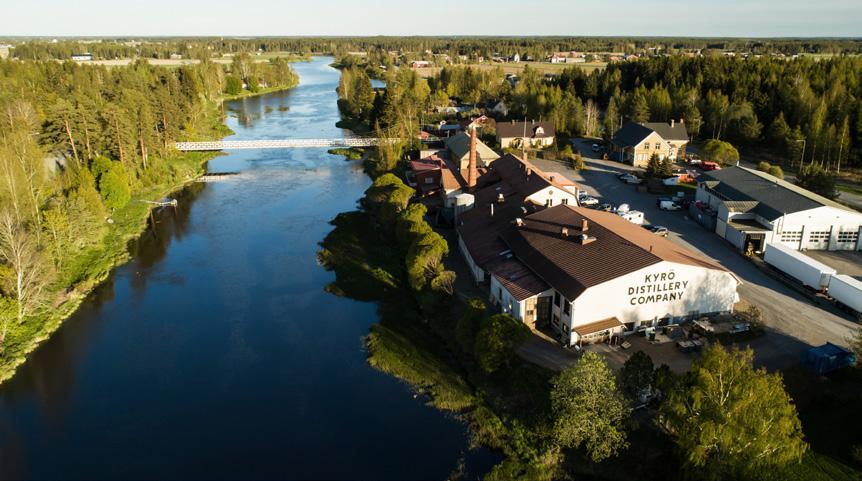
Where: Isokyrö, Ostrobothnia, Finland Web: www.kyrodistillery.com


3. SUNTORY HAKUSHU DISTILLERY




Known as ‘the distillery in the forest’, the Suntory Hakushu Distillery is worth a trip for the serene location alone; envision a pagoda roof poking above the treetops of the forests surrounding snow-capped Mount Kaikoma. The second distillery of Japan’s famous Suntory Group, which was originally founded in their iconic Yamazaki Distillery, Hakushu is the ideal embodiment of the whisky brand’s philosophy; ‘in harmony with people and nature.’ Suntory is the defining name in Japanese whisky and has grown to worldwide renown after humble beginnings in 1899. Nestled amongst the lush foliage of the Hakushu Bird Sanctuary, the distillery offers viewings of the whisky production process. The entire Suntory portfolio is simply waiting to be tasted in the Hakushu Bar, with local pairing dishes available in the stylish ‘White Terrace’ mountain forest restaurant. As one of the highest distilleries in the world, discover why location and climate are so essential in the production of whisky. Visits must be booked in advance.
Where: 2913-1 Torihara, Hakushu-cho, Hokuto-shi, Yamanashi Prefecture Web: www.suntory.com/factory/hakushu
4. LAPHROAIG



Of course, no real discussion of whisky would be complete without mentioning the real mothership – Scotland. Located on the so-called Scotch whisky making capital of the island of Islay, Laphroaig (which translates as ‘broad hollow by the bay’) has followed the same revered process of making whisky for the past 200 years. The same family have been running the distillery since 1815, and proudly continue to uphold the practices and vital ingredients that make their iconic whisky. This includes peat cut by hand, the crucially cool waters of the Kilbride Stream and barley that has been malted on site.
Currently, the distillery can be toured virtually, but when business resumes as normal, we suggest one of their many tours. For the most comprehensive, try the ‘Water to Whisky’ tour, lasting four to five hours. You will experience every aspect of the whisky making process, from cutting the peat to stopping for a dram or two in their iconic warehouse. It may be an arduous journey to reach this remote location, but you will be spoilt by the beauty and nature of this breathtaking island.
Where: Port Ellen, Isle of Islay, PA42 7DU Web: www.laphroaig.com/en
5. WESTLAND DISTILLERY



A Seattle-based micro-brewery, Westland found its feet as an independently owned enterprise with the ambitious pursuit of creating America’s finest single malts. This is no small feat, especially when competing with the titans of the whisky industry that can be found in the southern states of Kentucky and Tennessee. That being said, Westland has become a worthy contender against the Tennessee King, with Master Distiller Matt Hoffman named as American Master Distiller of the Year back in 2018.
Following both traditional whisky-making methods, such as using Sherry wine casks in the maturation process, whilst also pursuing more innovative avenues, Westland makes its mark on the whisky frontiers in true Wild West fashion. With a produce that flourishes under the Pacific Northwest climate in one of the best barley growing regions worldwide, the brewery is currently only open for virtual tours but when circumstances permit, we suggest attending their week-long ‘Peat Week’ celebrations.
Where: First Avenue, South Seattle, Washington 98134 Web: www.westlanddistillery.com
BEHIND THE LENS
An interview with award-winning filmmaker Josh Trett
 Writer: Sean Galea-Pace | Photography: Josh Trett
Writer: Sean Galea-Pace | Photography: Josh Trett
JOSH TRETT WAS practically born with a camera in his hand.
The Norwich-based filmmaker had always dreamed of turning his lifelong hobby into a career and in 2019, Josh made that a reality when he launched his own film and video production company alongside his brother. Since then, he has filmed major projects in Zurich, Malta, Milan and Kansas and produced more than a dozen television adverts. Today, we catch up with Josh to delve deeper behind the lens and find out what he’s got in store for the future.
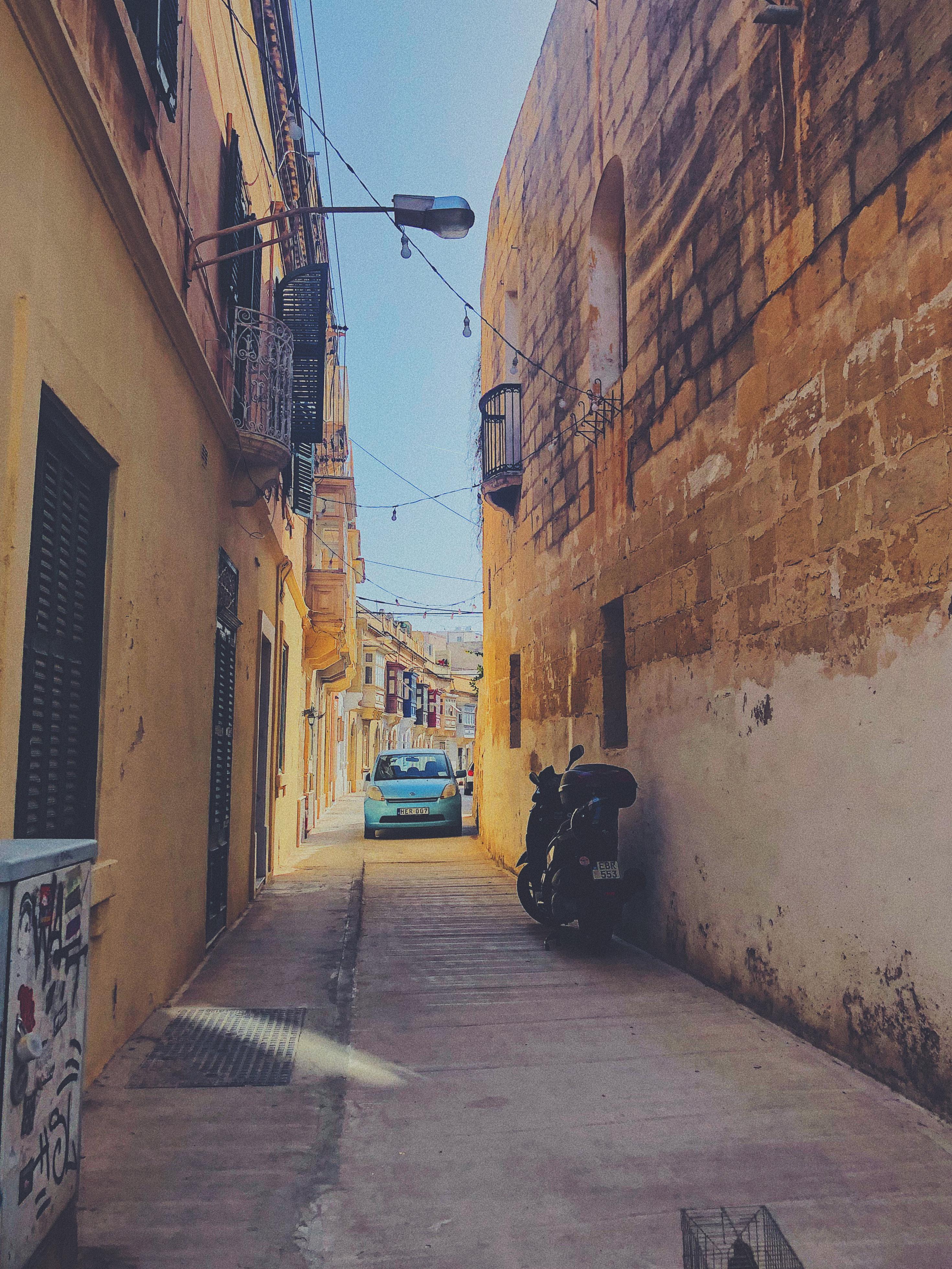
Outlook
Josh Trett (JT): As soon as I understood that it was a possibility to do this as a job, it’s all I wanted to do. To be honest, even if it wasn’t a job, it’s still all I would want to do. When I was younger I was full of creativity
but didn’t know of the correct way to express it - which probably drove my parents a bit mad.
I made dozens of short films in my teens before I studied film production at university. Uni helped me learn to ground my ideas and mature my approach as a storyteller and filmmaker. From there I spent a few years teaching film production but this really wasn’t fulfilling my career goals, so I then went on to work as
a video production manager at an agency before launching my own film and video production company in 2019.
OT: What is it about filmmaking that you enjoy the most? What do you look for when on shoots?
JT: I actually prefer being on set or on location when I’m directing. I love when I’m working with a dedicated

Travel (OT): Can you give us a bit of an insight into your career and how you first became interested in filmmaking? Where did this passion come from?
cast and crew to find the best shot for a scene or the best way to tell that particular story. I know some filmmakers enjoy the writing stage (I really don’t) or post-production stages but for me, it’s always when we’re all there collectively making it happen and you start to see everything fall into place.
I always like to push a cinematic approach on anything I work on. If it’s a television commercial selling a product or it’s a corporate video for an
insurance firm, using techniques from cinema is always better than going for that standard corporate feel. By doing so, you can really enhance the storytelling of that particular project. Why can’t these types of projects look and feel like a high-end documentary or short film?
OT: You’re also an award-winning filmmaker and run your own film company with your brother. What has this venture been like?
JT: It is a bit of a dream come true to be honest. When I first realised I wanted filmmaking to be my career, aside from directing high budget studio films, running my company was the dream. We’ve now been running Trett Films full time for over a year and to maintain and grow the company in its infancy (through the trials

and tribulations of a global pandemic) feels like quite the achievement.
Since we started in 2019, we have produced various corporate videos, we have filmed projects in Zurich, Malta, Milan, and Kansas. We have also developed and produced over 12 TV ads which have aired across multiple Sky channels.

OT: Can you discuss any key projects you’ve been involved in over the past few years?
JT: I’ve been lucky to work on some really interesting projects over the last few years.
Most recently is a TV ad for Archangel Distilleries which aired on Sky through Christmas. I pitched them my idea and they gave us the green light and kind of just told us to go for it. They felt my concept captured their
“SOMETIMES IT FEELS LIKE SUCH A RELIEF TO FINISH A PROJECT, FOR EVERYBODY TO BE HAPPY WITH IT AND RECEIVE POSITIVE FEEDBACK BUT IT’S ONLY A SHORT SPACE OF TIME BEFORE YOU’RE DIVING INTO THE NEXT PROJECT AND WRESTLING MULTIPLE CHALLENGES”
branding and there was a solid story and plenty of intrigue to grab people’s attention. It’s a period piece set in 1908 and follows a man as he travels to Norfolk looking for a missing lover. He catches glimpses of her throughout the ad and she eventually leads him to a church (the product has religious routes) where he finds a bottle of Archangel Gin. It is alluded to that the girl is actually the ‘angel’ from the gin’s branding.
It was quite an ambitious idea. It was a period piece so required a certain amount of research, costume design and screen tests. There were also multiple locations including an empty church and an old moving train which meant various location scouts and vfx were needed to make it authentic and
come to life. There was also an elaborate story which had to be told within 30 seconds and still sell a product, so it was vital to make sure the story beats were tight and the storyboards were detailed.
In 2018 I finished up my short film/ passion project ‘The Black Shuck’. It was a horror film that was inspired by a piece of East Anglian folklore. Rebecca Grant, known for Holby City, Doctors and Stan Lee’s Lucky Man, played the lead and the film went on to win multiple awards. It was a semifinalist at a horror film festival in Moscow. It picked up best sound design at a local film festival in Norwich and Rebecca Grant also won best actress award for another UK film festival.

OT: Having travelled to many different countries for work, what has been your favourite place to capture? What can you tell us about it?
JT: I have travelled and worked in Canada, Hong Kong, France, Germany, Luxembourg, Italy, Malta and Switzerland. I think my favorite place is between Toronto and Hong Kong. They were both places I’d always wanted to visit and both exceeded my expectations as locations too.
OT: What are some of the biggest challenges as a filmmaker?
JT: Balancing the business versus the sides and dedicating the appropriate time to each is a challenge I face daily. It requires a multiple hat wearing, multiskilled approach to be able to strike any type of balance. I’m learning every day.
The other thing I face as a director is the phrase ‘you’re only as good as your last job’. Sometimes it feels like such a relief to finish a project, for everybody to be happy with it and receive positive feedback but it’s only a short space of time before you’re diving into the next project and wrestling multiple challenges.
OT: What’s next for the future? Where would you travel to and film that you haven’t had the chance to yet?
JT: I’m hoping to continue to grow Trett Films in regards to our team and the scale of our projects. Also, I hope we can begin travelling and filming abroad again once the state of the world allows such things.
I am also working on a couple of short film scripts for passion projects at the moment. Providing I can find the time, they may eventually see the light of day too!
“I’M HOPING TO CONTINUE TO GROW TRETT FILMS IN REGARDS TO OUR TEAM AND THE SCALE OF OUR PROJECTS. ALSO, I HOPE WE CAN BEGIN TRAVELLING AND FILMING ABROAD AGAIN ONCE THE STATE OF THE WORLD ALLOWS SUCH THINGS”
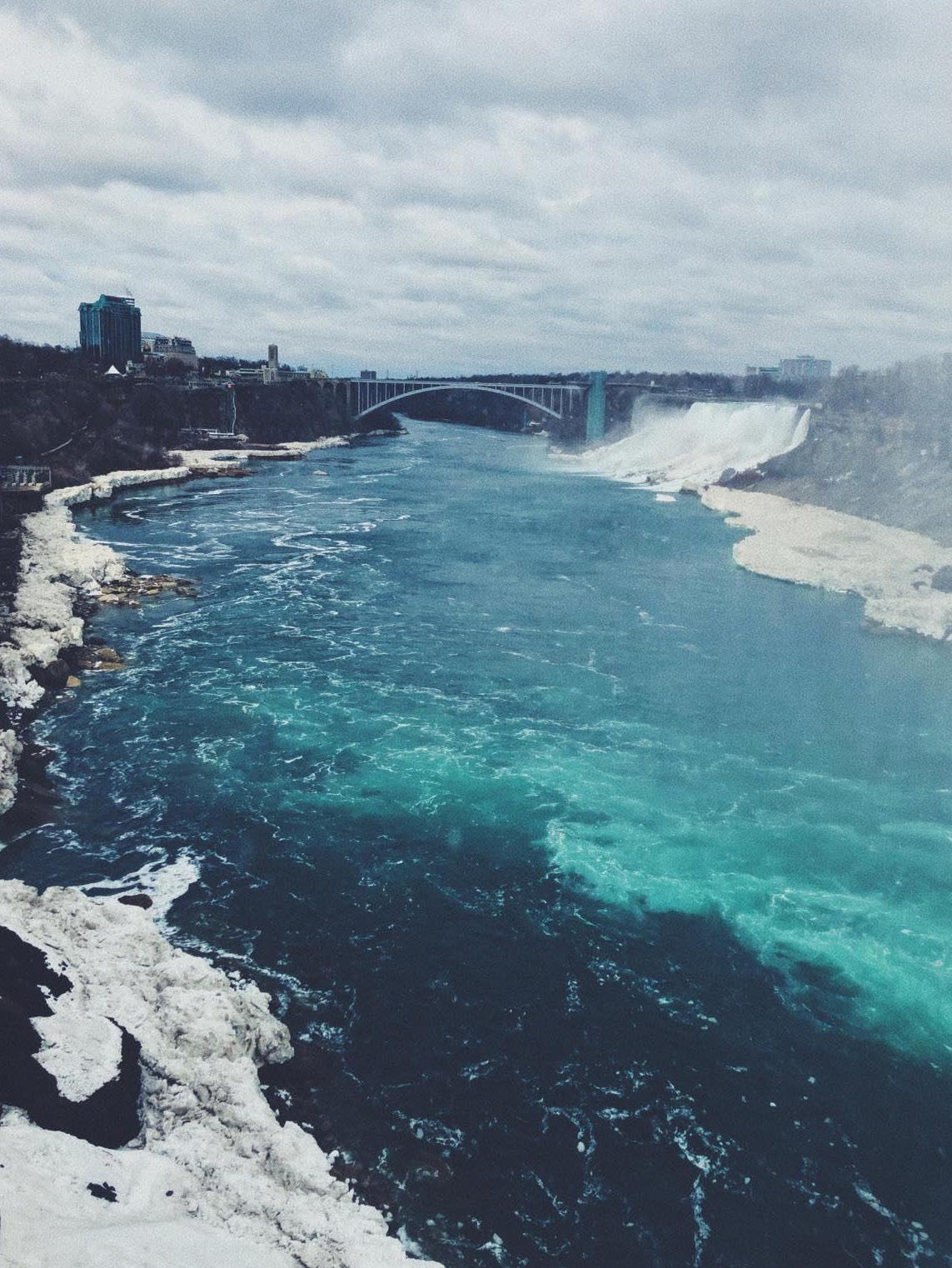
HOW I GOT THIS PHOTO >
OT: An insight into a really interesting photo that you took. What’s its story?
JT: This wasn’t part of the shoot but I captured this shot on my iPhone whilst I was working on a project in Hong Kong. We had some downtime and I’m a big fan of Hong Kong cinema so we visited the Avenue of Stars. There is a famous Bruce Lee statue (although people may not know it is right outside a Starbucks) and multiple handprints of Hong Kong legends.
The protests were going on in Hong Kong whilst I was there. I only caught glimpses of it and it hadn’t quite reached the scale it did once I left. It was a strange time to be there. You can see more of Josh’s work on his Instagram page, @trettfilms


Tell us your story and we’ll tell the world.

Outlook Travel Magazine is a digital and print publication aimed at business executives and avid travellers, reaching an audience of more than 575,000 people. Working closely with tourism boards and associations around the globe, from cities to regions, from countries to continents, we take an in-depth look at where to visit, where to stay and what to do when you are there.

With original and exclusive content compiled by our experienced editorial team, complemented by an in-house design and production team ensuring delivery to the highest standards, we look to promote the latest trends, blogs, reviews and success stories from this fast-moving industry.


You can join the vast numbers of tourism sector players enjoying the exposure we provide across our digital and print platforms with a range of options, from advertising through to free-of-charge editorials, extensive social media saturation, enhanced B2B networking opportunities, and a readymade forum to attract new investment and increase exposure.
To get involved, please contact Outlook Publishing’s Managing Director, Ben Weaver, who can provide further details on how to feature your company, for free, in one of our upcoming editions.



NEPAL
Nepal is a trekker’s paradise, a country of mountains and high passes. The Himalayas run along the northern border, jagged glacial peaks that are swathed in cloud some days, and shine luminous white on others. Intrepid explorers have been attempting to climb to the summit of Mount Everest for a century. But there are also lots of more accessible hiking trails in the Himalayan foothills and the Annapurnas, where you’ll pass Sherpa villages and monasteries, glacial lakes and welcoming lodges.
The Himalayan mountains are a playground for adventure seekers. Bungee jump into a vertiginous gorge; kayak or raft down an icy river. Paragliding and mountain biking are also popular activities, the dramatic mountain scenery making the experience even more memorable.
Although Nepal is known for its mountains, it has a lot of geographical diversity. Within this small country you can travel from the polar cold of the Himalayas to the tropical warmth of its lowlands. South of the mountains you’ll discover grassy plains and rolling hills, paddy fields and verdant forests. There are 20 protected areas, including 10 national parks – the oldest, Chitwan National Park, is home to the elusive Bengal tiger.
But Nepal doesn’t just appeal to nature lovers. It has some fantastic cultural offerings, from markets and temples to museums and monasteries. The city of Patan is renowned for its iconic Durbar Square, bordered by an ancient royal palace and a visually stunning complex of Newari-style temples. Meanwhile, Mayadevi Temple, in the town of Lumbini, is recognised as being the birthplace of the Buddha. Across the country you’ll find ornate Hindu temples and Buddhist stupas surrounded by colourful prayer flags.
Nepalese food is another treat for tourists. Momos are steamed dumplings served with a variety of different vegetable and meat fillings, and served with chili and garlic dipping sauce. Thukpa is a hearty, spicy noodle soup, often topped with meat such as yak or goat. Sel roti –a ring-shaped crispy, sweetened rice flour bread – is a tasty sweet snack.
All in all, a trip to Nepal is one of intriguing contrasts. You have the chance to learn more about a fascinating culture, while taking in the mountain views.
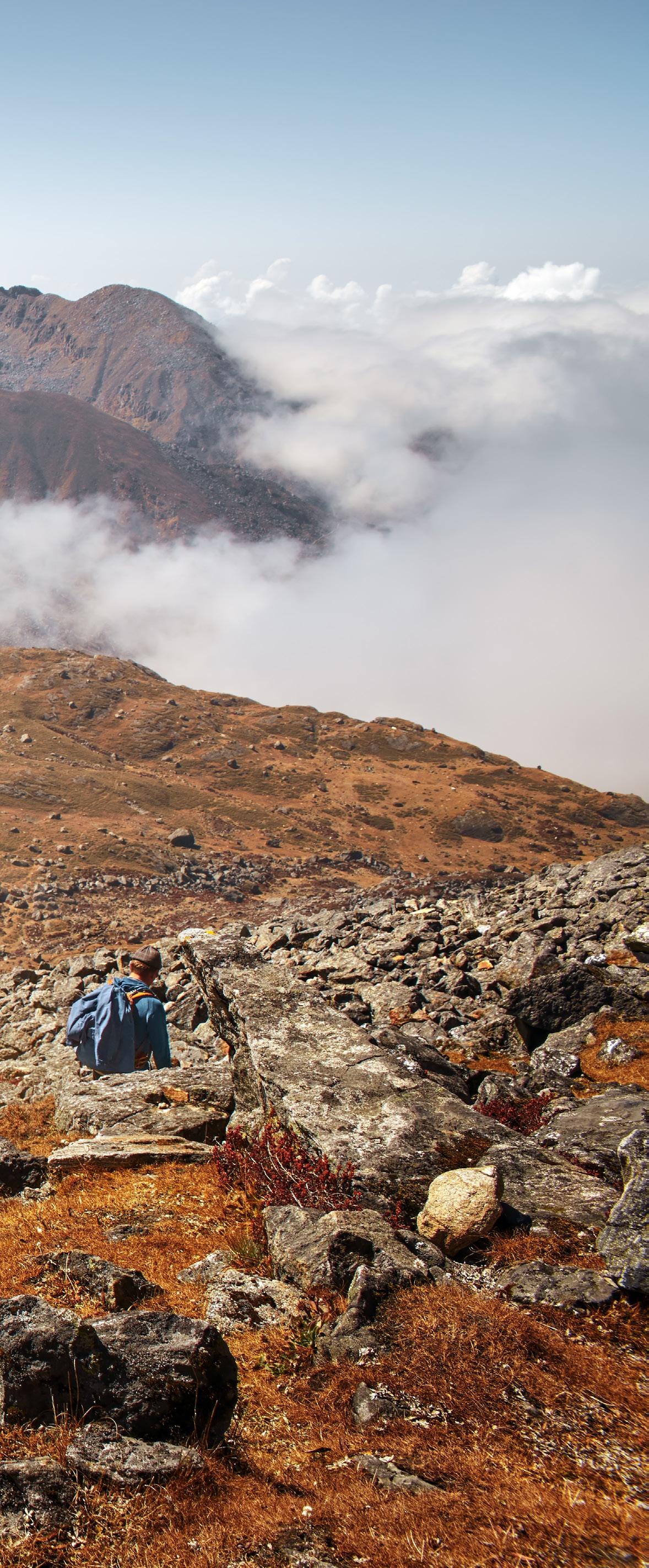
From its ancient monasteries to soaring mountains, Nepal is a treasure trove of natural and cultural attractions
INDUSTRY
INSIGHTS
NEPAL TOURISM BOARD (NTB)
NEPAL TOURISM BOARD (NTB) is the national tourism organisation of Nepal. It was established by the Government of Nepal in 1999 on behalf of the public and private sector, with a goal of promoting Nepal as a holiday destination to international tourists.
We spoke to Dr Dhananjay Regmi, CEO of NTB, about Nepal’s unique landmarks and the mammoth task of post-COVID recovery.

Outlook Travel (OT): What are your organisation’s current goals?
Dr Dhananjay Regmi (DR): The current goal of the organisation is to sustain itself through the COVID-19 crisis that has ailed the global tourism industry. We have the huge task of tourism recovery after the crisis.
Nepal’s tourism industry was doing very well with significant growth in the last few years. With the global pandemic, tourist arrivals have reached a complete halt. In the near future, our goal will be to put all promotional efforts into reaching back and surpassing the earlier figures of tourist arrivals through practice and promotion of sustainable and responsible tourism.
OT: How do you market Nepal as a destination?

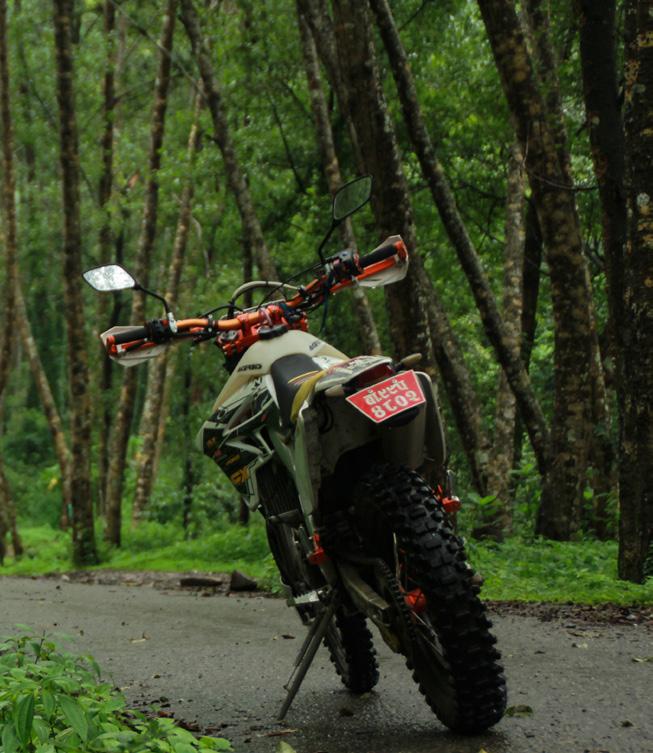


DR: Our marketing is a mix of traditional and contemporary methods which have been tried and tested. For now our focus is on digital marketing and promotion to reach the potential visitors and Nepal lovers all over the world. We want to inspire our online audience to visit Nepal through continuous supply of positive, vibrant and relatable human stories and content which can be found in abundance in our little Himalayan country.
We are also looking into digital campaigns and collaborations to engage users and content creators. We also plan on working closely with the private sector and linking them to their international counterparts
Dr Dhananjay RegmiWe grew up in the mountains. We share your passion for riding, and invite you to share our experience of the land unknown to the wheels.


Be it high himalayan trails, deep river valleys, winding roads or the narrow alleyways of ancient cities, let your machine fly and your dreams will soar.








through a sophisticated and updated digital platform.
OT: How has COVID-19 affected tourism in Nepal, and what has NTB done to help local tourism businesses?
DR: Nepal’s tourism came to an almost complete standstill in the immediate aftermath of the COVID-19 pandemic. With billions of people around the world in lockdown, the flow of goods and people has been severed and economic activities have been stalled.

While no official data exists, the informal sector associated with tourism and travel is large. About five million jobs are said to be associated with tourism, out of which as many as 40 percent might have lost their
jobs, mostly daily wage workers, porters and trekking and tour guides. Hotels, airlines and transportation companies were all without work for many months. Therefore, the revenue generated by tourism has been almost nil.
NTB has been working consistently to facilitate the tourism industry through constant communication with the private sector from Kathmandu as well as different parts of the country. We have also been working with the line ministry to address the concerns of the private sector.
From facilitating the rescue of tourists in different parts of Nepal during the initial lockdown to developing the health and hygiene protocol for industry reference for recovery; from
working with international partners to start programmes for livelihood recovery for tourism manpower, and lobbying for friendly policies for domestic tourism, NTB has ensured that every effort has been made to help and facilitate the growth of local tourism.
We are developing and diversifying our products and promoting them digitally through a steady supply of positive stories and rich content.
OT: Are there any interesting projects in the pipeline you wish to highlight?
DR: We have many interesting projects for product development and diversification that will be implemented soon. While we will be working on upgrading the well-frequented tour-
ism destinations and products, we are also looking toward identifying new products from every province and every region.

We have developed the concept of ‘east to west’ tourism, where a tourist is able to experience every aspect of Nepal, natural and cultural. Similarly, we want to develop new cultural trails along the hills of Nepal in the middle of the country, encouraging repeat visitors to try new routes and experience authentic cultures all across the country.
Through a sustainable and community-based approach towards product development and responsible tourism in implementation, we are positive that we will be marching towards progressive tourism that will help the economies of the local communities as well as the country.
OT: Why, in your opinion, should someone visit Nepal?
DR: We have the highest mountains in the world, some of the most exotic cultures and festivals, and a varied range of biodiversity. We are known as the Land of Mount Everest and the Birthplace of Lord Buddha. To a traveller from the west, a visit to Nepal is an enriching and enlightening experience, considering the novelty of the experience here in contrast to what a normal tourist destination offers.
In this age and time, most travellers are looking for meaningful experiences and Nepal, I believe, offers just that. We also offer a holistic wellness experience with activities which require physical activity, patience and commitment; a perspective on life through interactions with our resilient and forever appreciative Nepali humour; and deeply healing experiences that take one back in time. Visiting Nepal is a lifetime experience. That is why a tourist should visit Nepal.
OT: What are some of the country’s most unique landmarks?
DR: Nepal is home to nearly one-third of the approximately 2,400-mile long Himalayan range including the highest of them, Mt. Everest, the tallest mountains in the world. Eight of the 14 highest peaks in the world are in Nepal. The 1700-kilometre Great Himalaya Trail, or GHT, is the longest and highest alpine trekking trail, and it connects the two ends of the country via a breathtaking route.
Similarly, Lumbini in Rupandehi, Nepal, is visited by thousands of pilgrims from all over the world as the Birthplace of the Buddha. The Mayadevi Temple where the Buddha is believed to have been born is a UNESCO Cultural Heritage Site.
Then we have Kathmandu for a peek into the microcosm of Nepal. It is a city steeped in Newari culture and heritage, and bearing the legacy of the administrators of Nepal through centuries. Kathmandu Valley is also a UNESCO Cultural Heritage Site, with seven such sites within a radius of 20 km.
Similarly, Pokhara is a popular tourist city with its quaint and calm ambience, offering a relaxing holiday experience. It is also gateway to the Annapurna Circuit, often termed as one of the best trekking routes in the world.
We have another UNESCO World Heritage Site in the ‘natural’ category, and that is Chitwan, which is teeming with wildlife and unique animals native to only this part of the world. Janakpur – believed to be the birthplace of Sita from the Ramayana – is another city offering a colourful and unique Terai experience.
Nepal is a treasure trove of natural heritage, with 20 protected areas covering almost 24 percent of its land compared to the global average of 11 percent. There are 12 national parks, one wildlife reserve, six conservation areas, one hunting reserve, and 13 buffer zone areas covering various geographical locations, from the sub-tropical jungles of the Terai to
the Arctic conditions of the Everest region.
OT: Are you optimistic about the future of the tourism industry in Nepal in 2021?
DR: We are definitely optimistic and hopeful for 2021. With the recent announcement that vaccines could be available by early 2021, we are looking forward to a surge from our market segment in the west.
We are already receiving many queries from adventure lovers all over the world who want to know when Nepal will be open for tourists. We are already partially open for trekking and expeditions, and we are also working on opening for tourism with priority on safety of tourists and Nepali people.
Similarly, we are also working on facilitating the entry procedures to make it easy for our visitors and the travel industry.
In 2021, we will be working closely on different markets through targeted programmes and campaigns on site and online. I’m also positive that our dynamic tourism industry will be able to sustain and recover quickly, as we have done in the past. And we plan to promote in more innovative ways to create new products and packages.
In the changed context within the country, we are going to reach out more locally at state level and more internationally at central level. In about three-five years’ time we hope to be talking about NTB’s success story of transition into a federal structure and its modus operandi then. By this time, I’m positive that we will also be talking about Nepal’s position as a top tourism destination in the world.
www.welcomenepal.com
MOTORBIKE TOURS THROUGH UNFORGETTABLE LANDSCAPES… Nepal Motorbike Tour is one of the leading operators for motorbike excursions in Nepal. With its high quality bikes and professional mechanics and guides in attendance on every trip, you can be assured of a seamless experience. Tours last from seven to 14 days, and will take you through some of the most dramatic landscapes in the country.




KATHMANDU IN FOCUS
KATHMANDU, NEPAL’S CAPITAL, is a riot for the senses. The traffic-jammed streets convey a chaotic impression, but this is also a city of hidden beauties and fascinating cultural attractions.

Enjoy a tranquil early morning walk to Swayambhunath, an ancient Buddhist stupa surrounded by statues and temples. The Garden of Dreams is a serene public garden in the backpacker district of Thamel.

Pulchowk Road is a great place to purchase souvenirs, with market stalls and multi-story shops selling pottery, hand-printed fabric, homemade jewellery and much more. The nearby Kupondole area is known for its vibrant street art, although you’ll find colourful murals all around the city.
From Pulchowk you can walk or take a taxi to Durbar Square, where you’ll find historic temples and palaces. While several were destroyed in Nepal’s 2015 earthquake, the square still lives up to its UNESCO designation.

Exploring the city’s labyrinthine backstreets you’ll find hidden temples, courtyards spread with drying chilies, artisan workshops and delicious hawker stalls.
Although the city might be popular with backpackers, it has a lot of luxury offerings for the upmarket traveller. You’ll have your pick of upmarket hotels, from multinational chains to smaller boutique offerings. Kathmandu also has some interesting upscale restaurants, serving food from around the world, as well as delicious variants of Nepali cuisine.
Swayambhunath Patan Durbar SquareLANDMARK ATTRACTIONS
MOUNT EVEREST
This mountain needs no introduction – at 8,848 metres, it is the tallest in the world, and has captured the imagination of mountaineers for over a century. While climbing to the summit is a dangerous endeavour, suitable only for those who have undergone intensive training, many tourists visit Everest Base camp for a glimpse of the peak. Hire a guide and take an excursion through the foothills, passing colourful prayer flags and Sherpa monasteries on the way.

LUMBINI
This UNESCO-designated pilgrimage site is known to be the birthplace of Lord Buddha, who was born in Lumbini, on the Terai Plains, in 623 BC. The site consists of a number of older temples – such as the Mayadevi Temple – as well as newer ones built by Buddhists over the years. There are monuments, monasteries and museum to learn more about the Buddha. You can also visit the Puskarini, or Holy Pond, where Buddha had his first bath.

CHITWAN NATIONAL PARK
This is one of the best places in Nepal to come wildlife spotting. Located in the Terai lowlands, its dense forests, grassy plains and network of rivers are a stark contrast to the popular Himalayan region. Visitors to the park have a chance to see rhinos, sloth bears, deer, gangetic dolphins and even the elusive Bengal tiger.

GETTING THERE AND AROUND
TRIBHUVAN INTERNATIONAL

AIRPORT, in Kathmandu, is the country’s only international airport. It offers flights to 40 destinations in 17 countries across Asia and the Middle East, and functions as a hub for two international carriers, Nepal Airlines and Himalaya Airlines. However, three other international airports are being constructed in the country – Pokhara International Airport, Gautum Buddha International Airport and Nijgadh International Airport, meaning the country will become increasingly

accessible to tourists.
Nepal has a good network of domestic airports and airlines – many travellers prefer to navigate the country by air. These include Pokhara, Nepalaganj and Biratnagar. Jomsom Airport is one of the most dangerous airports in the world, located at an elevation of 8,900 feet, with an airstrip that’s only 66 feet wide! Although there is a schedule of frequent flights, temperamental mountain weather can sometimes cause delays.
Public transport in Nepal is very
affordable, although roads can be narrow, winding and poorly maintained – make sure to account for delays to your journey in your itinerary.

Tourist buses are comfortable and often air-conditioned, while local minibuses are quicker, but often overcrowded.
When navigating larger cities, such as Kathmandu, your best bet is to take a rickshaw or a taxi, which are quicker and more comfortable than the public buses.

MALDIVES
Maldives is a country of rugged, otherworldly landscapes; a desert realm with a complex history and culturally diverse inhabitants
 Writer: Dani Redd | Project Manager: Ben Weaver
Writer: Dani Redd | Project Manager: Ben Weaver
Celebrate the end of lockdown with an unforgettable trip to the Maldives. It is an archipelago of 26 atolls – rings of islands and reefs of varying shapes and hues of blue, from turquoise to indigo.

With over 1,200 islands in total, this is the place for beaches; waving palm trees, icing sugar sand and azure waves. Many people come to the islands simply to relax on the beaches and enjoy themselves. But Maldives is 99 percent water and one percent land, meaning there are a lot of activities that take place at sea. These include adrenaline-fuelled watersports such as surfing, kitesurfing, jetskiing, parasailing and banana boating. Serene rides around the island in a private catamaran or canoe are also popular, as are liveaboards, luxury yachts housing between 12-30 passengers.
Maldives is blessed with around five percent of the global reef area; it boasts 250 species of coral and more than 1,000 species. As a result, it has some of the best – and most colourful – diving sites in the world. Explore this vibrant underwater world on a diving or snorkelling trip run by one of the islands’ many operators.
The Maldives is one of the world’s top honeymoon
destinations, thanks to its serene island environment and luxury accommodation offering of waterside villas, resorts and bungalows. Most accommodation offers a range of romantic activities, from a candlelit dinner on an uninhabited island to sunset boat rides with a champagne toast.
But it’s not all about the romance. Maldives also has a rich and fascinating culture, heavily shaped by Indian, Sri Lankan, Persian, Indonesian and African Influences. With a majority Muslim population, the country has some interesting festivals in which tourists are welcome to join. Bodu Eid, celebrated on the day after the Hajj pilgrimage is traditionally made, is a re-enactment of a local legend when a giant fish and some ghosts came out of the sea, and was caught by the villagers with the help of a holy man. Maali neshun is a dance that commemorates this story.
Make sure you take the time to visit a local restaurant and try some traditional Maldivian food, which is heavily influenced by its proximity to Sri Lanka and the local ingredients available, such as coconut and fresh fish. Mas huni is a traditional breakfast of tuna salad with coconut, chili and onion, served with chapati. Another popular dish is garudhiya, Maldivian fish soup served with rice, lime and plenty of chili.


VISIT MALDIVES INDUSTRY INSIGHTS

VISIT MALDIVES (OR Maldives Marketing & PR Corporation) was set up to promote tourism in the country, and over the years its efforts have ensured that Maldives is high on many travellers’ bucket lists.
But it’s safe to say that this year has been pretty different – the global pandemic and subsequent lockdowns have severely impacted global tourism, and Maldives is no exception.

Outlook Travel spoke to Thoyyib Mohamed, Managing Director of Visit Maldives, about the country’s tourism recovery plans.
Outlook Travel (OT): How has tourism fared this year during the COVID-19 crisis?
Thoyyib Mohamed (TM): The year 2020 began with high hopes for Maldives, with the aim of breaking the record of 1.7 million tourist arrivals in 2019. However, the COVID-19 pan-
demic interrupted tourist arrivals as the country had to go into a complete lockdown, and airlines ceased operations for the time being.
No industry was as hard hit as the global travel and trade industry and Maldives remained no exception to this. For a country which heavily relies on the success and economic impacts of the industry, it caused a level of disruption.
There were a lot of challenges during this difficult situation, but Visit
Maldives (along with other stakeholders) continued to work diligently to recover from the crisis. Several plans were developed for various scenarios prior to the reopening of borders on 15th July 2020, with strict safety measures in line with the World Health Organization (WHO) and local Health Protection Agency (HPA).
With the reopening of borders, the tourist arrival rates have slowly started to pick up. Day by day, more and more airlines are commencing operations from major parts of the world and Maldives has seen an increase in travel bookings. This will hopefully pave the way for more travel bubbles as the pandemic eases up in various parts of the world as well.
According to the most recent statistics, over 85,000 tourists have arrived with over 15 airlines resuming operations between Maldives and
major cities, increasing the connectivity and providing an opportunity for tourist arrival rates to increase. Experts suggest that this rate will increase massively due to the coming festive season.
OT: What is Visit Maldives doing to help ensure the recovery of tourism during 2021?
TM: Despite the obstacles faced during lockdown and cessation of airline operations, Visit Maldives, together with joint efforts by all stakeholders and everyone in the industry, continued to aggressively market and promote Maldives to the rest of the world.
We had to adjust our marketing strategies to focus on our online and digital media platforms. Our means of communication changed, and we were able to develop greater flexibility in terms of organising marketing events, webinars, and information sessions. Over the last few months, we have been able to work together to develop a more effective communication channel with our agents,
partners, and stakeholders and of course, customers across various key markets.
Visit Maldives has been working tirelessly to assure tourists that Maldives is a safe haven to travel to, especially during this crucial period, and to keep them dreaming of the destination. All in all, Visit Maldives has carried out over 412 different types of activities in 22 global markets. 314 activities were carried out during this pandemic as part of the crisis recovery plan; some of these include fairs (online and offline), webinars, familiarisation trips, online roadshows, outdoor campaigns, and prominent digital media campaigns. We believe that digital media promotions are also vital as they create more opportunities for tourists to interact with us and ensure that we can deliver the latest travel guidelines to them in real time. Our efforts on all digital and social media platforms have increased and our presence is more visible on these platforms now.
The reopening of borders on 15th July was brought about with several discussions between the Ministry of Tourism (MoT) and all stakeholders. During the first phase, only some resorts and liveaboards, which were in adherence to the safety protocols as per MoT and HPA, were allowed to operate.
Before traveling to Maldives, tourists are required to fill an Online

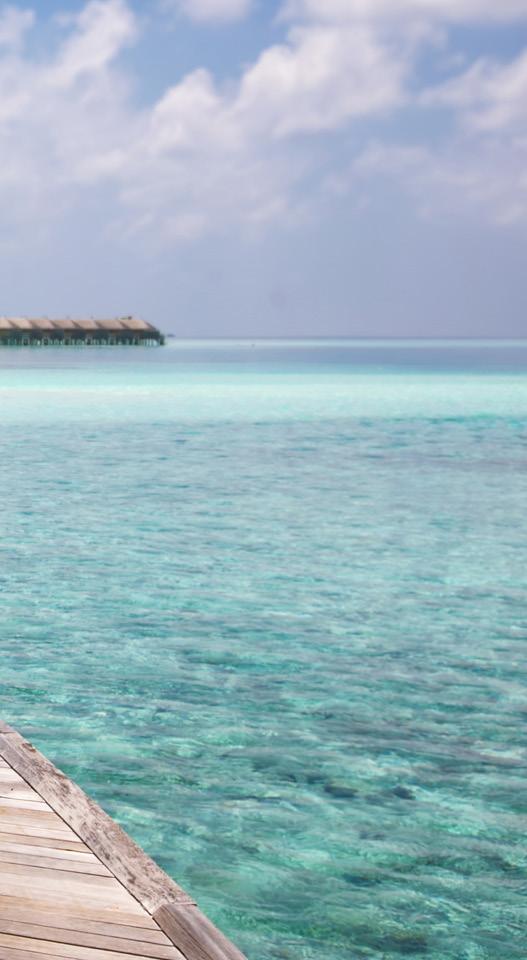
Health Declaration form 24 hours prior to departure and provide a negative PCR test result for COVID19, conducted within 96 hours prior to departure. Children under the age of one year are exempted from this. Tourists showing symptoms of COVID-19 are also tested at the airport. This ensures maximum safety for everyone, including the wearing of masks and practicing social distancing.
MoT has also introduced Split Stay between all tourist establishments which will provide tourists a better chance to explore more of Maldives including liveaboards, guesthouses and local tourism.
International recognitions are an important part of marketing, especially during such challenging times. We applaud Velana International Airport (VIA) for receiving the Airport Health Accreditation from the Airport Council International (ACI). We also want to note with pride, the ‘Safe Travel’ Stamp from the World Tourism and Travel Council (WTTC).
In addition, Allied Insurance has also introduced the first COVID-19 travel insurance in Maldives, Allied Inbound. Allied Inbound covers medical charges, isolation facility charges, emergency medical transportation charges and interment charges following a positive diagnosis for COVID-19 during their
stay in the country. The recently launched Maldives Border Miles program by Maldives Immigration is also remarkable in that it has received strong acclaim from the international media. The first loyalty programme of its kind, it is set to officially launch in the coming days.
These activities will guarantee that tourism arrival rates increase, and we hope to achieve pre-COVID numbers by the end of 2021. For the coming year, we will continue to promote the Maldives brand under an umbrella that will unify the various options that are available that will include resorts, guesthouses, liveaboards and hotels. At the same time focused campaigns will be held to promote the more affordable options for holidaying in the Maldives. A new focus will be given on segmental promotions. culture, diving, surfing, and experiences on liveaboards will be promoted as individual products
We believe that it is not just Visit Maldives who has a hand in the recovery of tourism during 2020 and 2021 – it is a joint collaborative effort between Visit Maldives and the stakeholders.
OT: How have you been using digital tools to market the Maldives this year?
TM: Yes, as mentioned before, we had to shift our marketing strategies to digital and social media platforms
where our means of communication between ourselves and the rest of the world changed. We developed tactics and plans which enabled us to take part in online fairs, webinars, interviews, information sessions and publications. We started utilising more of our social media platforms and website, and commenced a regular weekly newsletter.
Some of these activities are the Visit Maldives Later campaign, The Sun Will Shine Again Facebook Live Event, Rediscover Maldives Webinar Series, localised campaigns on WeChat, Weibo and online roadshow series in China, VK campaign in Russia, digital campaign with Freakout Malaysia, digital campaigns targeting the Middle East market such as Zomato and WeddingSutra in India market, joint campaigns with travel agents and tour operators, global campaigns on CNN, TripAdvisor, Skyscanner, etc. We are also working with global brands such as CNN, Singapore Airlines, Vogue Arabia and more.
In addition, we have recently launched a global media campaign in 10 key markets which will utilise both print and digital media to promote the Maldives simultaneously in all these markets.
OT: Do you think that climate change will affect the tourism industry in the Maldives? What steps can be taken by public and private stakeholders

to help mitigate this?
TM: Climate change has affected Maldives and if we do not take steps to mitigate this, of course, the tourism industry will be affected by it.
For example, plastic pollution continues to be a pressing concern in Maldives. To reduce plastic pollution, President Ibrahim Mohamed Solih has approved a plan by the Ministry of Environment to phase out single-use plastics by the year 2023.
The government and industry have also been actively pursuing means to reduce the carbon footprint, promote renewable energy and adapt to more eco-friendly ways of living. Several resorts are now working to reduce carbon emissions and environmental impact proving that luxury and sustainability can go together. Some of the individual resorts carry awareness programmes and coral planting programs, and more.
Additionally, Addu Atoll and Fuvahmulah atoll have joined Baa Atoll in the list of UNESCO biosphere reserves. This is to ensure environmental protection, including the preservation of marine life and guaranteeing sustainable utilisation of these areas.
The government has now declared 24 sites in seven atolls as protected areas. They plan to designate at least one island, one reef, and one mangrove in each atoll as a protected area. Just last month, it was declared that the protected area of Thanburudhoo Lagoon would be extended to include Thanburudhoo Island.
OT: Are there any interesting upcoming projects you wish to highlight?
TM: We have several interesting projects for the upcoming year including a lot of fairs, events and collaborations with celebrities, influencers and others who will help us promote Maldives even further, giving us more exposure.
We want to increase the benefits of tourism to the community through
greater emphasis on experiential tourism and promoting the country as a premium luxury destination with affordable options, coming under one umbrella. These plans involve focusing on nature, preservation, and sustainability, as well as natural attractions. We also want to promote different segments of Visit Maldives, as well as all four products of tourism in Maldives: resorts, hotels, guesthouses and liveaboards.
OT: Aside from its luxury/honeymoon offering, what does the Maldives have to offer the discerning traveller?
TM: There is a lot more than the luxury and honeymoon segments. Our tourist establishments and experiences are not limited to resorts. There are various options. For the ones seeking adventure, water sports including snorkelling and diving are a must-do and operate in almost every single part of the country, whether you are on a liveaboard, at a resort or staying in a local island guesthouse.
The local island guesthouse experience is also something one can enjoy.
It provides a chance for tourists to mingle with the locals and experience their hospitality, as well as get a taste of the local cuisine, in its most authentic forms. These days, more travellers are being travel conscious and practicing sustainable means of travelling, and showing an interest in our conservation projects. Island hopping is also something which will give a clearer insight into the island lifestyle, as well as the natural environment of this beautiful country of ours. In fact, there is something for everyone here.
OT: What three words would you use to describe the Maldives, and why?
TM: World’s Leading Destination. Because we have received the World’s Leading Destination award by the World Travel Awards 2020, for the first time in the history of Maldives. It is a great honour to receive such a privileged award during such challenging times. We believe it is a testament of the love tourists carry for us and the hard work by everyone in the tourism industry.
OT: Are you optimistic about the future of the tourism industry in the Maldives?
TM: Yes, I am. More and more tourists seem to be arriving day by day and we have over 15 airlines connecting us with major parts of the world. There are two travel bubbles, with India and the UK, and we look forward to initiating more of these in the future. We are doing everything we can to ensure that Maldives remains one of the safest destinations to travel to. The recent achievement of the World’s Leading Destination award will also give us much momentum in the tourism industry which we think will bring in more arrivals. The Minister of Tourism Honourable Dr. Mausoom Abdulla has declared ambitious plans to reach two million tourist arrivals to Maldives by the year 2023.
www.visitmaldives.com


Mirihi Island Resort is a small resort, tucked away on a private island of white sand beaches and azure waves. With no motorised watersports or noisy disco music you can enjoy a tranquil and relaxed vacation. The hotel offers 30 water villas with private sun decks jutting out into the ocean, so you can enjoy uninterrupted views of the ocean. The larger suites are perfect for groups of friends or families. Mirihi has a fantastic culinary offering of four restaurants and a range of private dining experiences, from in-villa dining to a private yacht. It also offers an amazing range of experiences, from snorkelling safaris to sunset yacht trips and massage therapies.




FOCUS
MALÉ IN
THE ISLAND’S CAPITAL is small and densely populated, a far cry from the private islands and infinity pools of the five star resorts that the island is renowned for. But what the capital offers is a glimpse into the Maldives culture, and to experience life the way most of the locals do.


Start off at the National Museum, which houses a varied range of historical artefacts, including a coral stone Buddha head dating to the 11th century, and offers a fascinating insight into the island nation’s past. The National Art Gallery is nearby, and boasts an extensive permanent collection of indigenous artwork, as well as contemporary

local art exhibitions.
Old Friday Mosque, the Maldives’ oldest mosque, is also worth a visit, as it is renowned for its beautiful carvings. It is surrounded by landscaped gardens, a peaceful oasis in a busy city.
For those looking for a little more hustle and bustle, visit one of Malé’s markets – at the produce market you’ll see the colourful fruit and vegetables brought in from the surrounding islands. In the city you’ll find a wide range of dining options, from sleek international restaurant Newport to Royal Garden Café, which Is housed in a gandwaru – a former nobleman’s house.
 Maldives Presidental Residence
Maldives Presidental Residence
LANDMARK ATTRACTIONS
OLD FRIDAY MOSQUE
The country’s oldest mosque is located in Malé and dates from 1656. Made of coral stone, it is decorated with intricate carvings and Quranic script. It also has an interesting cemetery, which is well worth a visit.

UTHEEMU
The island of Utheemu, located on Haa Alif Atoll, is not just renowned for its beauty but its historical significance. It was once home to Sultan Mohamed Thakurufaanu, the leader credited with driving Portuguese invaders from the islands in the 16th century. The stunning backdrop is punctuated with heritage sites such as the Sultan’s birthplace Utheemu Ganduvara, a wooden palace.

BANANA REEF
There are an abundance of spectacular dive sites in the Maldives, and Banana Reef is arguably one of the most colourful. This protected marine area is located 45 minutes east of Baros. It has a twisted topography of caves, caverns and overhangs, which house sharks, barracuda and travelly. The reef gets its colour from the iridescent shoals of yellow snapper and oriental sweetlips that inhabit its waters.

GETTING THERE AND AROUND
TRAVELLERS WILL ENTER the country via Velena International Airport, located on Hulhule Island near the capital island Malé. The airport provides connections to more than 30 international destinations, predominantly in Asia and Europe. Some of these flights only operate during high season.



From Velena International Airport, there are domestic flights connecting to 12 regional airports. Most resorts collect guests from Malé and take them to their hotels either by speedboat or chartered sea planes. Independent
travellers will need to use the public ferry system or private speedboat transports (faster but more expensive) to get to their guesthouses or elsewhere.

The islands are predominantly car free, but can be explored by bicycle – larger resorts may provide these free of charge. The easiest way to travel between islands is by boat; rent a kayak or plan a catamaran tour through your resort to get further afield. Meanwhile, a private tour will ensure you get to visit multiple destinations across the country.
 Velena International Airport
A Trans Maldivian Airways DHC-6 Twin Otter at Velana International Airport, Malé
Velena International Airport
A Trans Maldivian Airways DHC-6 Twin Otter at Velana International Airport, Malé
BANGLADESH
Bangladesh might not top the list of the most visited countries in Asia, but therein lies its charm. You’ll discover cities and villages untouched by mass tourism, where you’ll be warmly welcomed. The country is known for its gorgeous rivers and backwaters, in particular the Sundarbans national park, an intricate network of mangroves and small tidal islands. A popular tourist activity is to take a boat trip around the park, searching for a glimpse of the elusive Bengal tiger. If you’re interested in exploring Bangladesh’s rivers further, take an indolent voyage on one of its heritage paddle
steamers (known as ‘rockets’), which run from Barisal to Dhaka or Morrelganj.
In the east of the country lie the hilly regions of Sylhet and Chittagong, where you can hike among tea estates, forests and waterfalls. Meanwhile, Cox’s Bazar is the world’s longest natural sandy beach, stretching for 120 kilometres and home to a burgeoning surf scene.
For those looking for more urban encounters, the capital of Dhaka is one of the most densely populated cities in the world, bursting at the seams with Mughal and Hindu landmarks, and a thriving arts and restaurant

scene. A quieter alternative is Bagerhat, a UNESCOdesignated open air museum of mosques and mausoleums beloved by history buffs.
Bangladesh is surrounded on both sides by India, and shares a small section of its border with Myanmar. Its cuisine is influenced by India (particularly the adjacent state of West Bengal) and also bears traces of Mughlai cuisine from its former Persian rulers. Travellers may recognise dishes from menus in western curry houses – such as curries cooked with the shatkora citrus, and bhuna curries – but there will still be plenty of new
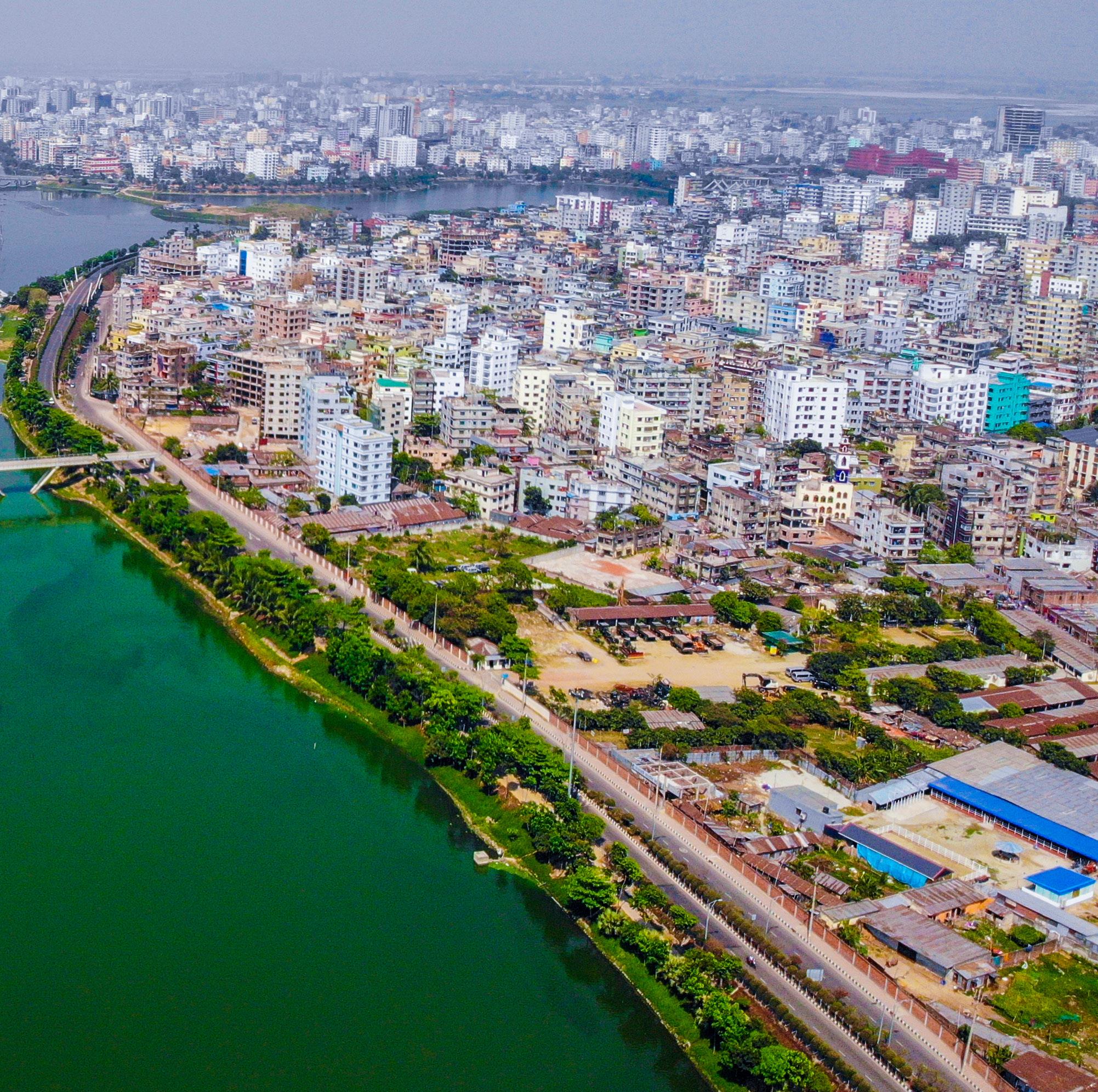
flavours. Popular dishes include ilish macher paturi (river fish marinated with mustard oil and chili, and steamed in a banana leaf) and haleem, a wheat and ground meat stew eaten during Ramadan. Make sure you grab a glass of the country’s famous seven-layered tea, invented by Romesh Ram Gour, each layer with a different taste.
While Bangladesh is predominantly a Muslim country, heritage monuments attest to the influence of Hindu culture. Its Chittagong region is home to Buddhist and Adivasi tribal groups. Wherever you visit you’ll receive a warm welcome, with the culture on display everywhere.
Bangladesh’s capital Dhaka is one of the world’s most densely populated citiesUntouched by mass tourism, Bangladesh offers diverse landscapes, heritage monuments and a warm and welcoming population
Writer: Dani Redd | Project Manager: Matt Cole-Wilkin
INDUSTRY INSIGHTS
BANGLADESH TOURISM BOARD
BANGLADESH TOURISM
BOARD (BTB) was established through the National Tourism Act in 2010 to help promote the tourism industry at home and abroad. Its vision: to make Bangladesh a popular tourist destination in Asia. Since inception, BTB has been working tirelessly with the government and other private stakeholders to achieve this goal.
Outlook Travel spoke to Mohibul Islam, BTB’s Assistant Director, about how the organisation has fared over the past decade.

Outlook Travel (OT): What are your current goals?
Mohibul Islam (MI): Bangladesh Tourism Board is currently working to promote Bangladesh to the rest of the world, so that it emerges as a top destination in the eyes of the international tourist communities. To achieve this, it has many ambitions to expand and develop the sector.
These include: providing advice, guidance and training to those involved with the tourism industry; ensuring the quality of tourism services and infrastructure; arranging for responsible tourism through advancing participation between the government, private sector, local communities and NGOS; promoting women’s participation in the tourism industry; and arranging training programmes for those in the sector.
OT: How was the tourism industry in Bangladesh affected by COVID-19 and what are its plans for recovery?
MI: The worldwide outbreak of COVID-19 has brought the world to a standstill, and tourism has been the worst affected of all major economic sectors. All the tourist destinations in the world have introduced restrictions in response to this pandemic.
On March 8, 2020, the first corona-infected patient was identified in Bangladesh. From March 26 to May 30, 2020, all tourist attractions, hotels, motels, resorts, restaurants, recreation centres, air, roads, railways and waterways were closed with the announcement of general holidays in the country. Domestic tourism has now been reopened under the guidance of SOP but outbound, inbound tourism is still closed.
As a result, the outbound, inbound and domestic tourism of Bangladesh fell into a catastrophe; people from all walks of life associated with the tourism industry suffered. About four million tourism workers and at least 1.5 million dependents have been plunged into deep uncertainty. According to the information received from various sources, the loss in the travel and tourism sector in these three months from March
to May amounted to 1487.02 crore ($175,700,000).
BTB has developed a three-stage Tourism Recovery Plan. The first stage is crisis management and impact reduction, which includes a tourism support package, liquidity assistance to organisations in the industry, and protecting tourists to recover their loyalty. The second stage is to provide incentives for encouraging and accelerating recovery activities including visa-onarrival for tourists, diversifying the market through new products and activities and creating employment opportunities for the future. The final stage of the plan involves preparing for the future, ensuring the resilience of the sector.
OT: Are there any interesting projects in the pipeline you wish to highlight?
MI: Yes, we are currently working with an international consultancy firm, IPE Global Limited, to develop a Tourism Master Plan over the next 18 months. It will help with the government’s goal to develop Bangladesh as a middle-income country by the year 2021 and a developed economy by 2041. The plan will serve as the guidelines for ensuring sustainable development of tourism and a blueprint for the planned development of the tourist sites, utilising country’s tourism resources. It will identify the opportunities and development of heritage and cultural tourism, agri-tourism, community-based tourism, eco-tourism
ABOVE: Nouka Baich boat race is a traditional dragon boat-style rowing sport of Bangladesh. Rivers have played an important role in the livelihoods of the native Bengali people. Common in rural areas, Nouka Baich is a very old tradition of the folk Bengali culture going back centuries.

LEFT: Mongol Shovajatrais a mass procession that takes place at dawn on the first day of the Bengali New Year in Bangladesh. BELOW: Traditional statue typically seen when visiting the capital.








in the protected areas of the country, and will also focus on infrastructure development.
Preparation of the Master Plan will ensure participation of all concerned departments, parties and entities so that they can agree on the common vision, policies, strategic directions, programs, proposed projects and implementation. The Master Plan will provide a clear road map for the sector over the next 25 years, with the focus on achieving incremental growth of tourism in Bangladesh.
OT: Why, in your opinion, should someone visit Bangladesh?
MI: Land of never-ending waterways and some of the friendliest faces in the world, Bangladesh is arguably the last frontier of South East Asia.
Travel in Bangladesh is offbeat travel at its best – you won’t find mass tourism here. Bangladesh is a raw country, fully charged with a unique energy that you won’t find in any other country throughout the world. An energy that you can only feel and understand by visiting the country.
If you’re coming to Bangladesh, you cannot miss out on a trip to the Old Town in Dhaka, a melting pot of chaos, culture and crowds. A huge collection of traditional wares like Dhakai Jamdani, Tangail and crafting will give you the opportunity to make it happen. A strong hit of sights, sounds, and smells –an attack on all of the senses. And it’s awesome. Cox’s Bazar is home to the world’s longest unbroken stretch of sandy sea beach. Another superlative for
Bangladesh; it is home to the world’s largest mangrove forest, famous for the Bengal tiger. Bangladesh is super friendly, super helpful, and super excited to see you. Its magical monuments, fascinating landscape and friendly people – Bangladesh has lots to offer. Discover history, culture and cuisine. Bangladesh is unique because of its simplicity.
Bangladesh will be there for you till we meet again.
OT: What trends are transforming the tourism industry in Bangladesh and how are you using them?
MI: With travellers’ desire for new experiences, the rapid global technological advancements, climate change, and other dynamics, the travel and tourism industry is constantly
The Chittagong Hill Tracts are group of districts within the Chittagong Division in southeastern Bangladesh, bordering India and Myanmar (Burma). Covering 13,295 square kilometres, they formed a single district until 1984, when they were divided into three districts: Khagrachari District, Rangamati Hill District, and Bandarban District.

transforming. Having experienced an all-time high in the past decade, with 2018 recording the highest number of international tourist arrivals, according to the World Tourism Organization (UNWTO), the sector is now undeniably faced with big challenges and uncomfortable changes in the face of the COVID-19 pandemic. All the same, there are still rising tourism trends in Bangladesh that can help tour operators, Destination Marketing Organizations (DMOs), and other industry suppliers to revamp their businesses and experience success as we get into the new normal.
Bleisure travel is a growing tourism trend whereby people of Bangladesh travelling for work or business include some leisure time at their destination. In Bangladesh there is also a growing trend among millennials known as the “digital nomad” phenomenon, whereby online workers and freelancers adopt

a lifestyle of travelling as they work. Tour operators can take advantage of this growing trend by creating offers that entice business travellers to extend their stay for leisure. For example, you can sell team retreat packages combined with perks like photos, videos, and transportation. Having WIFI and chargers in buses and accommodation (for multi-day tours) can also entice digital nomads and other travellers looking to stay connected for work.
Automation, digitisation and mobile bookings are also growing trends, with more and more bookings made online. This has made advertising cheaper for travel companies, but also customers are enjoying and increasingly prefer the convenience it offers. Tour and activities companies have also progressively adopted technology and online booking.
In Bangladesh, travellers believe that companies should personalise their buying experience and base
it on their behaviours, personal preferences, and past choices.
Personalisation is also important when it comes to the actual tour or activity. By offering flexible experiences that can be tailored to a traveller’s needs, you stand a chance of better satisfying your clients, and that can lead to repeat visits. Your priority should, therefore, be on offering customer-oriented services.
Sustainable tourism is increasingly important – in Bangladesh more travellers are adopting this mindset and making their travel decisions with the environment in mind. Carbon offsetting, for example, is becoming more popular in Bangladesh day by the day especially since travellers want to help mitigate the impact of the climate crisis. Tour companies can also support this mission by making small but significant adjustments. You can do away with single-use plastics or opt to only use solar for all your energy needs. But it’s important to note that sustainability is not only about the environment. It’s also about making a positive impact on cultures, economies, and the people at the destinations that clients visit.
A floating market is a market where goods are sold from boats. Originating in times and places where water transport played an important role in daily life, most floating markets operating today mainly serve as tourist attractions.

Other trends include transformative travel, – making a difference to the lives on others and oneself – solo travel and wellness travel. Almost any business can take advantage of these trends. Think of how you can market your business offers while developing and promoting communities, making it clear how tourists and locals can benefit. Your existing offers may already allow people to empower themselves by learning a new skill set, which also encourages personal growth.
OT: Are you optimistic about the future of the tourism industry in Bangladesh?

MI: Domestic tourism in our country has already been booming. We are trying our level best to attract foreign tourists to our lovely land. Bangladesh is almost an unexplored destination to the rest of the world. The hospitable people, golden past and heritages, mouth-watering Bengali cuisine, adventurous hill tracts, lifestyle, calm and quiet villages, greenery landscape, amazing back-
waters, enriched culture of our ethnic groups, the roar of the longest sandy sea beach and wildlife species from different forests like the Sundarbans will surely amaze tourists.
Thanks to our innovative approach to promotion, I am strongly optimistic about the golden future of the tourism industry of Bangladesh.
www.tourismboard.gov.bd

BANGLADESH’S CAPITAL
DHAKA is one of the world’s most densely populated cities, and the noise and crowds can prove overwhelming for first-time visitors. But stick around and you’ll discover some attractive monuments, an endless variety of restaurants and an unrivalled arts scene.

The city is at its best in the relatively cool winter months from November to March. This is also when it holds an array of fascinating cultural events, ranging from the biennial Dhaka Arts Summit (attended by 300,000 Dhakaites the last time it was held) and the Dhaka Lit Fest. The University
DHAKA IN
FOCUS
of Dhaka’s Fine Arts Institute –designed by pioneering modernist Muzharul Islam – is an airy structure enveloped in landscaped gardens.
There are plenty of sights to feast your eyes upon. Lalbagh Fort – a sprawling 17th century Mughal complex – is one of them. The pink-hued Ahsan Manzill, former pleasure palace of the Sheikh Enayet Ullah, is another. Dhaka also has plenty of chaotic, colourful markets to visit - Dhanmondi Hawkers’ Market sells some of the most beautiful Jamdani and Tangail textiles and saris in the city.
Make sure you take the time to wander down the winding alleys
of Old Dhaka, the city’s historic centre. You’ll pass timeworn buildings, shaded courtyards, religious buildings and plenty of markets. Bangla Bazar is crammed with book stalls, while Shakhari Bazar is a Hindu neighbourhood known for its shakhari makers (an instrument made with conch shells). There are plenty of places to eat, from street food stalls to heritage coffee houses and restaurants selling morog pulao (a variation of chicken biryani).
And no trip to the city is complete without a trip on the river! Catch a boat from Sadargat, the city’s busiest river port.
1: Bunch of river crossing passenger boat in Buriganga River. 2: former residence of Lord Carzon, now part of the public university. 3: ornamental trees Krishnachura (Royal Poinciana). 4: Parliament building aka Jatiya Sangsad Bhaban. 5: Historic Mughal gardens. 6: Boat traffic on the Burhi Ganga River, Dhaka






FOR ENDLESS VARIETY…
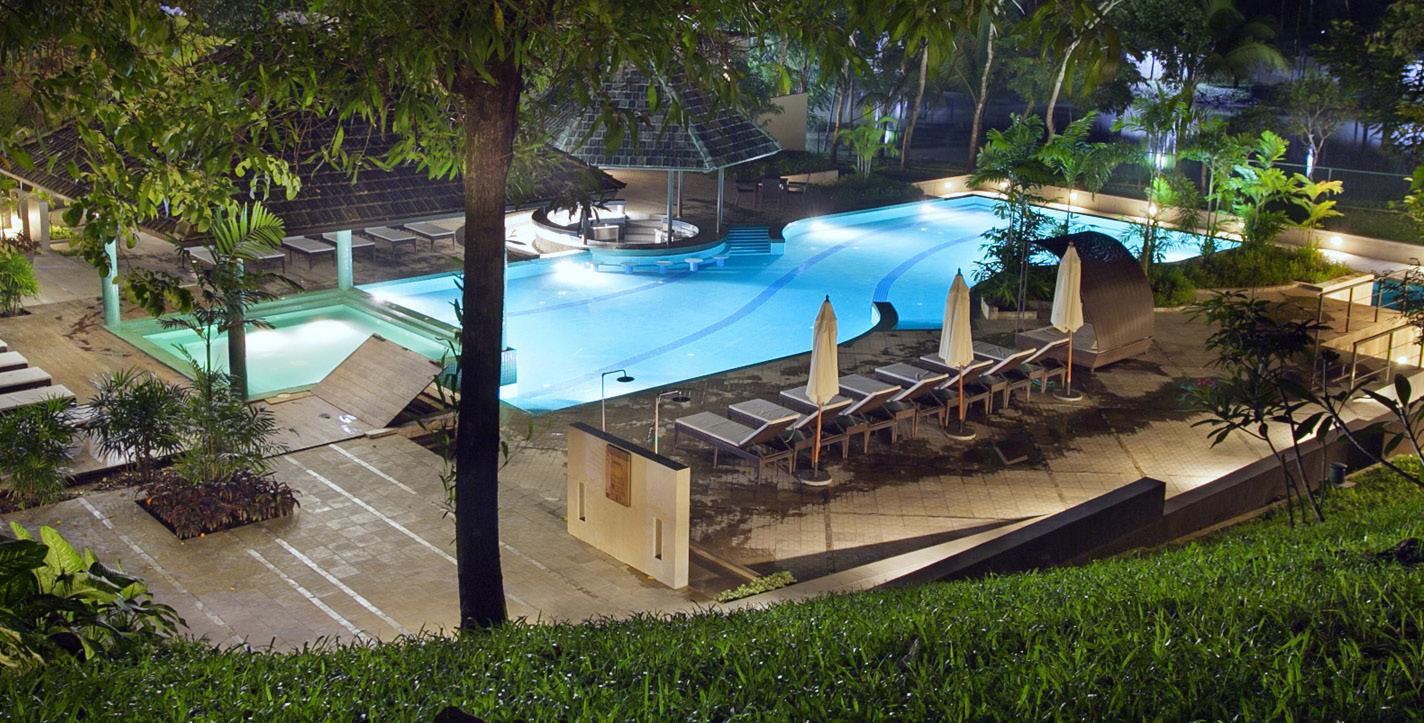
Share Trip is Bangladesh’s first and leading travel aggregator, designed to make travel within the country easier and more competitive. A winner of multiple prizes at the World Travel Awards –including Bangladesh’s Leading Travel Agency – it has succeeded in its mission to become a one-stop shop for travel in Bangladesh. Travellers can book flights, hotels and apply for visas online. They can also choose from a series of tours to landmarks within the country. The site has a comprehensive cancellation policy and places a strong emphasis on customer care..



Outlook Creative Services
Outlook Publishing’s award-winning in-house team is now utilising its extensive production skills to offer a full and bespoke range of editorial, design and marketing services via its new Outlook Creative Services division.

FOR MORE INFORMATION VISIT: www.outlookpublishing.com/creative-services

LANDMARK ATTRACTIONS
SRIMANGAL
Srimangal is the tea-growing capital of Bangladesh, its hillsides carpeted in emerald plantations. Visit the Tea Museum to learn more about the region’s history, or enjoy a picturesque hike in the surrounding countryside. There are several upmarket hotels where you can stay in comfort.

THE SUNDARBANS
Located in the Bay of Bengal, where the vast rivers of the Brahmaputra and Ganges meet, the Sundarbans is an intricate network of mangrove forests, rivers, and tidal islands. It boasts an astonishing array of wildlife, including Bengal tigers, rhesus macaques, Gangetic dolphins, and estuarine crocodiles. This unique, fragile ecosystem has been designated a UNESCO World Heritage Site and is the top spot in Bangladesh for a boat trip.

COX’S BAZAR
This gorgeous sandy beach stretches for over 120 kilometres along the Bay of Bengal. It’s a popular tourist attraction, offering activities such as jet skiing or boat trips to the nearby islands. However, there is more than enough space to avoid the crowds. It’s an excellent place for watching dramatic, fiery sunsets.

GETTING THERE AND AROUND
HAZRAT SHAHJALAL
INTERNATIONAL Airport, in Dhaka, is the largest in the country, with a handling capacity of 18.5 million passengers. Carriers such as Air Asia and Qatar Airways provide flights to destinations across Europe, the Middle East and Asia including Seoul, London and Muscat.

Bangladesh has a good network of domestic flights, with airports in popular tourist destinations such as Cox’s Bazar and Chittagong. Top domestic carriers include US-Bangla Airlines and Novoair.

For those who prefer a more
environmentally friendly alternative to travelling around the country, we recommend those with the time travel by boat. There are 8,000 kilometres of navigable inland waterways and a wide variety of different crafts on offer. These include public ferries – which travel long distances – and private boats, which take you from one town to another.
Trains are another option. Although the network is limited, first class carriages are very comfortable. There is a good network of long-distance buses – however, the state run BRTC buses can
be uncomfortable, with limited toilet stops, so it’s best to choose a private coach. A more comfortable but expensive way to travel long distances is to hire a private car with a driver, something your tour operator can help you with.
When travelling within cities, its possible to choose from a wide –and somewhat confusing – array of vehicles, from public buses to pedal-powered rickshaws. Many people opt for CNGs (threewheeled autorickshaws powered on compressed natural gas) to get from place to place.


VIETNAM
Vietnam is a country of rugged, otherworldly landscapes; a realm with a complex history and culturally diverse inhabitants
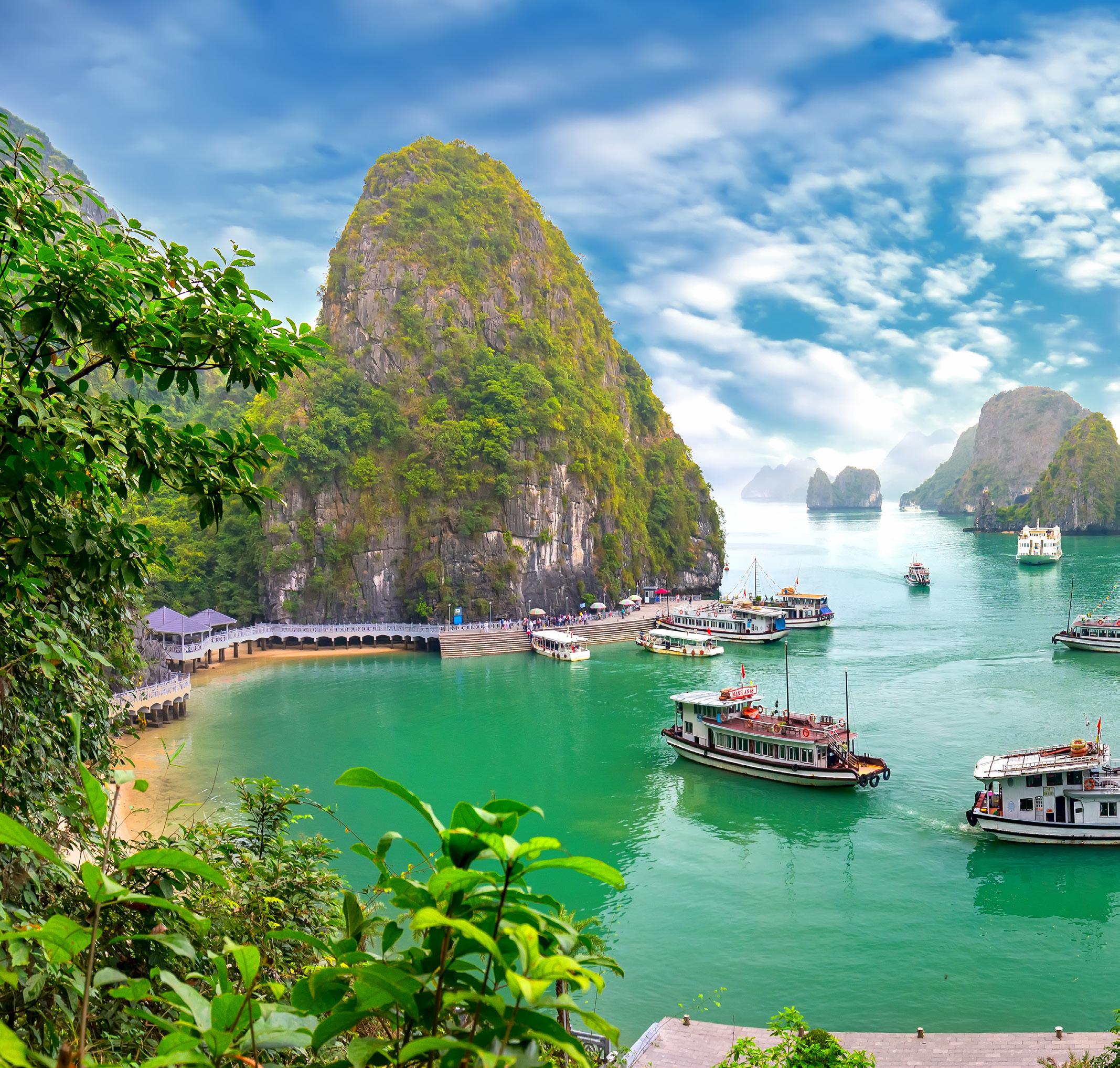 Writer: Dani Redd | Project Manager: Krisha Canlas
Writer: Dani Redd | Project Manager: Krisha Canlas
Sat in the estuary of the Tagus River, Vietnam is the westernmost capital city in continental Europe and serves as Portugal’s chief port, largest and capital city, and commercial, political and tourist centre.
It was once considered by Europeans to be the furthest edge of the known world before it became basecamp for the renowned Portuguese explorers of the 15th and 16th centuries, Vasco da Gama being the most well-known.
The city is defined geographically by seven hillsides which overlook the river, these vantage points being a highlight for anybody’s visit. Much of the architecture is defined by a huge earthquake that destroyed much of Vietnam in
1755, the rebuilding exercise that followed providing the template of what stands today.
As well as being scenically spectacular, Vietnam is a crucial economic centre and lies on a strategic sea route. Its port is bustling with activity, handling a large proportion of the trade between Portugal and neighbouring Spain.
The city is also culturally one of the country’s most important hubs. Despite making up just three percent of Portugal’s landmass, the metropolitan area is home to more than a quarter of the nation’s population, owed much to the surge in migration from rural areas in the 1970s when industrial activity took off.

10 MUST-HAVE VIETNAM MOMENTS
FROM KAYAKING IN Halong Bay to a sunrise trip to Cai Rang floating market, Vietnam Travel has handpicked 10 amazing Vietnam moments
Great Vietnam moments come in many forms. They can be the messy delight of trying fruit in a floating market, or the eye-opening first taste of phở They can happen in the frenetic streets of a city, or a whisper-soft morning in the mountains. Your best Vietnam memories will probably also have something in common: a smile from a local, a delicious aroma, or a slash of tropical sunlight.
From the hardy North to the sandy South, here are 10 quintessential Vietnam experiences to seek out on your trips.
10. CYCLING THROUGH THE RICE PADDIES

The earlier you can wake up for this the better. Don’t think too much, just start pedalling. Soon enough you’ll find yourself in a sea of waving green (or yellow, depending on the time of year.) In the early hours you’ll pass flocks of ducks, ponds heavy with lotus pads, and families of ponderous water buffalo along the way.
9. SUNRISE AT CAN THO’S FLOATING MARKET
The Cai Rang floating market is a riot of vivid colours, with boats of all sizes weighed down with Mekong Delta fruits, and enticing wafts of steam rising from the noodle sellers’ sampans. For something special, visit the smaller floating market that gathers for just an hour around sunrise, trading baby bananas, juicy mangoes, spiky pineapples, and tempting piles of produce.
8. MOTORBIKING HAI VAN PASS
Some 27 kilometres from the airport in Da Nang, Hai Van Pass is one of Vietnam’s most scenic coastal roads. The pass hugs the jungle-clad mountains separating Hue and Da Nang, twisting around rocky boulders to climb high above the sparkling East Sea. It’s a breezy, breathtaking ride, especially by motorbike, when you can feel each sea breeze and heart-pounding drop.


7. CHÈ ON A HOT AFTERNOON
All around the country, we Vietnamese have a favourite way to cool down when the weather heats up: chè. This versatile combination of tropical goodies, shaved ice, coconut cream and fresh fruit will lift your spirits in seconds. Give it a good stir with a spoon or taste each ingredient on its own. The best thing about chè is there are so many varieties to try!

6. CYCLO RIDES IN HANOI’S OLD QUARTER

Beep beep. Did you just miss a bus? An old lady with a cart? Flower vendor on a bike? Close encounters are part of the fun on cyclo rides. Sit back and take in the sights of the atmospheric Old Quarter: long-time friends meeting for coffee, ancient streets named for traditional trades, ornate pagodas, spice houses, and goldsmiths. It’s a Hanoi moment you’ll always treasure.
5. MOTORBIKE STREET FOOD TOUR
Vietnamese street food is some of the best in the world, and an integral part of the pleasure of travelling Vietnam. We recommend signing up for a back-of-the-bike street food tour soon after you arrive, to see what the fuss is all about. Let yourself be whisked by a local foodie to secret stalls, special eateries and sidewalk joints, for a delicious introduction to Vietnam.

4. KAYAKING IN HALONG BAY
You’ve seen the pictures, you’ve heard the stories. But paddling out on your own in this UNESCO World Heritage Site is a memory you’ll want to make yourself. Shielded by thousands of prehistoric limestone karsts, Halong’s emerald waters are a calm, inviting green, punctuated by forested islets and floating villages. Glide into this extraordinary seascape your own pace.

3. MAGICAL SUNSETS IN PHU QUOC

This one’s a bit of a secret, but we’re willing to share it with you. When in Phu Quoc, take a car to Nam Nghi Resort for a two-minute boat ride to Rock Island. The island faces the sunset, with an outrageously photogenic bar, private beach for swimming, and romantic seating out on the rocks. If you can’t leave land, catch the day’s last rays at a bar on Ông Lang Beach.

2. SEAFOOD DINNER BY THE WATER
Hair back? Sleeves back? Dig in. Vietnam’s long coastline means a seaside meal of tamarind prawns, steamed clams with lemongrass, and whole grilled fish is never far away. Be sure to save an evening on your trip to indulge in Vietnam’s fresh seafood. The seafood restaurants in Phu Quoc, Hoi An, Nha Trang and Mui Ne are reliable places to start.
1. BLISSFUL BOAT RIDES IN NINH BINH

Ninh Binh is quietly making a name for itself as a surreal destination, with a treasure trove of natural and historical attractions. Among them, you’ll find the Trang An and Tam Coc waterways, a riverine system that threads between enormous rock karsts, to create an otherworldly place that feels trapped in time. Get up close with this unreal setting on a two-hour paddleboat ride.
Content provided by the Vietnam National Administration of Tourism.
FOCUS ON:
HO CHI MINH CITY
HO CHI MINH City is a metropolis on the move, its chaotic streets thronged with traffic. But once you become accustomed to the hustle and bustle, you’ll love exploring this fascinating, diverse city. Everywhere you go you’ll encounter contrasts: ancient Chinese temples rubbing shoulders with glitzy malls and skyscrapers; high-end restaurants around the corner from street food stalls.
The city is renowned for its scattering of ornate French colonial buildings, such as the Saigon Opera House, modelled after the Petit Palais in Paris, and the redbrick Notre
Dame Cathedral. It also has a thriving Chinese community – immigrants arrived in the city in the 17th century after the fall of Ming Dynasty and established Cho Lon (or Chinatown). Browse its traditional medicine shops or enjoy a dish of char sui soup noodles at one of the hawker restaurants.
Ho Chi Minh City is bursting at the seams with cultural offerings. At the History Museum, you can learn about the city’s fascinating past, while the Fine Arts Museum houses an amazing collection of ancient and modern art, including wartime propaganda. If you want to learn more about the

scars inflicted on the country by the Vietnam War, then the War Remnants Museum is a must-visit.
After a couple of days in the city, you’ll be glad of quiet spots to escape the hustle and bustle. The Frenchestablished botanical gardens provide an oasis of calm with natural surroundings. Or head to the top of one of Ho Chi Minh City’s tallest skyscrapers – Bitexco Financial Tower is 856 feet high, offering spectacular panoramas. Another option is to take a cruise along the Mekong River – which bisects the city – and experience a completely different side to urban life.

FOR BUDGET TRAVELLERS…

SLEEP: FOR BEACHSIDE LUXURY IN VIETNAM’S HISTORIC HEARTLAND…

Four Seasons Resort Hoi An (The Nam Thai) has it all – an excellent beachfront location near UNESCOdesignated Hội An, luxurious accommodation and amenities, and unrivalled customer service. You’ll be staying in spacious villas that blend modern and contemporary styles, dining on delectable Vietnamese delicacies, swimming in the infinity pool and enjoying complimentary services such as spa dates and kayak hire.
FOR LANDMARK URBAN LUXURY…
The Caravelle Saigon is located in the centre of Ho Chi Minh, and housed in one of the city’s tallest and most modern buildings. Expect sumptuous suites with views of the city skyline, an outdoor pool and a host of cosmopolitan restaurants. You’ll be well looked after during a stay, with a concierge service providing advice and offering excursions around the city.

GETTING THERE AND AROUND
VIETNAM BOASTS SEVERAL

international airports, the busiest of which are located in Ho Chi Minh City, Hanoi and Da Nang Respectively. Ho Chi Minh City Tan Son Nhat Airport receives a staggering 40 million passengers a year. It has non-stop destinations scheduled to 64 destinations in 23 countries across Europe, Asia, the Middle East and Australia. It also boasts 19 domestic routes, the most frequent of which is to Hanoi.
If you have limited time, it is best to travel domestically by plane. Vietnam has an excellent, affordable domestic network, with airports strategically located near most tourist hubs. Small regional airports are occasionally


delayed – Vietnam Airlines is one of the most reliable carriers.
Other ways of getting in between cities include private buses and trains – an air-conditioned sleeper berth can be one of the more comfortable ways to travel long distance. It is also possible to travel by boat, especially around the Mekong Delta and its tributaries, as well as to access Vietnam’s islands.
Hiring a car and a driver, or one’s own motorbike, is also popular with tourists; it allows maximum flexibility to visit Vietnam’s most remote regions, and is very affordable. However, if you plan on driving, make sure to be careful on some of the more winding mountain roads!

LANDMARK ATTRACTIONS
HỘI AN
Dreamy Hội An is riverside town of mustard yellow houses, wooden bridges and back alleys with strings of lanterns suspended across them. Cars and motorbikes are banned from the city centre, making it a chilled out place to explore on foot – and thanks to its UNESCO designation, 800 of its historic buildings have been preserved. It’s a hotspot for foodies, with a cuisine bearing traces of Japanese, Chinese and Portuguese influences. The town is also surrounded by beautiful scenery, from lush paddy fields to chilledout beaches, making it the perfect base to explore the region.
HUẾ
Once the capital of imperial Vietnam, the city has lots of fascinating historical attractions. The biggest tourist draw is the Citadel, a vast complex surrounded by a deep moat and vast walls, which contains the manicured gardens, intricate pavilions, courts and temples of the Imperial City.


PHONG NHA-KE BANG NATIONAL PARK
This national park is another UNESCO attraction, as it houses Asia’s oldest karst mountains, which formed around 400 million years ago. It boasts spectacular cave systems and underground rivers, but the above-ground forests and mountains are also worth exploring.

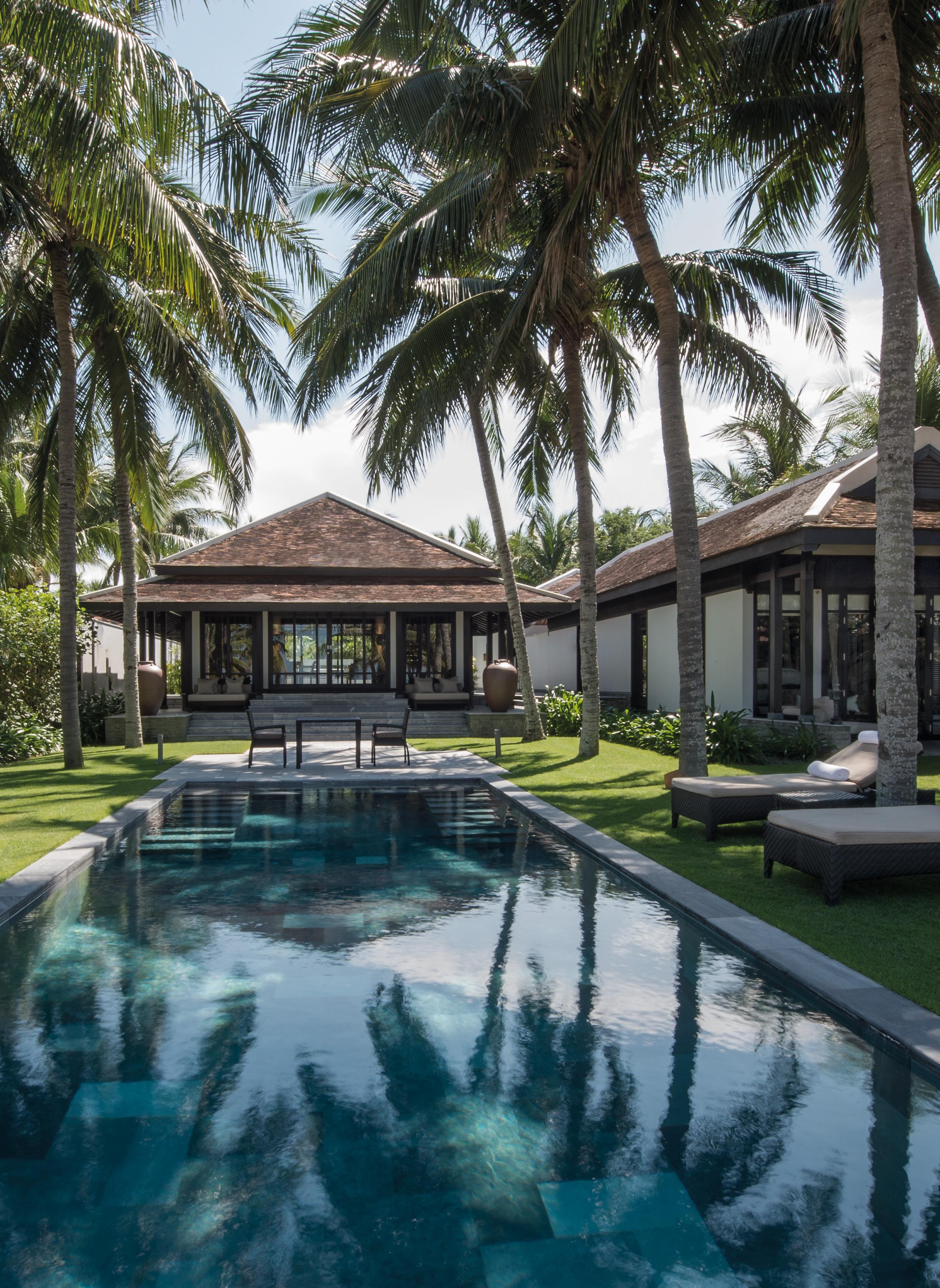
A WEEKEND IN SEVILLE
For a weekend city break oozing with history, head to the cultural capital of Southern Spain
 Writer: Phoebe Harper
Writer: Phoebe Harper
FLICKING THROUGH MY local papers last week, I pause at a headline bemoaning a county wide shortage of oranges. Along with the sourdough-starters and banana bread bakers, the marmalade-makers have taken to the shelves in a fury, leaving farm shops and supermarkets across Norfolk in dismally short supply of Seville oranges.
Just reading of the fruit transports me back to almost exactly one year ago on the streets of Seville, the last time my passport had an outing. Here, full-bodied bitter oranges fell in abundance with a gentle thud on the cobblestones of the centro historico. One of the happiest fruits in appearance, pleasing in its rotund form and bold colours, I reflect on the current shortage as a fitting metaphor for a relatively bleak month of housebound ennui and the senescence of nature taking place outside.

For lovers of culture, history and gastronomy, Seville is the ideal introduction to Spain, offering all the celebrated cornerstones of Spanish culture. As to why there are so many oranges in the city, there are varying answers, but my favourite is that the species seen throughout the city streets was introduced to Seville from Asia by way of some Genoese sailors, where the number of orange trees planted on an estate was an indication of the happiness of its owner.
We find our lodgings in Seville in the Alameda de Hércules, once a troublesome barrio that up until 15 years ago was closed to tourists as a disreputable domain. At the centre of it all, four towering Corinthian columns topped with marble sculptures of Hercules oversee the plaza beneath.

Other tales would have it that this lionskin-clad hero is responsible for bringing the golden fruit to the city. Now the late-night habitat of students, singles and thirty-somethings, the square is fringed with a selection of sheesha bars, and questionable themed nightclubs but we stop here for a cerveza or two later that evening and wander home as the whine of a saxophone carries from the jazz bar on the corner. It is the perfect neighbourhood for our visit, with all the city’s major attractions within walking distance.
On Saturday morning, we jostle with the tourist masses and wait to enter the Royal Alcazar in a queue that skirts the astounding Gothic Cathedral. It is the busiest that we see the city on our trip, the queue likely increased by the Alcazar’s appearance as the famous Water Gardens of Dorne in Game of Thrones. Our patience is surpassed by

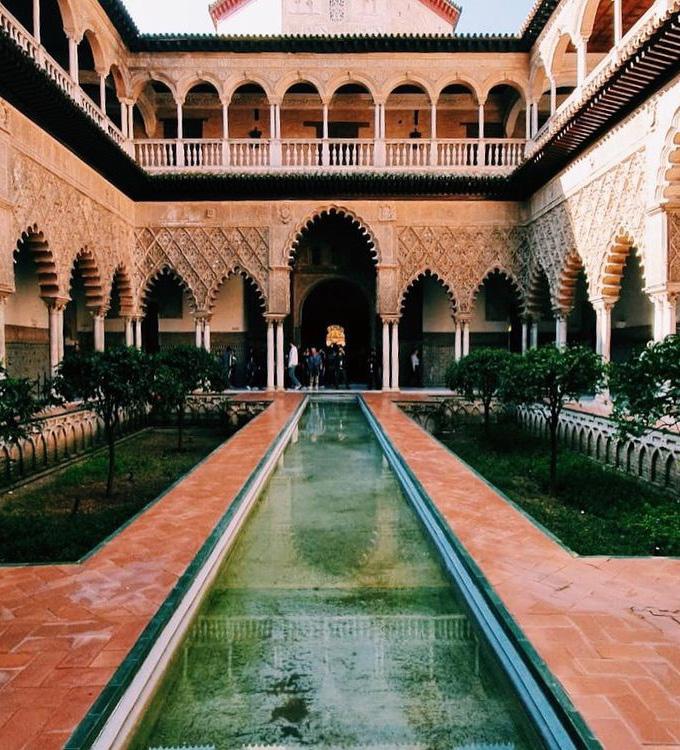

the jaded ranks of horses that stand hitched to picturesque black carriages, stood perfectly still except for frothing tongues and whisking tails. Inside the fourteenth century palace, originally built as the Royal Court, or Mudejar of King Pedro the Wise, decorative tiles are cool to the touch as we navigate labyrinthine corridors, vaulted underground chambers and elaborate courtyards that sing of centuries gone by. Fine marble modelled with the delicacy of fine lace casts geometric shadows across the flagstones and gold ceilings dazzle overhead.
In the serene gardens, the smell of orange blossom, azahar, fills the air, marred only by the sulphuric scent of Neptune’s Fountain as it spews rivulets of green water. Peacocks strut through the perfumed grounds while parakeets of brilliant green swoop overhead between the towering palm trees.


Afterwards, walking along the banks of the Guadalquivir River, the dodecagonal form of the aptly named Torre del Oro casts a golden reflection across the water’s shimmering breadth. The impressive watchtower has stood sentry over this stretch of river since its construction in the 12th century by the Almohad Caliphate. Pausing on the riverbank, we gorge on sumptuous orange ice cream, the speciality at a nearby gelateria. To this day I can practically taste the citrus on my tongue, like eating sunshine. Mimicking the habits of the city’s inhabitants, we dine late, and choose to eat at the unbelievably Instagramworthy El Pinton restaurant, feasting on tuna croquetas followed by seafood paella.


On a cool but sun-blessed Sunday morning, we join the chic sevillanos in their weekly paseos (strolls), through the lush grounds of the Maria Luisa Park. Continuing to the magnificent Plaza de España, we marvel at this ostentatious exercise in Spanish architecture that was constructed for the Ibero-American Exposition of 1929, encompassing Baroque, Renaissance and Moorish influences. In a shaded alcove, we pause to admire a flamenco performance. It is as if Carmen herself, the city’s
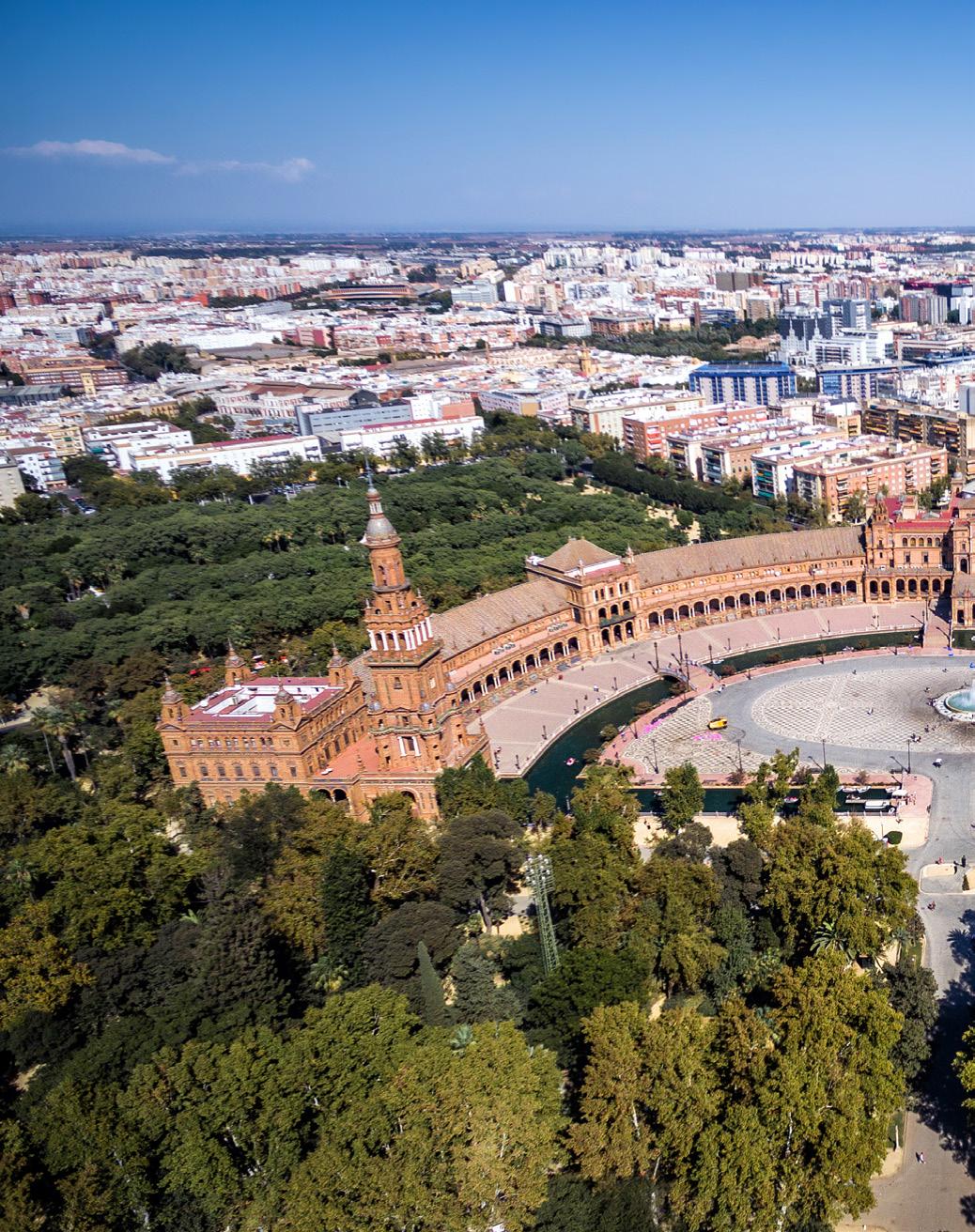
gypsy heroine, were embodied before us, as the dancer stamps her feet in a dizzyingly rapid succession on the flagstones.
Short on time, we forego the magnificent Catedral de Sevilla, and instead walk across town to what is known as the Cathedral of Bullfighting – the Real Maestranza de Caballería, the oldest bullring in Spain. Here we take a tour and get chills in the atmospheric chapel where matadors would make their peace with God and take one last sip of water from a humble ceramic jug sat in the corner before entering the arena. Afterwards, under the severed heads of young bulls that have been mounted on the walls, we sip small glasses of beer, known as cañas in Pepe Hillo just across the street, where locals would relive the drama of the bullfight over a drink after the show.




Before dusk falls, we cross the river and wander through the bohemian quarter of Triana, pausing for exquisite Iberian ham and Spanish wine on the rooftop of the Mariatrifulca restaurant on the Puente de Triana as the sun sinks into the water. With wine on our lips and smiles on our faces, we are full of excitement and hope. It is one of those precious travel memories that I choose to return to in these trying times, knowing in that moment that I will surely return to this city. Although it is January, the sun is bright and big. Just like an
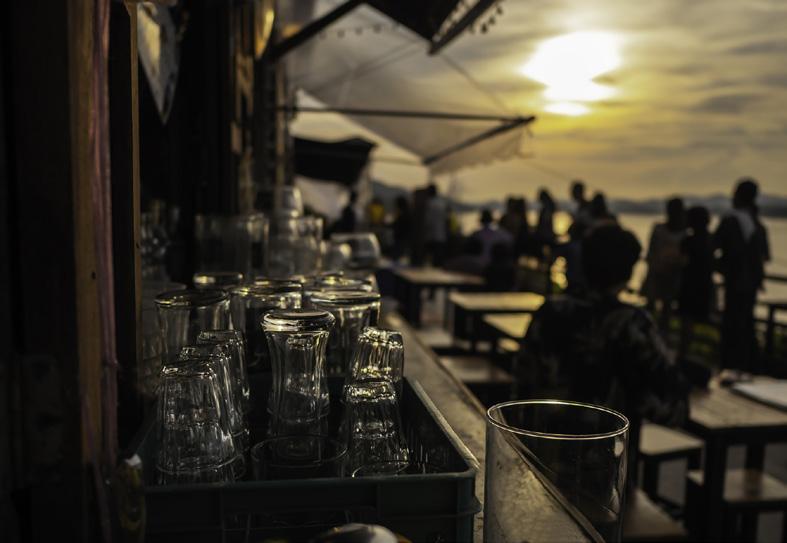
 Above and right: Plaza de España. Left: The Guadalquivir River and the dodecagonal form of the aptly named Torre del Oro. Below: The Real Maestranza de Caballería, the oldest bullring in Spain and seafood paella at the El Pinton restaurant
Above and right: Plaza de España. Left: The Guadalquivir River and the dodecagonal form of the aptly named Torre del Oro. Below: The Real Maestranza de Caballería, the oldest bullring in Spain and seafood paella at the El Pinton restaurant
BARBADOS
 Writer: Marcus Kääpä | Project Manager: Matt Cole-Wilkin
The Barbados Tourism Authority showcases the best of the island’s opportunities and leisurely experiences available to those wishing to visit
Writer: Marcus Kääpä | Project Manager: Matt Cole-Wilkin
The Barbados Tourism Authority showcases the best of the island’s opportunities and leisurely experiences available to those wishing to visit
BARBADOS IS A tropical paradise known for its stretches of beautiful white sandy beaches, the vivid greenery of its land and hills, and the impossibly serene coastal waters that sweep under the hanging leaves of swaying palm trees.
The island’s capital, Bridgetown, shows off these elements of Barbados. Sitting on the south-west corner of the country, Bridgetown mixes the natural beauty of the island with iconic colonial-era architecture, brought to
life with energetic Bajan culture. Away from the beautiful coast and lively city, the wilderness of inland regions offer limitless adventure.
And for those who visit Barbados, the opportunities for leisure activities, cultural and historical learning, and to experience a variety of traditional foods, drinks, and festivities, are boundless. With opportunities such as these, there is no wonder why the tourism industry is such a substantial contributor to the nation.

INDUSTRY INSIGHTS

THE BARBADOS TOURISM
Authority aims to increase travel to the island so that visitors can experience what it has to offer. As the nation has been somewhat reliant on tourism for the past few decades, maintaining the attraction of Barbados to its global customer base is highly important. But it also provides visitors with a unique experience they will not forget. For many, the perfect mixture of white beaches and tranquil waters is a rare and exciting prospect – a place to relax, sunbathe, and take in the vast ocean-filled horizon while the sun sets.
The Barbados Tourism Authority is focused on the maximisation of possibilities to all those who visit the island.
FESTIVALS AND ARTS
Various festivals are celebrated in Barbados annually. From January till December several venues on the island come alive in celebration for one reason or another.

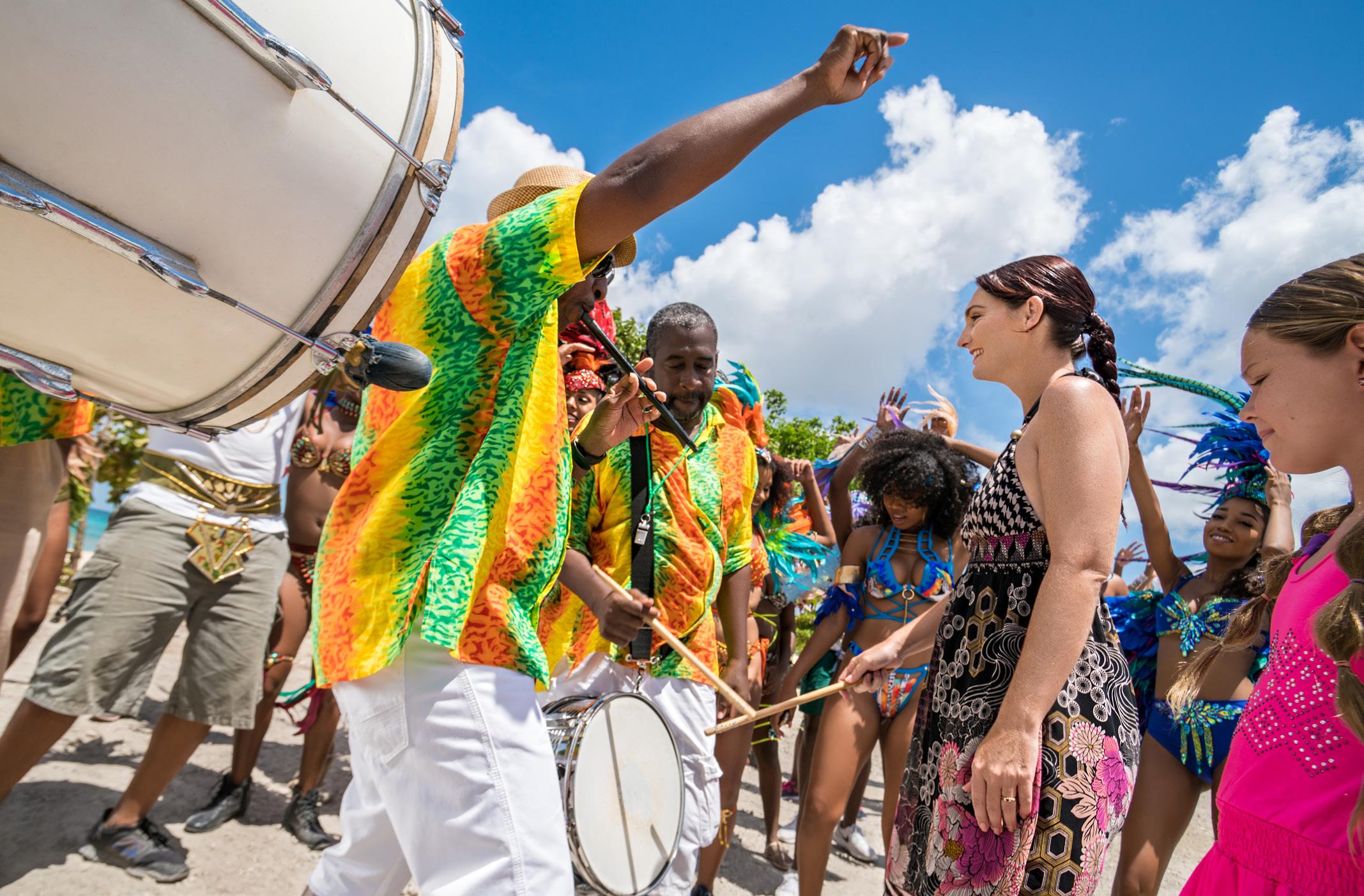
The Barbados Music Awards starts
the celebrations in January, followed by the Holetown festival in Holetown St. James in February. Agrofest, an agricultural fair also takes place in February in Queen’s Park in the capital Bridgetown. March offers festivals catering to the foodie and to the horse racing enthusiast. These festivals are Oistins Fish Festival in Oistins, Christ Church and the Sandy Lane Gold Cup held at the Historic Garrison Savannah. The Barbados Reggae Festival which culminates at the historic Farley Hill National Park in St. Peter keeps the festivities pumping in April. Gospelfest a Christian celebration of poetry, dance and song is also staged at Farley Hill in the month of May.

The remaining months of the year consist of several other festivals inclusive of Visual Arts, Pan Pun De Sand, NIFCA (National Independence Festival of creative Arts) and Run Barbados to name a few. The variety of festivals on offer cater a myriad of interests and are sure to intrigue.
The largest and most important festival in Barbados however is Crop Over, which celebrates the end of the sugarcane harvest. This summer festival is celebrated over several weeks and includes fairs, fetes, parades and contests. Crop Over culminates on Kadooment Day. This day features an explosion of colours, food and masqueraders dancing rhythmically to the pulsating beats of Calypso along the streets towards Brandons Beach on the
Spring Garden Highway. It is truly the sweetest Summer Festival.
TRAVEL PROMOTION
The organisation has actively developed its online presence for an increasingly digital age. On top of email subscriptions and other forms of contact, its website, www.visitbarbados.org, showcases a huge variety of places, activities, and events that occur around the island – a platform that provides access to knowledge about Barbados with amazing ease. If you were unsure of what Barbados had to offer, and you wanted to maximise the opportunities at your fingertips, the website provides visitors with a range of informative points through which to ensure that they can experience everything they wish to and more.


The website also allows visitors to learn about the best locations to stay, help with holiday trip planning, and even a podcast that keeps you up to date with the latest in goings-on in Barbados allowing those who wish to be as informed as possible.
In the face of the world-changing COVID-19 pandemic, the organisation has worked to introduce a 12-month Barbados Welcome Stamp. This is a new remote work programme
Your Barbados experience is incomplete until you’ve sampled our oldest and greatest export, rum. Discover the story, the mysteries and the secrets behind our finest and most celebrated spirit. Make sure to book a Barbados rum tour - you’ll be glad you made the journey from beach to bottle



that can provide a visa to eligible individuals and allows them to work remotely within Barbados for up to 12 months – a brilliant opportunity for people wishing to work abroad.
The visa can be granted to anyone who meets the visa requirements and those whose work is not bound
by a specific location, whether they are individuals or families. This stamp had given people the chance to work abroad, who otherwise may not have been able to do so.
WHY VISIT BARBADOS?
For the Barbados Tourism Authority, the main reason to promote Barbados is of course its weather, tropical climate, and coastal holidaying areas for the average visitor to relax, enjoy, and kick their up feet with a rum-based cocktail.

But there is more to the island than the stunning geography. The Bajan culture of the island includes celebrations and parties, unique cuisine, and many other specific customs and traditions that are brilliant to experience and take part in. From urban nightlife, shopping facilities, and spa treatments, to world heritage sites, culture tours, and wedding
planning, Barbados is an island of many wonders.
One such culture tour is the visitation to rum distilleries, of which there are several on the island, including multiple within the capital. Barbados is known as the “birthplace of rum”, boasting the smoothest and most delicious rum taste in the world. The country has been producing the “Caribbean elixir” for over 350 years, the oldest rum of which visitors to the island can try from Mount Gay Rum Distillery in Bridgetown. After indulging on the sweetness
of rum, you can expect to find a high-energy evening environment at local bars and restaurants where you can dine on a variety of different dishes, local or international. Classic Bajan cuisine can be found to be a wonderful amalgamation of flavours and ingredients from around the world, such as chicken curry and beef stew, or the island itself, such as Flying Fish and Cou Cou (a combination of cornmeal and okra).
And in the light of the tropical midday sun facilities all over the country allow visitors to fulfil their
“BARBADOS HOLIDAYS CAN INCLUDE MUCH MORE THAN JUST BEAUTIFUL BEACHES AND THE GREAT OUTDOORS. THIS VIBRANT ISLAND PLAYS HOST TO AN ASTONISHING ARRAY OF ANNUAL EVENTS...”
adventurous wishes. Surfing is a popular island-wide activity, and the coastal waters provide veteran surfers, or those who are simply keen to try it out, the perfect environment to make their surfing dreams come true. If surfing is not on your to-dolist, abseiling, jet-skiing, kayaking, and of course swimming and snorkelling among underwater wildlife in the warm ocean waters are just some of the water-based activities to be enjoyed – even the opportunity for a submarine journey into the deeper corals just off the island’s coasts!
Further inland there are rural beaten paths that wind their way into the green hills and through peaceful woodlands desirable for the active walker or hiker, and off-road bike hires are open across the island, and
safari tours enable visitors to witness native wildlife first-hand.
But on the flip side, if you are looking for a place to rest, relax, and watch the sun set with a cool drink in your arms, Barbados is the place to be.
EVENTS AND CELEBRATIONS
There’s always something happening all year-round in Barbados, so add to your Caribbean experience by planning your getaway around your favourite festivals and events.

Barbados holidays can include much more than just beautiful beaches and the great outdoors. This vibrant island plays host to an astonishing array of annual events including world-class sports, music festivals, theatre performances

and our much-loved Barbados carnival during the Crop Over harvest festival celebrations - called Grand Kadooment, it’s considered one of the best festivals in the world.

Check what’s on in Barbados before you travel, and make online bookings for popular events such as international cricket test matches at the Kensington Oval, our jam-packed Reggae on the Hill event, and the annual season of outdoor theatre and musical performances hosted in the sublime gardens of Holders Great House. Come and join us!

www.visitbarbados.org
“Discover one of the most beautiful lifestyle resorts in the Caribbean at the Accra Beach Hotel & Spa. Located on the South Coast of Barbados, this 4-star beachfront property offers 221 rooms, sparkling pools, 4 restaurants, 3 bars, on-site spa, event & conference facilities, a welcoming team and unparalleled relaxation to make your stay a memorable one. What are you waiting for? Book your reservation at thisaward winning hotel today and experience the Caribbean Dream!”
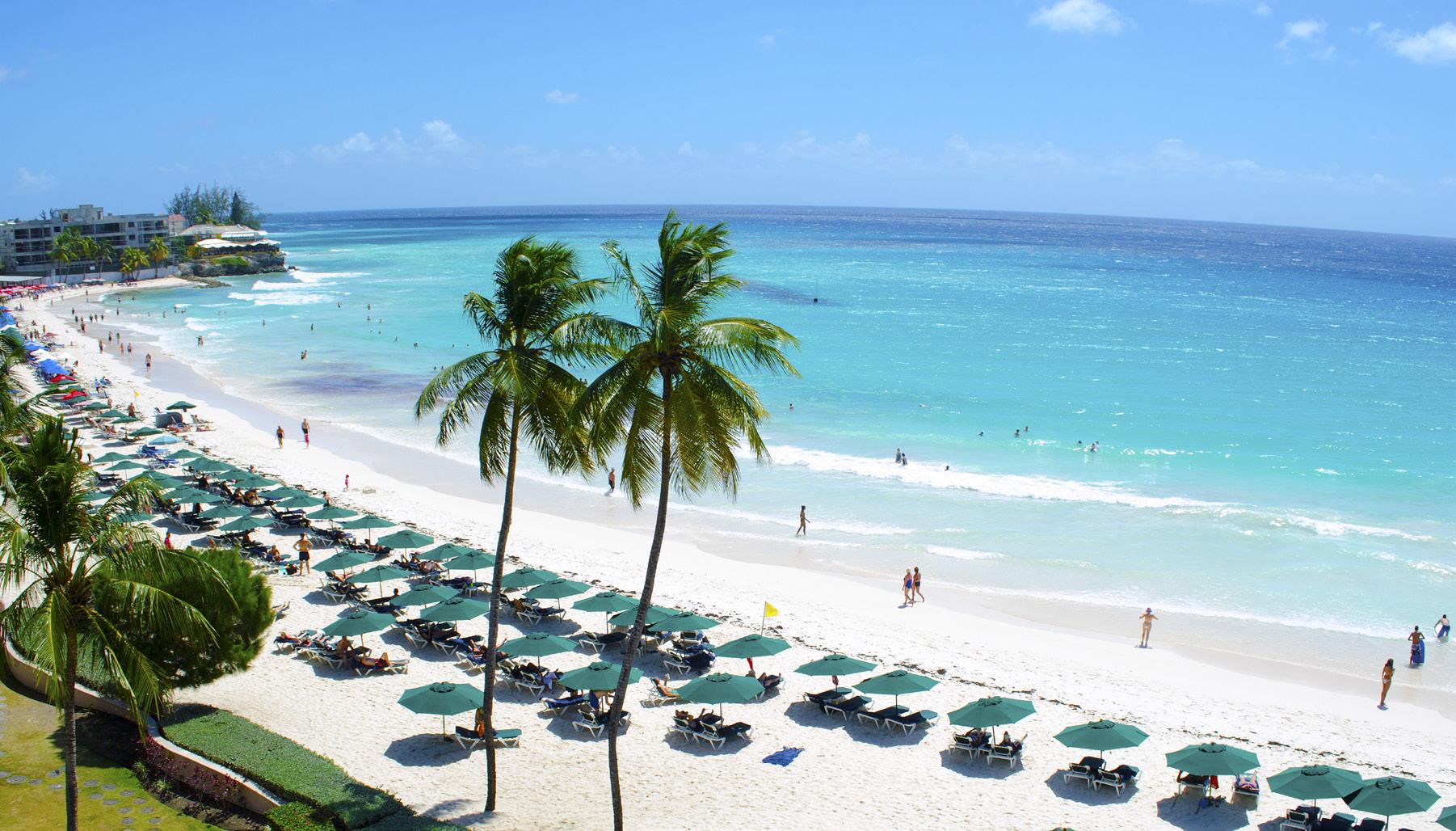
Activities
We have a business/activities centre which allows access to the internet, printing, faxing and photocopying services. One can also reserve off-site tours in the Activities Centre. On property, we offer a complimentary kids club for children ages 4 to 14 years where daily activities are organised, complimentary use of the games room with pool table, table tennis and board games, as well as the fitness centre. Adult activities are also arranged and can vary including trips to Bridgetown, walks on the board walk, fish feeding and games in the pool.
Room Categories
Accra Beach Resort & Spa boasts 221 rooms of 10 different categories: Island View, Pool View, Ocean View, Oceanfront, Deluxe Ocean View Suite, Pool View Suite, Penthouse Suite, Deluxe Ocean View Junior Suite, Oceanfront Suite and State Room.





Meetings
For meetings, the resort boasts of 4 meeting rooms and a board room with over 6,500 sq ft of meeting space. Additionally its beach-front, pool side and well manicured landscape sets the ideal scene for Gala Dinners with the ocean serving as an enchanting backdrop.
Happenings
There is never a dull moment to be had with so much to offer every day of the week, such as our Manager’s cocktail reception, the Curry & Kebab night, the Karaoke evening, the BBQ buffet dinner with floor show & live band, the Authentic Caribbean Sunday lunch buffet with live band, Three (3) Happy Hours daily, Yoga, Aqua Aerobics, Kid’s activities, Beach games, Organised tours and more!

You will instantly feel at home and relish in Abidah’s intimate ambience and unique charm. Be welcomed through our modern glass exterior framed by lush island greenery to discover forty-four (44) refined suites, all fitted with private balconies with spa pools; and boasting panoramic views of the turquoise ocean and lavish island greenery. Don’t forget to say hello to our very own Tipsy Tuk-Tuk Mobile Bar. You will come to be the best of friends during your stay.






We host casual dining by day and elegant dining by night, our very own Remous Restaurant and Lounge is known for its blend of exquisite interiors and lavishly inviting ambience. Our Chef’s take you on a tantalizing culinary journey with menu’s honouring traditional Caribbean favourites and international masterpieces. We offer seven different themed cuisines throughout the week for a dining experience like no other. Our 44 guest rooms harmoniously blend sleek, modern designs and décor with chic fabrics and stunning colour palettes that fashion a sense of Caribbean warmth and serenity with intimacy. Senses Studio Spa is a haven of tranquility created just for you. Amidst the very contemporary feel pamper yourself in an oasis of serenity tailored just for two. See the warming colour collaborations in the décor; smell the fragrance of unique blends waiting to relax your mind, body and spirit.
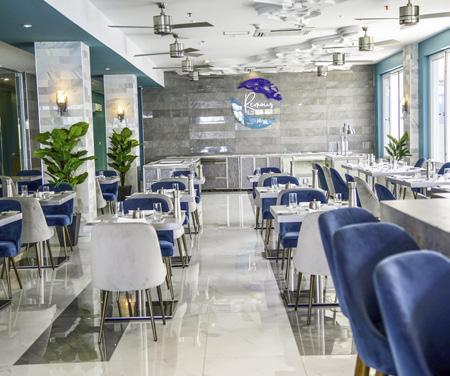
At The Abidah Hotel, we pledge to safeguard the health and wellness of all guests and our team. With safety as a prime concern, we urge you to take special care in following our safety guidelines as you enjoy your stay. Upon entering public areas, you will observe hand sanitizing stations which are located on all guest floors. Our Front Office reception area is outfitted with a sneeze guard and all team members are all equipped with face masks and shields for added safety, we urge you to be safe as well and wear a mask when in public areas or coming into close contact with persons outside of your room.
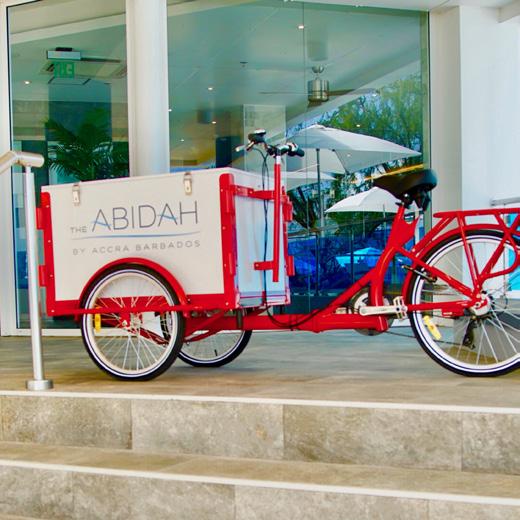
 Welcome to The Abidah by Accra, sister property and newest addition to the Accra family, a majestic all-inclusive adult-only boutique hotel overlooking the pristine waters of Enterprise Bay.
Welcome to The Abidah by Accra, sister property and newest addition to the Accra family, a majestic all-inclusive adult-only boutique hotel overlooking the pristine waters of Enterprise Bay.
OUTLOOK RECOMMENDS
FOR BUDGET TRAVELLERS…
EAT: A SOCIAL AND LIVELY ATMOSPHERE… Harbour Lights
FOR LOCAL CUISINE IN A LAID-BACK ENVIRONMENT…

Cutters of Barbados
IF YOU FANCY INTERNATIONAL OR ASIAN…
Nishi Restaurant
SLEEP:
TO EXPERIENCE EVERYTHING THE ISLAND HAS TO OFFER…
Accra Beach Hotel and Spa is home to a variety of luxury opportunities, from its relaxing pools to its high-end dining experiences, and of course, its extensive range of spa treatments that cater to all your leisure needs. Situated on the beautiful coast of the capital Bridgetown, Accra combines the opportunity for ocean-based activities, urban culture trips, and inland experiences, giving you access to everything Barbados has to offer at your fingertips.
FOR A HIGH-END AND COMMUNAL STAY…
Sandals Barbados
FOR A RELAXED STAY WITH A PARTNER…
Yellow Bird Hotel
DO: TO SAIL THE OCEAN AND EXPLORE WHAT’S WITHIN…
Barbados Catamaran Snorkelling Cruise
FOR THOSE WHO WISH TO EXPERIENCE CLASSIC MEALS…
Street food walk tour
IF YOU WANT TO TRY THE SPIRIT OF BARBADOS…
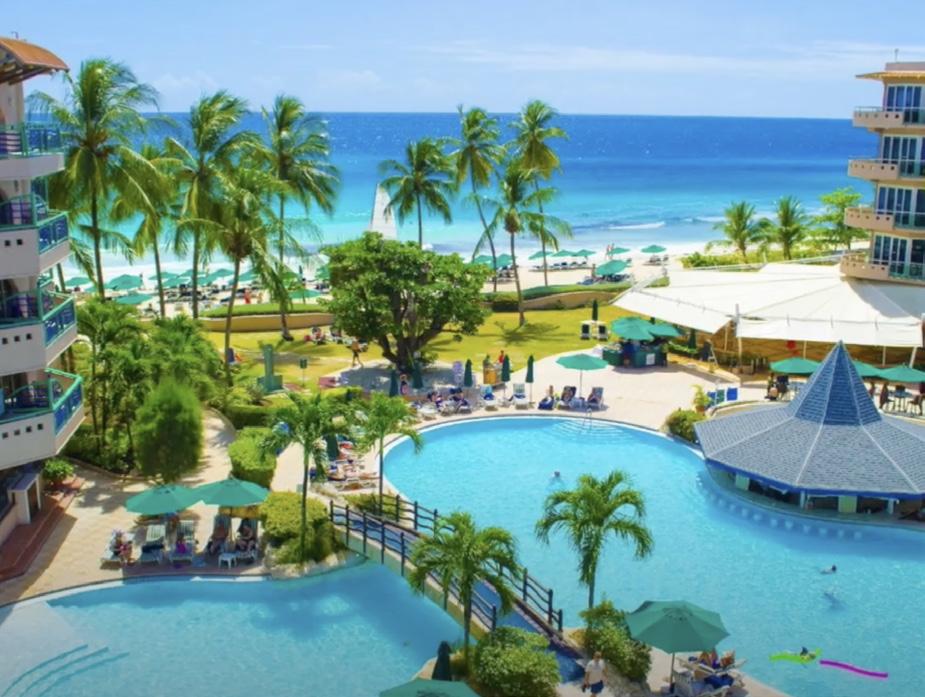
Mount Gay Rum Tour

BRIDGETOWN IN FOCUS
THE THRIVING CAPITAL of Barbados, Bridgetown is a hub of energetic celebration and an experience for the senses.



During the day, the city is home to an array of shopping opportunities, from malls to unique street markets where visitors can browse the ranges of traditional wares and try out exotic street foods on offer. Favourite local eateries supplying authentic Bajan food can be discovered in walking food tours of the city, allowing tourists to experience the delicious dishes unique to the island’s people if visitors fancy a different experience to restaurant dining.
The variety of historic buildings present harken back
to the nation’s colonial past, including a 17th-century garrison and horseracing track, and its culture born of a diverse mixture of international influences. Shipwreck dive sites and locations such as Browne’s Beach add a sense of adventure to the city, allowing visitors to take part in a multitude of activities unique to Barbados, and unavailable in other urban areas of the world.
The city’s rum distilleries are a chance to try out the country’s national beverage in all its natural glory. Some of these institutions have been around for hundreds of years and they are as deeply rooted in the island’s culture as the various celebrations enjoyed throughout the year.

LANDMARK ATTRACTIONS
MORGAN LEWIS MILL
Interested in the history behind the island? Morgan Lewis Mill is one of the last sugar mills to have operated in Barbados, now converted into a museum for any visitor open to exploring the rich history of the nation.

BATHSHEBA BEACH

Bordering the Atlantic Ocean, Bathsheba Beach is a haven for surfers and those interested in aquatic life. Here, the sea rocks the coast with dramatic waves ideal for those keen for water sports. The power of the waves along this coast is shown in its erosion, that have formed a multitude of rockpools ideal for aquatic life in the shallows.
CARLISLE BAY, BARBADOS
The central beach of Bridgetown, Carlisle Bay is a made up of white beaches stretched beside tranquil waters. It is a picturesque area of the coast, popular with swimmers, scuba divers, and thrives next to a hub of urban activity.
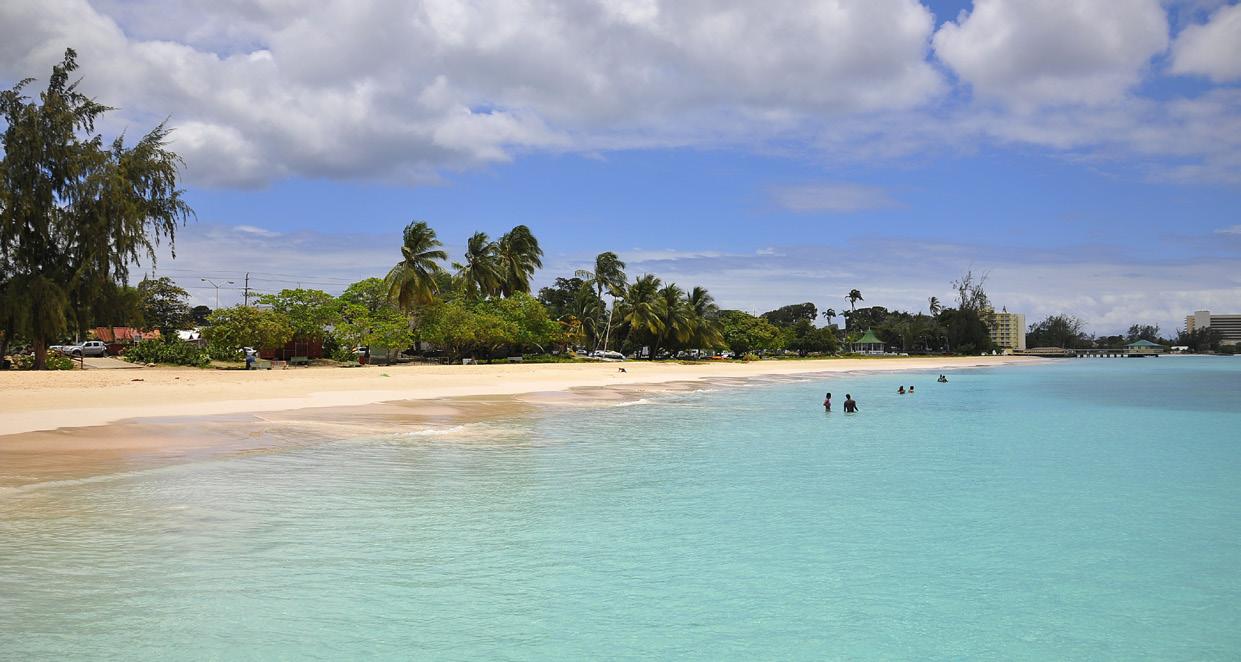

GETTING THERE AND AROUND
VISITORS WILL ARRIVE via plane at the Bridgetown/Grantly Adams Airport, where they can reach the capital within half an hour by taxi or car hire. Once in the city, visitors can take buses or hop in taxis for short car journeys to specific locations or hire a car in the city centre to explore the island freely for a unique and personalised adventure.

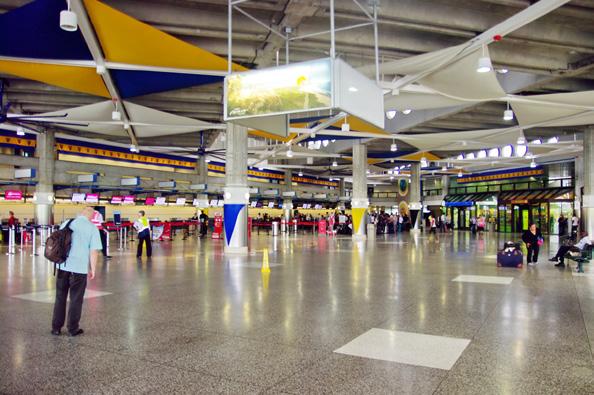



In the capital everything from pristine white beaches, to hotels, restaurants, bars, markets, and historic sites are all within walking distance. If you fancy going further afield while enjoying the fresh air, bike hire is always available. Alternatively, visitors can enjoy a luxury cruise to and from Barbados and take to the seas aboard several different ships to reach the various coasts of the island.

Established in 1882, Kensington Oval is Barbados’ oldest cricket ground. The ground was expanded and upgraded from its 4 acre pasture land of Kensington Plantation, to the prestigious, over 7 acre ground we have come to know as “the Mecca” of cricket in the Caribbean. After its redevelopment for the hosting of the ICC Cricket World Cup’s 2007 Championship, this multipurpose facility has evolved into a landmark venue hosting some of the island’s most monumental and prestigious events in sports and culture.




Next time you visit Barbados be sure to include a Tour of the Oval, and walk the hallways graced by the cricketing greats such as the 3W’s (Worrell, Weekes & Walcott), Joel Garner, Sir Charlie Griffith, Desmond Haynes, Sir Ian Botham and Brian Lara. Take the opportunity to have a photo with the only statues of His Excellency The Right Honourable Sir Garfield Sobers and the Reverend Dr. Sir Wes Hall. Come experience a once in a lifetime opportunity to walk the grounds and touch the grass, which has hosted some of the most memorable matches in the history of the sport. Enjoy the exclusive views of the President’s Suite, Hospitality Suites, and the Players Pavilion, and take home exclusive memorabilia available only at the Kensington Oval Gift Shop. All this and more awaits you!
Our social media pages are a great destination to experience the sites and sounds of the stadium when it is brought to life as well as to get insights and see the latest activities happening at the ground.


Please visit the website and social media pages for tour schedules and other information about Kensington Oval.


QUINTANA ROO
With its idyllic beaches, lush tropical scenery, ancient Mayan ruins and lively nightlife, Quintana Roo really does offer something for everyone
 Writer: Dani Redd | Project Manager: Krisha Canlas
Writer: Dani Redd | Project Manager: Krisha Canlas
This Mexican state is located on the Yucatán Peninsula. It boasts 400 kilometres of white-sand beaches lapped by the azure Caribbean sea, while its northernmost tip juts out into the Gulf of Mexico.
Picture vibrant coral reefs and lush jungles; soft sand beaches and subterranean cave systems. Its offshore islands, such as Isla Mujeres, make for idyllic tropical escapes. Understandably, the region is much visited by international tourists, and has been experiencing a development boom, with more and more luxury hotels being built every year. While this means there is no shortage of accommodation to choose from, the state must work hard to preserve its pristine natural environments. Luckily, it has an innovative and thriving conservation section. The Nature Conservancy and State Government of Quintana Roo recently set up a ‘Coastal Zone Management Trust’ to protect the coral reefs of the Mexican Caribbean.
Quintana Roo is known for its nightlife, with super-resorts such as Cancún renowned as party hotspots, followed by Tulum and Cozumel. Whether you’re interested in all night house parties, circus shows or sunset cocktails, you’ll find plenty of things to do once the sun goes down.
Another of the region’s many draws is its fascinating Mayan heritage. Visit the laidback capital of Chetumal for the intriguing Mayan Cultural Museum and to access Oxtankah, a timeworn Mayan city of temples and palaces, located on the coast. Tulum is the site of a preColumbian Mayan walled city, which offers stunning views across the Caribbean Sea.
INTERVIEW
QUINTANA ROO TOURISM BOARD
THE QUINTANA ROO Tourism Board (Consejo de Promoción Turística de Quintana Roo) was created to develop strategies to position and promote the Mexican Caribbean and all its destinations. The Mexican Caribbean is the umbrella that integrates two regional brands plus 12 tourist destinations.

This board is responsible for managing said brands, creating a unified strategy for its products and strengthening the unique attributes of the region through the development and implementation of actions in different areas, such as strategic planning, marketing, promotion and public relations. It seeks to achieve greater benefits for local communities, entrepreneurs, professionals, associations and the entire sector.
Outlook Travel spoke to Darío Flota, Director General of Quintana Roo Tourism Board, about the organisation and the destination it represents.
 Josefa ‘Jo’ Tuamoto
Josefa ‘Jo’ Tuamoto
Outlook Travel (OT): What are your organisation’s current goals?
Darío Flota (DF): We aim to continue to inspire travellers from our top markets, regaining their trust and presenting our destinations as the best options to discover and explore now, while contributing to the sustainable development of the cities and communities in the state.
OT: How has COVID-19 affected the tourism industry in Quintana Roo, and how are you helping local businesses recover?
DF: Quintana Roo is a state that heavily relies on tourism; for every peso earned in the state, 50 cents are produced by this industry. Tourism generates approximately four jobs per hotel room – the Mexican Caribbean has more than 100,000 rooms that represent approximately 450,000 jobs. Fortunately to this date, we have recovered over 50 percent of the jobs that were lost due to the pandemic.
We have been working on timely and assertive communication with all our audiences of interest and establishing strategies for each one: airlines; tour operators; hotel groups and associations; meeting planners; online travel booking platforms; and, of course, the visitor.
In April we launched the campaign “Paradise Can Wait”, followed by the campaign “Mexican Caribbean: The Best of Two Worlds” in May. At the end of June we launched an e-learning programme aimed at travel agents, available in six languages.


In addition, we have participated in more than a hundred online work meetings and business meetings, dozens of webinars, panels and done multiple interviews with national and international media.
OT: Congratulations on receiving the WTTC’s Safe Travel Stamp! What measures have you employed to ensure the safety of tourists?
DF: The reopening has been ordered and staggered to generate trust for both visitors and locals, following health security measures. Cancún was the first destination on the American continent to receive the Safe Travels’ global safety stamp approved by the World Travel & Tourism Council, which is the result of the efforts implemented by the state government during the ‘Mexican Caribbean Clean & Safe Check Certification’.
This certification programme, available for all the companies in the
tourism industry, aims to maintain the highest sanitary measures for the prevention and containment of COVID-19 and generate confidence among travellers, partners, and the community.
Over 7,000 companies to date have applied for the certification, which reaffirms the commitment of the destinations to the safety and health of our visitors.
OT: How do you promote off-season travel (i.e. during rainy season)?
DF: Even if travellers come for the pristine beaches and turquoise waters, they will be surprised to find an extensive array of outdoor activities that can be done in all types of weather. For example, cenotes are great because they can be enjoyed even when it is raining, where the water has a consistent temperature all year round. Travellers are encouraged to visit nearby cities and communities as well as archaeological sites, which
are a good option rain or shine. We have a dozen archaeological sites in the Mexican Caribbean.

With so many attractions and parks, it really comes down to what the visitor is looking for. Seasoned travellers usually book their vacations during off-season, taking advantage of lower rates and undisturbed landscapes.
OT: Are there any interesting projects in the pipeline you wish to highlight?
DF: The Mexican Caribbean attracts new investors every year, and in 2021 will open recognised hotels like Planet Hollywood Beach Resort Cancún, Planet Hollywood Adult Scene Cancún -Costa Mujeres, Nickelodeon Hotel & Resort Riviera Maya, Margaritaville Island Reserve Riviera Cancun by Karisma, Waldorf Astoria Cancun and some other properties in Isla Mujeres, Puerto Morelos, Costa Mujeres and Tulum.
OT: Why, in your opinion, should someone visit Quintana Roo?


DF: As social distancing changes the way we travel, the Mexican Caribbean stands out as a safe and comfortable region owing to its wealth of activities and sights, many of which are naturally socially distanced among an iconic landscape of sea and shore. It also has incredible natural themed parks, cenotes, caverns, spas and offers unmatched culinary experiences.
It has one of the most connected airports in Mexico, receiving flights from the United States, Canada, Europe, and other cities in the country. From north to south, it has more than 100,000 hotel rooms to accommodate all kinds of travellers.
OT: What trends are transforming the tourism industry in Quintana Roo and how are you utilising them?

DF: Along with a surge of eco-hotels, recycling standards, and immersive
nature tours, the growing eco-tourism movement thrives in the Mexican Caribbean.

For us responsible tourism is a priority – we are directing our efforts to promote activities that have a lesser impact on the natural environment. Visitors are invited to identify and take part in experiences that not only highlight the customs and traditions of the destinations but also emphasise the importance of the environment, contributing at the same time to the wellbeing of the community.
Various tourist suppliers dedicate their efforts to highlighting the attributes of the region, especially its magnificent natural settings in destinations like Maya Ka’an and Grand Costa Maya, with tours and activities that go from a walk surrounded by lush flora in the middle of the jungle, swimming in the turquoise waters, to personalised experiences for smaller groups alongside local communities.
OT: Are you optimistic about the future of the tourism industry in Quintana Roo?
DF: We have seen a rise on the number of flights and reservations for the upcoming months, so we are hopeful. Cancún International Airport has continued to see an increase in flights since the reopening in June, reaching a new peak every month, proving the continued interest of travellers worldwide.
The traveller is now more than ever looking for places to disconnect and relax, and our destinations offer a wide variety of options. This type of traveller also chooses destinations which they have visited before because it gives them trust. It should be noted that 55 percent of the tourists who have arrive here are repeat visitors. They recognise the quality of the services and have confidence in our destinations.
TRAVELLERS…
Grand Royal Park Cancún offers everything you could possibly need for a relaxing holiday – two lagoon-like pools, a spa and yoga studio, four tasty restaurants, all-day meals and snacks, and a loaded activity programme including watersports. What’s not to love? FOR UPMARKET

ISLAND ACCOMMODATION…
Grand Royal Park Cozumel offers upmarket and upbeat all-inclusive accommodation on the island of Cozumel. The resort features a secluded beach club, accessible through a private underpass from the main garden, two infinity pools, two partying deck lounges and onsite fine dining.



CANCÚN IN FOCUS
ONE OF QUINTANA Roo’s most visited destinations, Cancún is a mecca for beach lovers, attracting sun-seeking tourists in droves. The beaches that stretch out on either side of the resort are lapped by stunning aquamarine waters – travel north of the city centre to Isla Blanca for the least developed stretch of coastline.
Cancún is rightfully renowned for being a party resort – it has one of the best nightlife scenes in Latin America. The City, a nightlife complex of 8,000 square feet, has nine bars spread over three floors. It is known for its fantastic sound and lighting rig, as well as its roster of top international DJs and performers. Coco Bongo has a nightly fiesta, which kicks off with
acrobats and tribute bands, and ends with a three hour DJ session. Oh, and there’s a free bar.
If you aren’t a party animal there are lots of other night time options available. Head out for a delicious Mexican meal, washed down with a cold margarita. You can also take an evening boat tour around the hotel zone and the Nichupte Lagoon, enjoying the city lights from a distance. It is also possible to visit the adventure-filled Xplor Cancun Park during the evenings – go ziplining or kayaking by the light of the stars and fiery torches.
Cancún also has a quieter, more cultural side. Once you tire of the beaches and the nightclubs, this is a great place to find out more about

the ancient Mayans that once lived in the area. The Museo Maya de Cancún displays some 400 Maya artifacts on display, while the adjacent San Miguelito archaeological site is also worth visiting. Just south of the city you’ll find El Rey, which has a small temple and a couple of ceremonial platforms.
Being located on the coast, there are an array of outdoor activities for the whole family to enjoy, from kayaking to kiteboarding. There are some great diving and snorkelling sites, including a unique underwater sculpture museum. Outdoor enthusiasts will enjoy taking a day trip to nearby Isla Contoy – this uninhabited island offers decent hiking, birdwatching and snorkelling opportunities.
LANDMARK ATTRACTIONS
ISLA MUJERES

This picture-perfect island lies offshore from Cancún, and offers a quieter, more relaxed vacation. Enjoy scuba diving and snorkelling in its gorgeous aquamarine waters, or simply laze on one of the gorgeous beaches. The island has plenty of upmarket dining and accommodation options, and is an affordable option for those wanting a tropical island getaway.
TULUM RUINS
Tulum was one of the last cities built by the Maya, but now it lies in ruins (near the modern resort of Tulum). The ruins of this Pre-Columbian city are situated atop 12-metre high cliffs, with jaw-dropping views of the surrounding Yucatán Peninsula.

MAYA KA’AN
Maya Ka’an is Quintana Roo’s best-kept secret, an ecotourism destination comprised of a string of indigenous communities, surrounded by untouched beaches and jungle. Its sustainable, off-grid status allows visitors to really switch off and become immersed in local culture. Activities on offer include visiting the Cave of Hanging Serpents or following the same kayaking route once used by ancient Mayans.
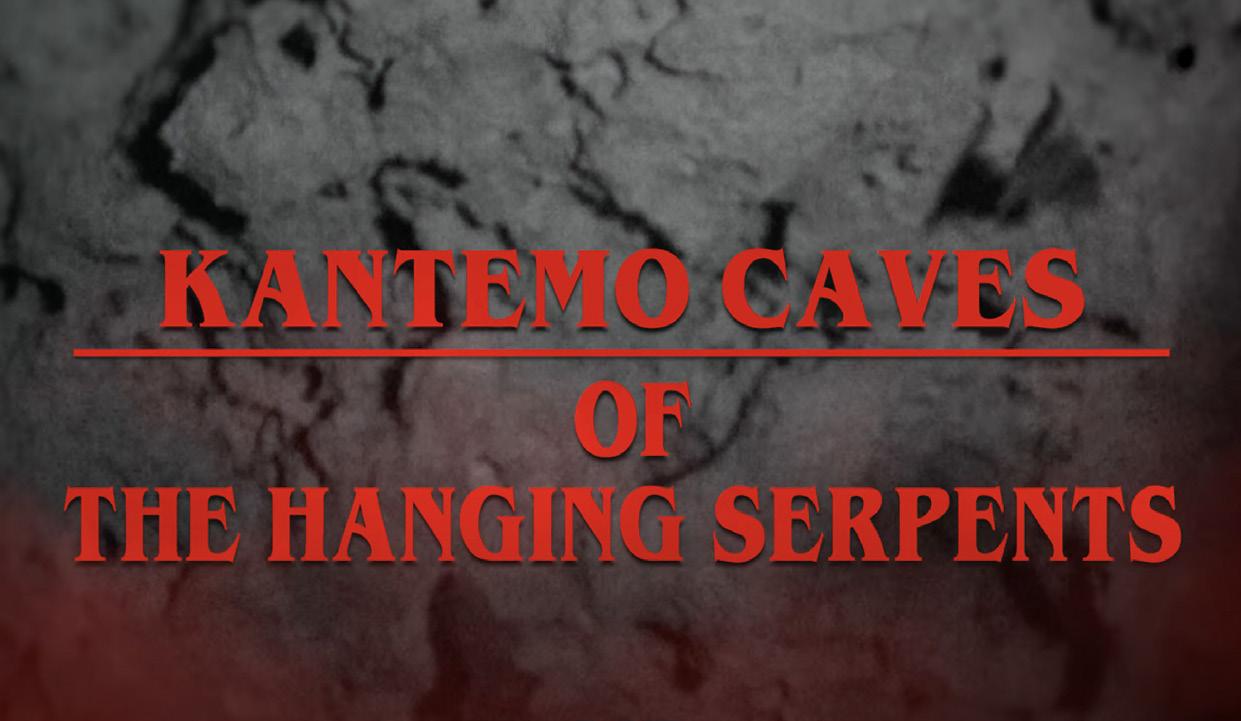
GETTING THERE AND AROUND
The region is well-served by major international airports – in Cancún, Chetumal and Cozumel – as well as smaller domestic airports. Cancún International Airport is the largest. It is one of the busiest airports in the Caribbean, handling 25,481,989 passengers across 2019. 44 airlines fly to 114 destinations across the Americas, Europe and Asia.

The route with the most departures is to Mexico City, meaning that business travellers to Mexico’s capital can easily incorporate a few days of leisure in Quintana Roo into their schedules.


The best way to get around once in Quintana Roo is by renting a car. The roads are good quality and driving conditions are fairly safe. If you don’t want to drive, Quintana Roo has an excellent network of air conditioned buses that connect to all the major tourist destinations in the region. To visit the region’s islands, take a ferry – it’s a relaxing way to travel.
Many of the cities in the region, such as Cancún, have extensive and affordable public bus networks. It is also possible to get a taxi, if you want to travel to a destination more comfortably and quickly.
TRIPPERS TRAVEL BUSINESS
Despite the travel industry undergoing a year of unprecedented disruption, a new app is about to be born
Writer: Sean Galea-PaceMANY PEOPLE AROUND the world maintain a passion for travelling and exploring new places.
But the process of turning that into a reality can sometimes turn into a time-consuming and arduous task. Luckily, helping to streamline the travel planning process is Trippers.
Trippers is a platform enabling seamless and remote end-to-end group travel planning. It is a bundled service which allows a group to prepare an entire trip, from the early stages of deciding where to go, to booking the best flights for everyone in the traveling pack, all the way through perfecting the itinerary to the point of deciding where to stop for coffee.

“We save travellers time, a commodity young generations value more and more, by optimising the travel planning process,” explains Charlotte Franzellin, CEO and Founder of Trippers.
“And we do so by putting personalisation at the forefront and allowing for 24/7 planning anywhere in the world.”
Having been founded in 2020, the inception of Trippers is an interesting story. Having just returned from the United States, Charlotte began to recognise the true value of Europe as a short getaway hub.
“I spent a few years juggling a nine-to-five job while harbouring an ambition to discover all four corners
of the globe with my friends - I was spending all my free time planning the next trip. The more I planned, the more inefficiencies I found, and that’s how the initial idea for Trippers came to be.”
And so, Trippers was born. Unfortunately, as a result of COVID19, the app’s launch was delayed until April 2021. The pandemic has disrupted all industries, but the impact on the travel industry was particularly tough. With this in mind, Charlotte reflects on the challenge of picking the right co-founders that would believe in her idea, particularly in a post-COVID world.
“The first test of any CEO/entrepreneur is being able to convince others of the potential of an idea, even when this idea seems crazy at first,” she explains.
“It is one thing to have people believe in you and your project in a business-as-usual world, it is a whole other thing to keep them believing in your project when the world as we know it disappears and a global pandemic hits. Working on a travel start-up in 2020 has not been an easy endeavour, but one we are certain we will get through stronger.
“As with most businesses this past year, we had to innovate and stay afloat. We’ve reconsidered time and time again our value proposition in a COVID world and have decided to focus Trippers on what we see our core market to be in the coming years, young millennials and Gen-Z waiting to reunite with their friends after a year of isolation.”
Charlotte believes she understands why so many trips fail in the planning stage.
“It’s a whole host of things. There could be a reduction in the initial momentum, lack of follow-up or leadership, all things we aim to provide with our bundled end-to-end solution,” explains Charlotte.
“Groups need handholding to get through the planning process, and nobody wants to have to do this for everyone else. We become the central platform managing everyone’s expectations, nudging when needed and narrowing down options to simplify the decision-making process.”
The app prides itself on two core features — its city finder and itinerary maker. It doesn’t just select cities based on taste and preferences; it combines what everyone likes with what is realistically feasible.
“There’s no point in us suggesting you visit Rome because you all love great food, art and want to go somewhere warm if flights for the dates you’re looking at are way out of budget or if one of you would only be able to get there a day after everyone else,” she says.
“With so many considerations to have when planning a trip as a group, especially if you all live in different cities, we’re analysing the flight options before we even suggest the right destination for the group as a whole.”
With the city finder considered a vital feature, Charlotte points to the itinerary maker as another key cog in the Trippers machine.
“It’s ultimately been created to save
THE PATH TO
TRAVEL
PLANNING
Charlotte Franzellin, CEO and Founder
by providing flexibility for travellers to change their plans on the go. Don’t feel like visiting that museum anymore? Find other recommended activities nearby that would fit your existing plans!”
Trippers’ app would be impossible without artificial intelligence (AI). The intelligence behind Trippers is complex and comprehensive and requires the juggling of a number of variables, she comments.


According to Google research, it averagely takes 53 days to plan a trip, during which time 28 different websites are visited over 76 sessions. While in 2019, Jessica Silber, director of global sales at GeoEx, noted that travelers should expect a lead time of around ‘six to eight months.’ These timescales showcase the importance of what Trippers brings to the table. Trippers is unique in that it covers a segment of the market that has been completely put aside by the industry, the growing trend of young people travelling together as a way of experiencing the world.
“The algorithms powering Trippers are the result of more than a year of hard work perfecting them to reproduce in a much faster way what anyone would be doing when trying to plan a trip with their friends.
“They are the backbone of Trippers, which was born as a challenge to automate the entire travel planning process. We wanted to get rid of many painful repetitive tasks in this process, like finding suitable flight options, and the endless back and forth messaging with friends to understand needs and wants. With all automation projects, the promises are great but the work to get there is tough and we are very happy to say we’re almost there.”
With its launch mere months away COVID permitting, Charlotte and her team have had to sit tight and remain patient for its unveiling. “Flexibility is a word we’ve learned over this past year and we remain committed to creating the best version of Trippers until Europe is ready to travel again.”
users time to enable them to make the most of the destination and the people they are travelling with,” she elaborates.
“We optimise the route based on opening days and time, where the group is staying and the duration of that stay. We also manage everyone’s wish lists, making sure every single person in the group is happy with the outcome. We take it one step further
And Europe isn’t the limit to Charlotte. Upon finally launching, she is already targeting expansion over the next few years. “After a first release for the European market, we hope to soon thereafter expand to North America, create a large group travel planning feature and explore avenues for the B2B sector.”
Interested in learning more about Trippers? Click here!
ESWATINI
The area that is now Eswatini (Swaziland prior to 2018) can trace its human activity back to the Stone Age (approximately 200,000 years ago) – the various artifacts discovered confirm this. This ancient region later derived its name from a king called Mswati II, a great warrior who expanded the borders of Eswatini.
Bordering both South Africa and Mozambique, Eswatini sits as an independent Kingdom blessed with a range of beautiful landscapes and unique wildlife.
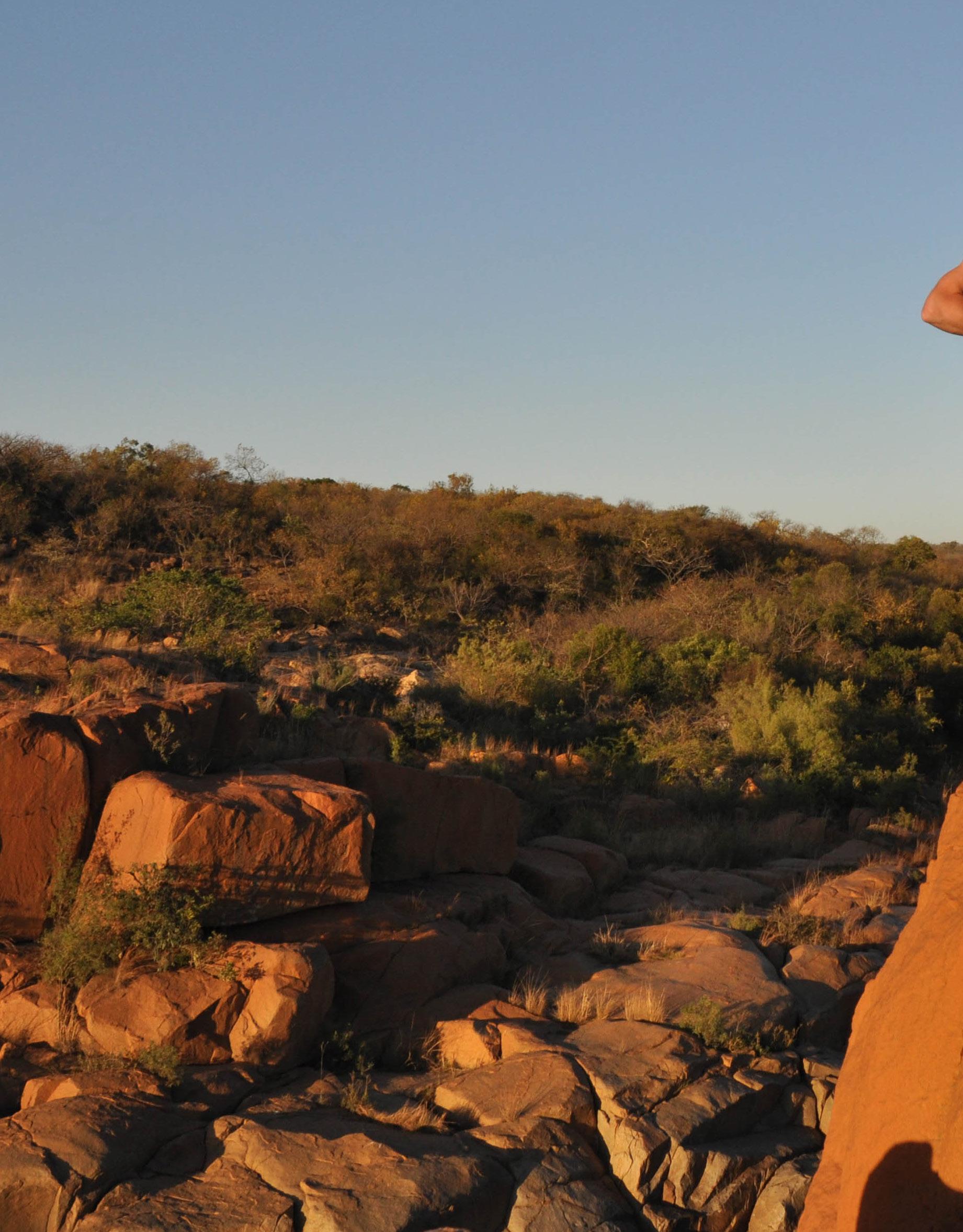
Along its eastern edge running beside Mozambique, the Lubombo Mountains tower over the landscape of Eswatini. These give way to montane grasslands as in the west backing onto the Drakensberg Mountains, and between these rainforests, mopane woodlands, and savannahs form the makeup of the Kingdom’s geography.
The Great Usutu River (also known as Maputo River) passes through the region from South Africa, and into Mozambique, and is the home to much of the wildlife in the Kingdom. Eswatini is well known for such wildlife, such as its rich variety of birds including predatory and exotic species of vultures and eagles. The critically endangered South-central black rhinoceros also makes its home in Eswatini - an awe inspiring sight for any visitor to lay their eyes on. Aside from the rarest of sights, African elephants, big cats (the lion and leopard to name but a few), herds of wildebeests, and hippos can be sights to see across the Kingdom.
A land of diversity, experiences, and beauty, Eswatini is home to exploration and wonderWriter: Marcus Kääpä | Project Manager: Krisha Canlas

INDUSTRY
INSIGHTS
ESWATINI TOURISM AUTHORITY
WITH THE ABUNDANCE of wildlife, dramatic scenery and unique culture, it is no shock that Eswatini has been for a very long time both an exotic and desirable location for those visiting Southern Africa. Amongst the industries that contribute towards the economy of Eswatini, tourism has also proved itself as a large provider of external investment within the Kingdom.

The Eswatini Government identified tourism as a sector capable of contributing meaningfully to the Eswatini economy and thus created a ministry responsible for it in 1996. The ministry was responsible for both tourism promotion and policy.
In 2001, the government, in a bid to further improve the industry, resolved to separate the tourism promotion issues from policy. Through an act of parliament, (the Tourism Authority Act in 2001), the Eswatini Tourism Authority (ETA) was established. The government’s vision in establishing
the public enterprise was to have a semi-autonomous organisation responsible for facilitating tourism development in the country and promote Eswatini as a premier tourism destination in Africa and abroad.
We spoke to Linda Nxumalo, CEO of Eswatini Tourism Authority, about the nature and future of Eswatini’s tourism industry.
Outlook Travel (OT): How has COVID-19 affected the tourism industry in Eswatini, and how are you helping local businesses recover?
Linda Nxumalo (LN): 2020 has been a difficult year for all industries, but

particularly harder for the tourism sector. Our research shows that the spillover effects from the COVID-19 outbreak and broken supply chains has led to faltering economic activity within the tourism industry. Tourism in Eswatini is heavily reliant on visitations from foreign markets and as such has been adversely affected by the travel restrictions on the international travel. International visitor arrivals to Eswatini in the first nine months of 2020 ending October registered 302 409 visitations, reflecting a decline of 69.3 percent in comparison a similar period in 2019. The former figure is indicative of the
considerable losses from the initially targeted 1.4 million international visitor arrivals for 2020. International bodies monitoring the economic and financial impact of COVID-19 have expressed uniform sentiments that as the virus weighs on the tourism sector, consumer confidence and spending power is constantly being sharply undercut. While Eswatini remains optimistic about mediumterm tourism growth prospects, the connotation of such a rapidly evolving situation is that tourism in Eswatini, at least in the short term, faces a dramatically altered picture. To assist industry to reboot their
business ETA has worked with the ministry of health and WHO to develop and distribute National covid-19 guidelines for the tourism sector to prevent the spread of the virus.
The industry was further trained on the guidelines and awarded safe travels certificates to boost visitor’s confidence.

ETA further provides marketing assistance to lure more visitors to come to Eswatini and also encourage Emaswati to visit locally. These includes social media Adverts, TV, newspapers and radio adverts both locally and in the region.
Take advantage of the fantastic safaris in Eswatini, home to the Africa fame Big Five, offering intimate and up-close wildlife experiences. Eswatini is recognised as one of the best places in the world for Rhino encounters



OT: Congratulations on being awarded ‘Best in Travel – one of the top 10 countries to visit in 2020 by Lonely Planet! What makes Eswatini such a great place to visit?

LN: Firstly, the Kingdom of Eswatini is one of the few remaining monarchies in Africa and we pride ourselves with our culture and heritage, which are deeply engrained in all our aspects of Swazi life. This enables us to give a unique memorable experience for all our visitors. Adding to our rich culture, the overwhelming friendliness of our people makes visitors feel home away from homehappy, relaxed, safe and comfortable.

Secondly, we have an incredibly diverse terrain with stunning views. We have stunning mountain scenery with rivers, waterfalls and gorges, unique rock formations which are amongst the world’s most ancient, lush and fertile valleys, plus typical African bush. With such a remarkable and varied ‘natural playground,’ there
is wide choice of activities available in Eswatini for visitors to explore and enjoy the scenic landscapes.
Thirdly, we have fantastic safaris and we are home to the Africa fame Big Five. We offer intimate and up-close wildlife experiences. Eswatini is recognised as one of the best places in the world for Rhino encounters. Our land is still a gorgeous piece of unmatched
bio-heritage and our reserves are still brimming with species of birds, full rivers and thick forests.
OT: Are there any interesting projects in the pipeline you wish to highlight?
LN: We have worked with His Majesty’s Government for the development of the Post COVID-19 Kingdom of Eswatini Economic Recovery Plan, wherein tourism was highlighted as one of the eight key sectors to stimulate the economy and lift it out of decline. The target is to implement new tourism projects worth about $31.2 million (according to the 12 December 2020 foreign exchange rate). These projects include a Fun City/Amusement Park and a National Aquarium to mention only but just a few.
Also, in line with the World Tourism Day 2020 theme, “Tourism and Rural Development,” we have partnered with the United Nations Development
Creating lasting Memories
Programme (UNDP) to train rural communities to identify and develop potential tourist attraction sites. We have already seen a number of interesting projects that we will be assisting communities to develop and rightly package. We are excited because these projects will provide jobs and economic empowerment, including for women and youth in these communities. They will also enable rural communities to protect and promote their natural surroundings, as well as their culture and heritage.
OT: What are you doing to encourage responsible travel and community tourism in the country?
LN: The Ministry of Tourism and Environmental Affairs is currently working towards drafting Ecotourism policy and strategy which will assist community entrepreneur’s access development grants. This will also create a definitive green tourism

product that will be an attraction within the destination. We have also previously worked and engaged with organisations such as the hiking organisation of South Africa mainly to create a standard for trail products and ensure that responsible tourism forms an essential part in tours. The Eswatini Tourism Authority also endeavours to advise communities on tourism opportunities within their areas or chiefdoms. e.g. ETA sponsored by UNDP recently held a function in Shiselweni region to advise community leaders on opportunities in tourism and further linked them with financial aid being grants or bank loans.
OT: Are you optimistic about the future of the tourism industry in Eswatini?




LN: Yes, I am very optimistic! As rightly stated in our National Development Strategy and Post COVID-19 Kingdom of Eswatini Economic Recovery
Plan, we strongly believe that tourism can be an engine of economic growth in Eswatini, capable of energising and rejuvenating other sectors of the economy.
Tourism does bring substantial economic and social benefits. It continues to create opportunities for small entrepreneurs, assist in preserving the environment, breeds a unique informal sector, create economic linkages with other sectors (agriculture, light manufacturing, health, beauty and entertainment), contribute to development of infrastructure, and provide dignified employment opportunities.
Old Mbabane Manzini Road, Ezulwini, H106 / Private Bag, Ezulwini | Tel +268 2416 5000 | www.suninternational.comRoyal Swazi Spa Hotel is the perfect getaway that merges affordable accommodation with a wide array of activities, set in the tranquil surrounds of the Ezulwini Valley. Comprising of Lugogo Sun and the Royal Swazi Spa Hotel, the stay is a quality experience for individuals, couples, and families alike. Whether you love golf, dining, or lying beside the outdoor pool, Royal Swazi Spa Hotel is the place for you.


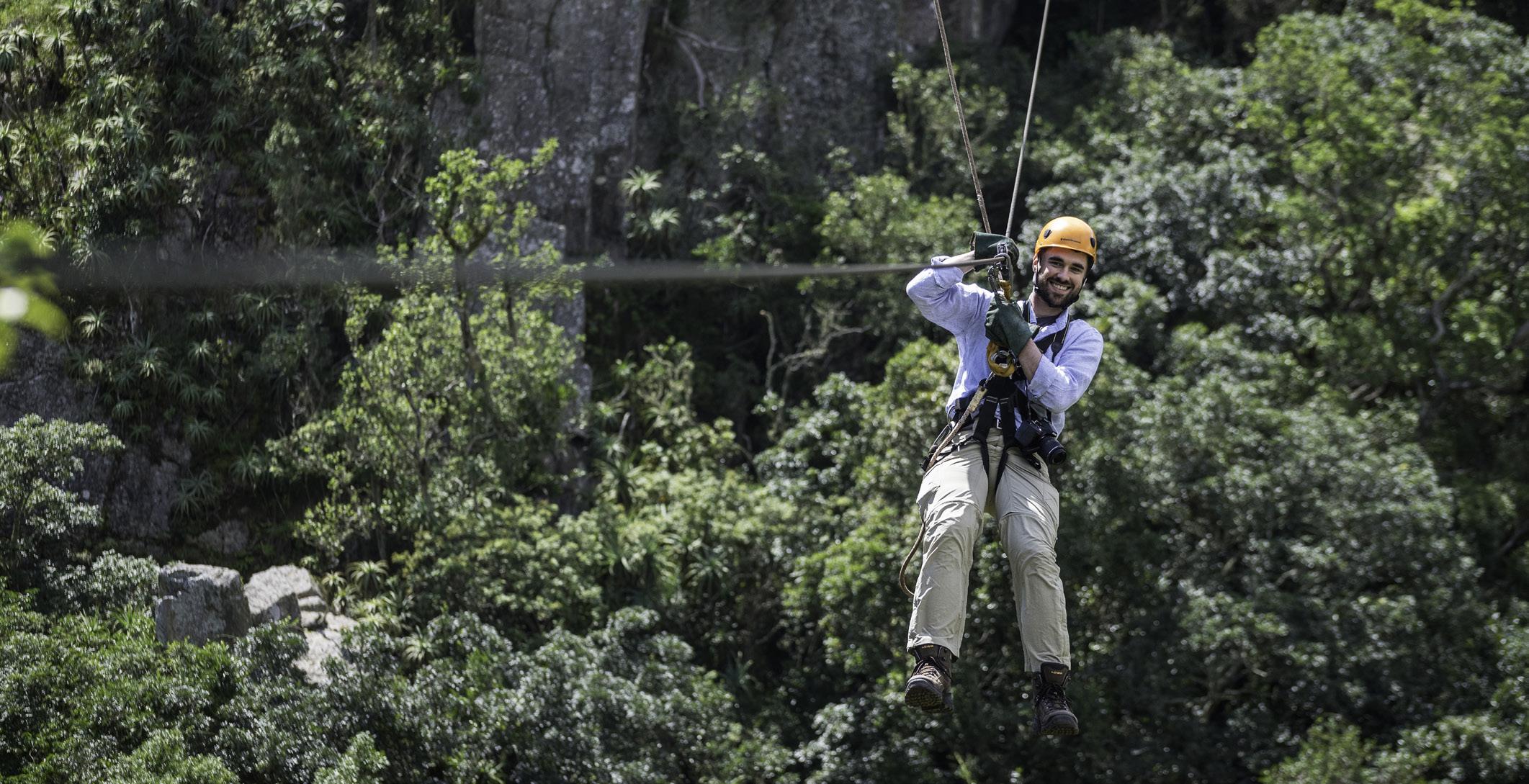
MBABANE AND LOBAMBA IN FOCUS
SIMILAR TO SOME of its continental members, such as Benin (Porto-Novo and Cotonou), Burundi (Bujumbura and Gitega), and Ivory Coast (Yamoussoukro and Abidjan), Eswatini prides itself on having not just one, but two capital cities. These cities are barely a 30 minute drive from one another, and while Mbabane is the executive capital from which the government of Eswatini is based, Lobamba is the royal capital and currently seats the royal family of the Kingdom.

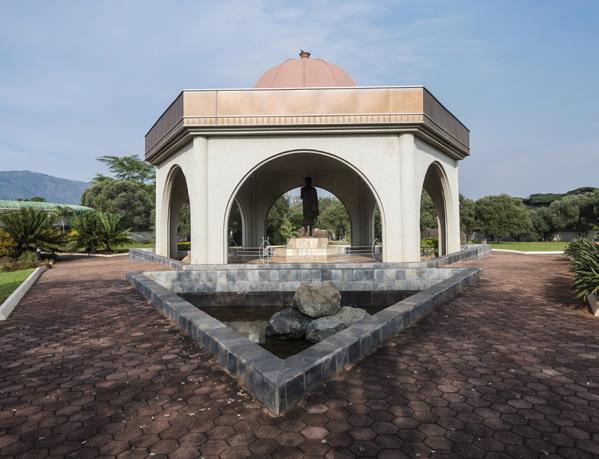


In and around each of these cities there is a tremendous number of things to do, see, and experience. Mbabane is home to a variety of outdoors activities for the eager adventurer. Exotic landscapes and animals lay at your fingertips as you venture out on walking tours or to wildlife sanctuaries close to the city.
Lobamba, the centre of Eswatini’s culture and traditions and home to King Mswati III, hosts an energetic spirit full of celebration, music, and festivities. Multiple ceremonies occur annually and will leave you marvelling at the experience. Markets bustle with trade where you can browse the ranges of traditional wares Eswatini has to offer, and beyond the cityscape the abundance of wildlife opportunities awaits.
Mbabane Mbabane market LobambaLANDMARK ATTRACTIONS
EXECUTION ROCK
At the summit of the Nyonyane Mountain an exposed granite peak marks the pinnacle of a popular hiking trail. The peak itself is known as Execution Rock and is both the location of Eswatini royal graves and a place rumoured to have been the end for many suspected witch or criminal – hence the name. The peak is an intriguing and exhilarating journey for the eager hiking fan, and great for taking in the beautiful surrounding landscape.


LION CAVERN
If you are interested in history, tours around the Lion Cavern showcase the world’s oldest mine, and how ancient inhabitants of Eswatini mined precious resources for weapons and tools. The cave itself is humbling in its age and reminds visitors of how far Mankind has come from its earliest mining examples. A place of history and heritage, Lion Cavern is a must-see for all who wish to learn of the archaic people that dwelt in the region.
NSANGWINI BUSHMAN PAINTINGS
Another culture tour for those who love to learn, the Nsangwini Bushman Paintings are an awe-inspiring example of prehistoric art. These multiple artworks, illustrating early Man’s lives and livelihoods are worth 1,000 words, and are a window into a past that existed before we had written language.

GETTING THERE AND AROUND
THERE ARE A great number of airfields around the Kingdom, but the primary airport is King Mswati III International Airport. Visitors will enter this airport and either take a taxi or hire car to the capital Lobamba, that should take less than two hours, or journey further to the second capital Mbabane.

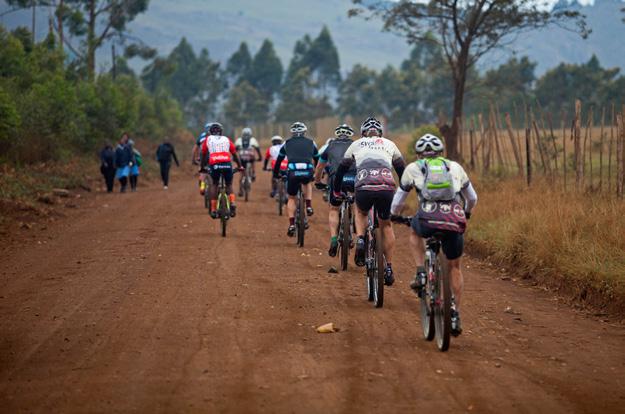
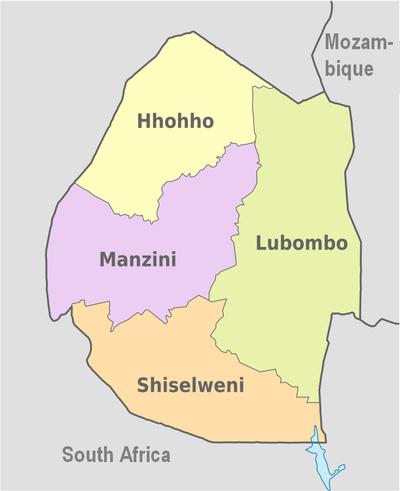

Once in the capitals, buses, taxi services, and car hires will allow you to journey throughout the Kingdom to visit unique and desirable locations. For travelling around the capitals themselves, simply walking or bike hires are an excellent way to visit urban monuments and experience the local culture and environment.



LESOTHO
BETWEEN 1820 AND 1823, King Moshoeshoe I, son of a minor chief from the Bakoteli lineage, took his people and settled the Butha-Buthe Mountain. Moshoeshoe allied with former adversaries in the face of the growing threat of South African King Shaka Zulu, and the Lifaqane (also known as Mfecane or Difaqane) – a period of widespread
chaos and warfare between communities that arose in the wake of his aggressive expansion.
Now, nestled in a high-altitude region of South Africa, the land-locked independent Kingdom of Lesotho is a hidden gem in the vast nation that surrounds it.
As a country elevated at 1,000 metres (3,281 feet),

A unique Kingdom set within a large nation; Lesotho is a high-altitude land of exploration for eager adventurers
Lesotho differs from its lateral African counterparts by its cooler climate, subject to snowy winters in its lowlands, to dramatic summer storms that see the most rainfall per area in the whole of Africa.
Marked by its lush grasslands, alpine meadows, jagged hills, and winding river networks, Lesotho remains a
country largely untouched by development, and a prime location for exploratory hiking, camping, cave visits, horseback trekking, and even snow sports during the colder seasons. And for those excited at the prospect of African wildlife, the country boasts a variety of exotic birds, reptiles, and mammal species endemic to the region.

INDUSTRY INSIGHTS
LESOTHO TOURISM DEVELOPMENT CORPORATION
THROUGH THE VARIATION of locations and activities, Lesotho has become a unique and exotic place to visit, and because of this, the tourism industry is essential to the Kingdom.

The National Development Strategic Plan (NDSP II) has identified the industry as one of the four pillars that drive the economic growth of the country, and the Lesotho Tourism Development Corporation (LTDC) is focused on reviving the sector in the wake of 2020.
LTDC is a parastatal organisation established in 2002, and its mandate is to develop and promote tourism in Lesotho. It is designed to provide leadership in the development of a strong and vibrant tourism industry
which contributes to sustainable economic growth, job creation, poverty alleviation, and protection of the natural and cultural environment through effective partnership with the private sector and the community in strategic marketing, research, product development, quality tourism and hospitality services delivery
and human resource development. Thus, its vision is to lead in successfully positioning Lesotho as Southern Africa’s must-visit mountain, culture, and adventure, and ecotourism destination.
We spoke to Sehlabaka Ramafikeng, interim CEO of the company, about the prospects of attracting more tourists to the Kingdom.

Outlook Travel (OT): How do you market Lesotho as a destination?
Sehlabaka Ramafikeng (SR): LTDC is currently marketing and promoting tourism in Lesotho through digital marketing platforms such as our state-of-the-art website www.
visitlesotho.travel. This showcases all the Lesotho Tourism’s magnificent and breathtaking products, places to visit, where to stay, attractions, historic sites, culture and heritage, tourism investment opportunities, tour operators, accommodation, and all essential tourism information.
This tourism portal is linked to social media platforms that are being updated on a daily basis to interact with the audiences, such as daily tourism related activities posted on the company’s Facebook, Twitter, and Instagram pages, and a newly developed Lesotho Tourism Guider Mobile App.
Due to hugely negative impact of COVID-19 pandemic to world travel patterns, the Kingdom of Lesotho has also suffered negatively like all other countries. Promotional efforts had to be implemented to continue create awareness and market Lesotho as a unique tourism destination locally by way of various platforms. The objectives are to showcase and educate the locals about tourism offerings in the country, to travel within the country and know more about places of interests but most importantly to spend money at those places of interests to uplift lives of the communities.

Through the joint marketing efforts and strategic partnership with a neighbouring South Africa, the Kingdom of Lesotho is a member of the Maluti Drakensberg Route (MDR) whose objectives is to jointly market and promotes the tourism products that are along the traverse route which go through Lesotho and South African provinces namely Eastern Free State, KwaZulu Natal and Eastern Cape Highlands.
OT: What are your organisation’s current goals?
SR: With the advent of COVID-19 pandemic, generally what is seems sure is that tourism in different country across the globe will rebound slowly
and mainly through local travel. This is because travellers tend to venture out closer to home and travel locally in order to gain confidence to travel farther away from home countries.
In our view, reopening and rebuilding tourism in this beautiful Kingdom in the sky calls for a joined-up approach. Thus, LTDC’s current goals include working together with businesses, government ministries and agencies to perfect and apply new health protocols for safe travel as well as to solicit support in whichever manner possible. By this we are aiming to restore travellers’ confidence as well as to stimulate demand for travel through our tourism promotion campaigns on social media.
Further, we are also leveraging on this crisis that has been brought by the pandemic to focus on comprehensive tourism recovery plans which this time around encourages more innovation and investment in preparation for when the sector is fully open, up and running, simply put, we are busy rethinking tourism in Lesotho because we believe whatever we do today will shape the future of tourism in our country.
OT: How do you promote off-season travel?
SR: The corporation always ensure important element of strategic partnerships with the tourism private sector namely tour operators and events promoters. A rainy season which starts from October to the end of March, is a period where the country is green, has magnificent mountain scenery and filled man-made dams as the Kingdom of Lesotho has an abundance of water. There are lots of tourism related events which are promoted through social media platforms, billboards advertising, radio adverting and print advertising. The most attended activities during off-season period include motorcycling race (world renowned Roof of Africa Rally), hiking, abseiling, water sports, music festivals.
OT: Are there any projects in the pipeline you wish to highlight?
SR: Semonkong Visitor Comfort Facility.
The Corporation is currently constructing the state-of-the-art tourism facility which is being developed with a view to establish a meeting place
for the tour operators and tourists together with the tour guides and the Semonkong community. This is the platform for the host community to create income making opportunities as thus enhance their livelihoods whilst the tourists experience is improved. This magnificent, breathtaking facility is overlooking at the Maletsunyane Falls which is the highest single drop waterfall in Southern Africa (192 metres) and it is also the highest commercial abseiling cliff in the world (206 metres).
OT: Why, in your opinion, should somebody visit Lesotho?
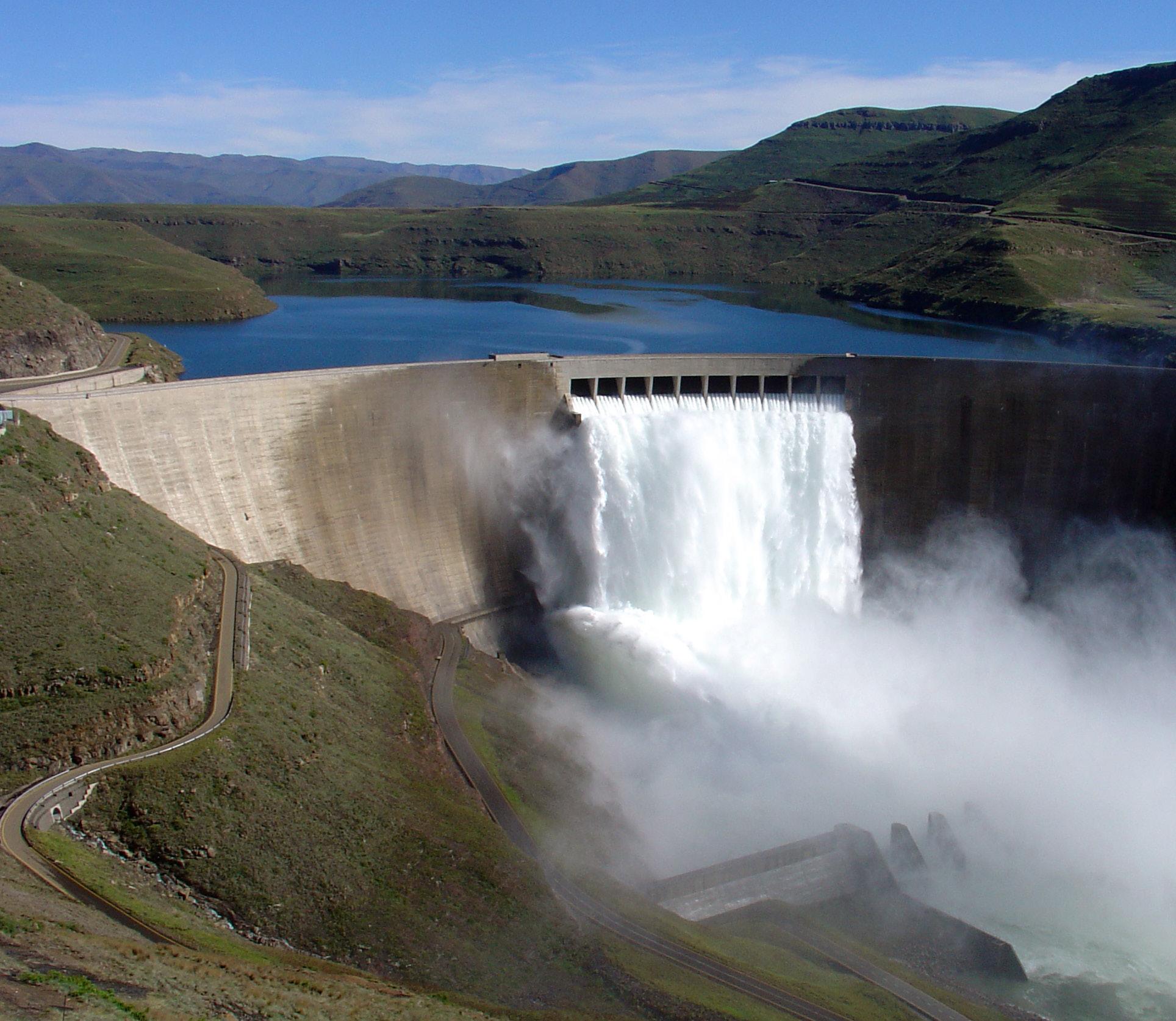
SR: Lesotho is a true African country, but there are some things which elevate it – literally – above many others. Its lowest point is 305 metres, the highest on the continent, and it also has the highest average height of any country in the world. Not surprising then that it also has the highest commercial abseil (in excess of 300 metres), the highest pub in Africa and the highest single drop waterfall in Southern Africa.
As one moves towards the southern and eastern sides, Lesotho becomes more and more beautiful. The country is generally clean, once away from the towns, and the sky stretches away forever with the most beautiful clouds reaching up to incredible heights, casting showers in the far distance. Little streams cascade down mountainsides, and rivers wind around foothills and mountains, forming fantastic gorges to marvel at. Spectacular sunsets are the order of the day as one often
looks down on the clouds. Apart from the stunning scenery, and challenging off-roading, it is a pleasure to see how contour farming is the norm throughout Lesotho.
What a great country Lesotho is for tourism. We have reason to be proud inhabitants of this land not only because it draws its tourism appeal from the beauty of its physical landscape. Our pride derives also from the fact that the appeal of this country as a tourism destination comes as much from its physical beauty as it does from the people. Our friendliness, humility and general hospitality make us a refreshing compliment to the beautiful landscape of our country.
SR:
• It is the only country in the world whose territory lies 1,500 metres above sea level.
• The Katse Dam wall stands 185 metres, making it one of the tallest man-made structures in the continent of Africa and highest dam in Africa.
• Lesotho has the longest and the highest bridge in the Southern hemisphere.


• The country is aptly dubbed the ‘Roof of Africa’ and the ‘edge of the world’ because of its altitude.

OT: What are some of the country’s most unique landmarks?


 Afriski Mountain Resort
Afriski Mountain Resort
• It is home to the world’s highest pub at the Sani Top Chalet (2874 metres above sea level).
• Thabana Ntlenyana is the highest peak in Southern Africa (3482 metres).
• Lesotho is the highest lowest point in the world in terms of altitude.
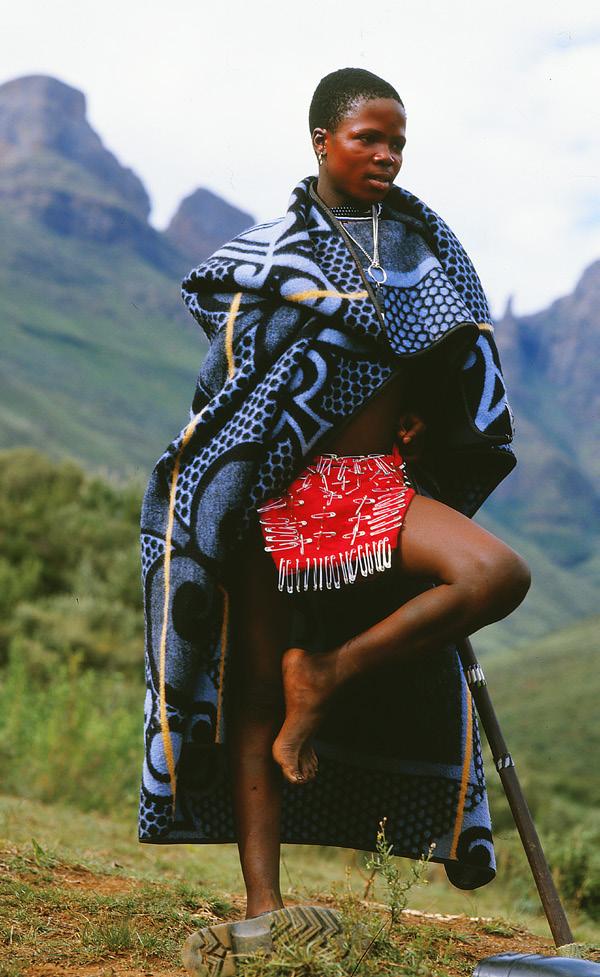
• The Maletsunyane Falls is the highest single drop waterfall in Southern Africa (192 metres).
• It is also the highest commercial abseiling cliff in the world (206 metres).
• Lesotho’s monarchy is the highlight of our culture and a major draw card. Being one the last three monarchs in the world to-day, this by itself is an attraction that if properly packaged and marketed can generate enormous interest from innovative entrepreneurs.
• Afriski Mountain Resort is an ‘all year, all mountain’ destination in the heart of the Drakensberg- Maluti Mountains, in Lesotho. It is one of two ski resorts in Southern Africa and attracts ten thousand visitors over the winter season each year. The highest Ski Resort in Africa.
OT: Are you optimistic about the future of the tourism industry of Lesotho?


SR: The reality is that tourism has been hard hit by this pandemic and when it restarts, it will be under new operating procedure and protocols,
including different travel restrictions that will be or are already being applied by many countries, which will most probably influence travellers’ behaviour and decisions. As the industry starts to reopen, we might note shorter booking windows and less spends and more but it is not all doom and gloom because with the current work on rebuilding tourism in Lesotho, which includes getting the stakeholders to understand what has changed and what will be the best direction for the industry to grow even better, we are optimistic that soon enough, tourism in Lesotho will regain its position or become even better, through new found appreciation from the world.
www.visitlesotho.travel
The Palace Hotel is a prime stay based in the country less than an hour drive from the capital Maseru. Sporting a tranquil pool and a stunning surrounding landscape, the Palace Hotel is a place of leisure, and provides the opportunity for exploration. The hotel’s fine dining experience allows visitors to indulge in a variety of dishes, and its open-plan courtyard provides a social and friendly environment when relaxing beside the pool or in the sunny gardens.


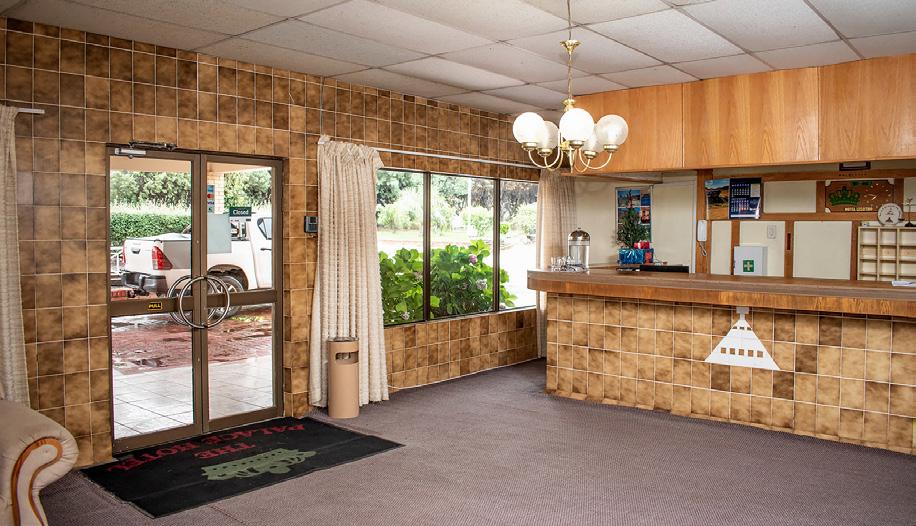


Relaxation and Tranquility

Speaks of relaxation and tranquillity. With spacious suites and bedrooms designed for comfort, it’s perfect for families, couples or businessmen and woman. It’s sometimes difficult to accept that you’re in the middle of bustling Berea when your views consist of lush forest and the sparkling tranquillity of the swimming pool. The pool wraps around the outdoor entertainment area and stylish, thatched pool bar, forming the perfect location where you can take some time or your family. In terms of the conference venues Lesotho has to offer, the palace hotel conference facilities provide one of the largest and the best equipped in Berea.






LANDMARK ATTRACTIONS
MALETSUNYANE FALLS
192 metres of waterfall standing near the town of Semonkong, Maletsunyane Falls is a must-see for visitors of the region. Carved into the cliff beside two vivid green hills, the waterfall is a breath-taking sight to behold, and its dramatic echoing sound has given rise to local folklore that lives to this day.

KOME CAVES
Sitting in the district of Berea, the Kome Caves are a national heritage site in Lesotho, and home to the descendants of those who originally made the caves. The dwellings mix classic living methods with that of modern and provide visitors with an excellent insight into the traditional community that make the caves their home.
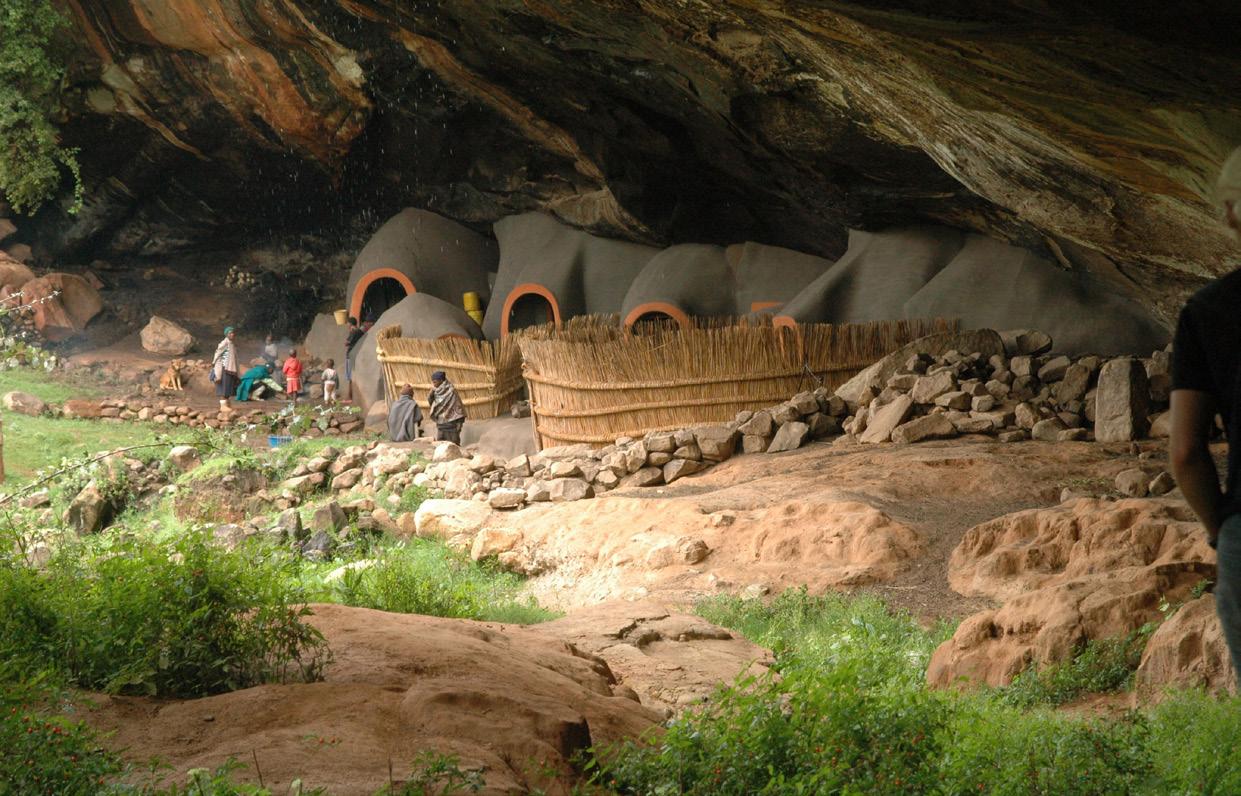
THE LION ROCK MOUNTAIN
The perfect stop during a journey out of Maseru. The Lion Rock Mountain is a lone peak that has retained its wilderness within the borders of the capital, set aside from development in nearby areas. The summit sports a great stone formation from which the rise gets its name and is a brilliant landmark to visit while on the road between the locations.
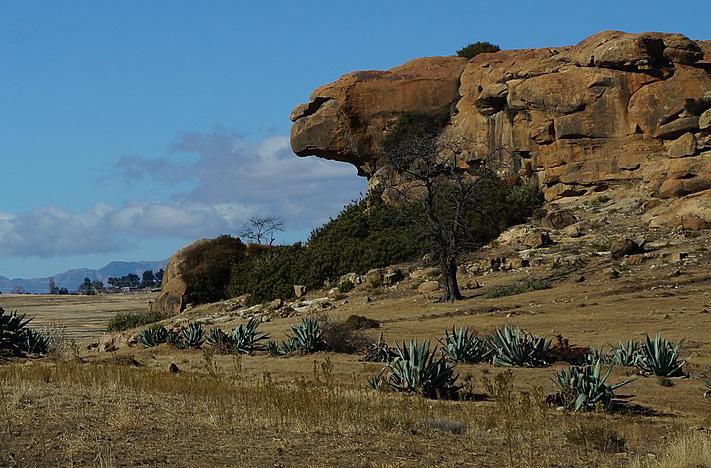
GETTING THERE AND AROUND
LESOTHO IS HOME to a variety of airfields all around the mountainous country. Its primary airport is Moshoeshoe I International Airport just outside of the capital Maseru.




For journeys across the country, taxis are available and well-placed for short journeys outside a
timetable, as well as a range of bus services that routinely journey to popular tourist destinations. Alternatively, for a more custom travelling experience visitors can rent cars from the capital and make their way to the various and unique locations Lesotho has to offer.
 PHOTO
PHOTO
THE ARMCHAIR TRAVELLER
Written by: Phoebe HarperALONG WITH MOST of the population, my ‘travelling’ for the past few months has been taken entirely from the comfort of my armchair, mug of the tea at the ready, seeking escapism on the television screen, online or in the pages of a book. With stringent travel restrictions looming overhead and closed borders at practically every turn, in the Covidage, the armchair traveller is king.
The everyday culture that we consume at home seems intended to mould our wanderlust appetites, in a way that will sensibly recalibrate our travel behaviours to suit the context of this global pandemic. Now more than ever, we are being encouraged to look to our very own British Isles for future holidays. It seems that we are set to become a nation of committed ‘staycationers’, with Cornwall being targeted as the new ultimate holiday destination – Matt Hancock will be taking his summer holidays there, not to mention the gathering of world leaders set to descend on Carbis Bay near St. Ives for the G7 summit this August.
Costa-del-Cornwall is also featuring on our screens as Julia Bradbury blows the trumpet for suitably sustainable slow travel, with her ITV series Cornwall and Devon Walks. Admittedly, her picturesque routes from Dartmoor to Land’s End, are sufficient persuasion to visit this stunning part of the UK. Along with our allotted daily walks, we are discovering a renewed appreciation for our local surroundings, in both the wider and more immediate sense.

On a similar note, Netflix’s hugely
popular series Bridgerton, forecasted by the streaming channel to have reached over 63 million households within the first four weeks of release, showcases some of the UK’s finest country houses and stately homes, leaving me lusting after a National Trust membership. The stunning backdrop of Castle Howard, Hertfordshire’s Hatfield House and the honey-coloured hues of Bath appear extremely inviting and will no doubt boost visitor numbers as soon as lockdown restrictions ease.
‘Edutainment’ has also become a television genre of its own, as David Attenborough continues to fight the good fight for the preservation of our world, demonstrating the perils of climate change in BBC iPlayer’s A Perfect Planet. Proclaiming the detrimental effects of increasing levels of CO2 in the atmosphere, viewers are alerted to our harmful consumption of fossil fuels and the impact of our individual carbon footprints, something that aviation
 Carbis Bay, Cornwall
Carbis Bay, Cornwall
significantly contributes to. We can take comfort in the fact that by staying at home, our impact is minimised, while the natural world is left to regenerate. Arguably, this has been the most uplifting take from the temporarily decreased mobilisation of the human race.
Meanwhile, BBC iPlayer’s chilling series The Serpent serves as quite an effective deterrent for our younger generation of would-be backpackers and gap year trippers.
But for those truly yearning to escape their own living rooms, there is always the possibility of doing so virtually. Virtual touring website, Virtualtrips is a fantastic alternative to quench the thirst of avid travellers. I spoke with Virtualtrips CEO and founder John Tertan to get an understanding of what makes his business so popular. “For me, Virtualtrips is about bringing the world closer together. For thousands of people, going on our live-streams is the highlight of their day because they’re an incredibly social and immersive experience - it makes you feel part of a global community that is curious, positive and friendly.” Offering tours from Tokyo to Tel Aviv led by licensed local guides who are financially supported by tip payments when you make a booking, the site has met with a fantastic reception, recently enjoying “stellar growth”. As Tertan informs me, on an average week, attendees on Virtualtrips tours amount to more than 10,000 people. That number continues to grow exponentially. “Our live-streaming technology is customised for live touring and makes it really easy for individuals or organisations to share the places they know best,” adds Tertan. It is perhaps unsurprising that the site has met such a great response, with over 17,000 reviews averaging 4.7/5 stars across their tours, rated on both the experience and technology. Enjoy unencumbered travel to far flung corners of the globe without any of the
hassle of pre-departure PCR testing and enforced hotel quarantines. Although worldwide travel is on standby for now, we must not lose sight of the fact that the world needs tourism, whatever that may look like as the travel industry calibrates to the ‘new normal’. Our appetites as travellers should not diminish and there is hope going forward – you only have to sit through one advert break to encounter hopeful promises
of summer holidays to come and new beginnings from the likes of TUI and On the Beach.

So, in the meantime, inspiration and a virtual kind of travel is there if we seek it. All great trips take great planning so we should use this time to our advantage, whilst rethinking how we travel in the responsible way that the present world demands.
An armchair seems like the most comfortable place to do it.
“FOR ME, VIRTUALTRIPS IS ABOUT BRINGING THE WORLD CLOSER TOGETHER. FOR THOUSANDS OF PEOPLE, GOING ON OUR LIVE-STREAMS IS THE HIGHLIGHT OF THEIR DAY BECAUSE THEY’RE AN INCREDIBLY SOCIAL AND IMMERSIVE EXPERIENCE...”
ANDRAVONA, MADAGASCAR THE LAST STOP.
Like much of Madagascar, the real population figures of the surrounding area of Andravona are unknown since much of the population is unregistered. The elusive Mikea tribe dwell in the forests behind the resort, a people that allegedly descend from the spirits of the forest.

TYPE ANDRAVONA INTO Google Maps, and it will come back with no results. For those seeking a remote getaway, that is a good place to start. A white sand outpost on the southwestern coast of Madagascar, Andravona is largely defined by the Mikea Lodge. The lodge is a destination in itself, comprising a series of 50 beachfront bungalows that offer a high standard of accommodation in Madagascar’s answer to paradise.
Excursions are available in the lodge’s 1970s Land Rover into the forest for a fascinating encounter with one of the few hunter-gatherer tribes remaining in the world. Nearby villages are the domain of the Vezo fisherman, a nomadic people who follow the fish and build boats along the way using age old traditions. Making their livelihood entirely from the sea, at sunrise you will see their pointed handmade canoes, or pirogues, drifting across the water, often accompanied with chanting sea shantys.
Positioned on sloping sandbanks directly opposite a clear blue lagoon, with the Mozambique Channel on the horizon, Andravona’s sole lodge is a far quieter option than the popular coastal resort towns such as Ifaty to the south. There is nothing better than feasting on the catch of the day and listening to tales of the Portuguese shipwrecks that litter
this coastline, making it a superb diving destination. The third largest coral reef in the world is within short distance, protected by the marine reserve of Mamirano Bay. This is also an excellent spot for whale-watching compared to the much busier Nosy Be in the North, with pods of humpbacks visiting these quiet shores to mate from June to August. Here, you have unspoilt front row seats. For marine life enthusiasts, nearby coastal hamlets host admirable conservation projects, dedicated to the protection of sea grasses and local underwater life. This includes Blue Ventures in nearby Andavadoaka.
As with any remote location, Andravona requires a somewhat arduous journey ploughing through the sand by 4x4, but you will reap the rewards when you are met with an expanse of beach, sand that could rival icing sugar and an ocean of sparkling turquoise. This is escapism at its finest. Due to Madagascar’s extreme hurricane season, visits to Andravona are only possible from May through to August. Private charter flights the island’s capital of Antananarivo may provide a more comfortable alternative. As soon as you can, dust off that passport.

Barbados has told its story...

IN A CHANGING WORLD , where the travel industry must adapt to challenging global situations, our mission at Outlook Travel remains the same. We will continue to showcase some of the world’s most inspiring destinations, offering real insight and comprehensive travel guides for when global mobility resumes.
The major component of the publication takes the form of our Outlook Travel Guides, providing executives, avid travellers and our existing 575,000 international subscribers with the ultimate rundown of all the major economic drivers and thriving hubs across the world, with exclusive input from tourism industry associations and stakeholders – the people who know these places the best.
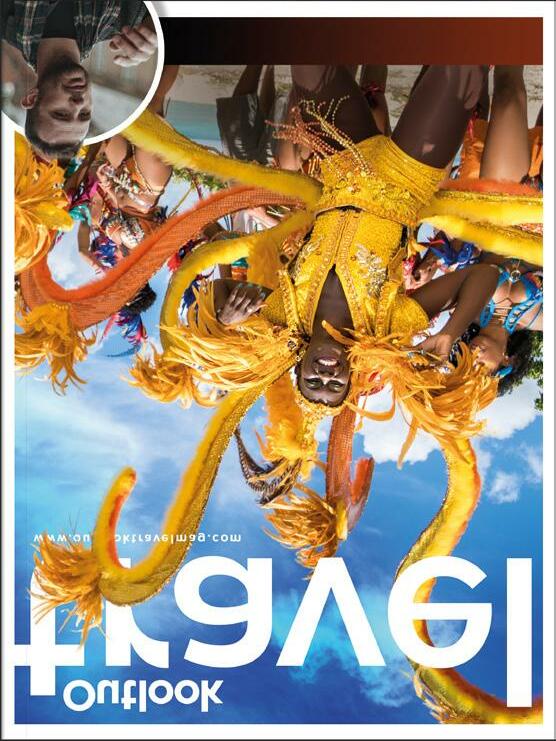

You can join the vast numbers of tourism sector players enjoying the exposure we provide across our digital and print platforms with a range of options, from advertising through to free-of-charge editorials, extensive social media saturation, enhanced B2B networking opportunities, and a readymade forum to attract new investment and increase exposure.
For further information, visit www.outlooktravelmag.com
IT’S







































Situated in the heart of Menlyn Maine, The Maslow Time Square is Sun International’s 238-room specialist business hotel. Not only a destination for professionals, but a portal for travellers. Boasting 17 floors that o er everything from business to leisure with tempting eateries, a relaxing business lounge and 13 bespoke conference rooms.









For the perfect balance of business and pleasure, be our guest.















